Cisco Systems DX6500736 CP-DX650 User Manual
Cisco Systems Inc CP-DX650
Contents
- 1. Regulatory Compliance Info
- 2. Users Guide
- 3. User Guide
User Guide

Cisco Desktop Collaboration Experience DX600 Series User Guide,
Release 10.0(1)
First Published: February 15, 2013
Americas Headquarters
Cisco Systems, Inc.
170 West Tasman Drive
San Jose, CA 95134-1706
USA
http://www.cisco.com
Tel: 408 526-4000
800 553-NETS (6387)
Fax: 408 527-0883
Text Part Number: OL-28931-01

THE SPECIFICATIONS AND INFORMATION REGARDING THE PRODUCTS IN THIS MANUAL ARE SUBJECT TO CHANGE WITHOUT NOTICE. ALL STATEMENTS,
INFORMATION, AND RECOMMENDATIONS IN THIS MANUAL ARE BELIEVED TO BE ACCURATE BUT ARE PRESENTED WITHOUT WARRANTY OF ANY KIND,
EXPRESS OR IMPLIED. USERS MUST TAKE FULL RESPONSIBILITY FOR THEIR APPLICATION OF ANY PRODUCTS.
THE SOFTWARE LICENSE AND LIMITED WARRANTY FOR THE ACCOMPANYING PRODUCT ARE SET FORTH IN THE INFORMATION PACKET THAT SHIPPED WITH
THE PRODUCT AND ARE INCORPORATED HEREIN BY THIS REFERENCE. IF YOU ARE UNABLE TO LOCATE THE SOFTWARE LICENSE OR LIMITED WARRANTY,
CONTACT YOUR CISCO REPRESENTATIVE FOR A COPY.
The following information is for FCC compliance of Class A devices: This equipment has been tested and found to comply with the limits for a Class A digital device, pursuant to part 15
of the FCC rules. These limits are designed to provide reasonable protection against harmful interference when the equipment is operated in a commercial environment. This equipment
generates, uses, and can radiate radio-frequency energy and, if not installed and used in accordance with the instruction manual, may cause harmful interference to radio communications.
Operation of this equipment in a residential area is likely to cause harmful interference, in which case users will be required to correct the interference at their own expense.
The following information is for FCC compliance of Class B devices: This equipment has been tested and found to comply with the limits for a Class B digital device, pursuant to part 15
of the FCC rules. These limits are designed to provide reasonable protection against harmful interference in a residential installation. This equipment generates, uses and can radiate radio
frequency energy and, if not installed and used in accordance with the instructions, may cause harmful interference to radio communications. However, there is no guarantee that interference
will not occur in a particular installation. If the equipment causes interference to radio or television reception, which can be determined by turning the equipment off and on, users are
encouraged to try to correct the interference by using one or more of the following measures:
•Reorient or relocate the receiving antenna.
•Increase the separation between the equipment and receiver.
•Connect the equipment into an outlet on a circuit different from that to which the receiver is connected.
•Consult the dealer or an experienced radio/TV technician for help.
Modifications to this product not authorized by Cisco could void the FCC approval and negate your authority to operate the product
The Cisco implementation of TCP header compression is an adaptation of a program developed by the University of California, Berkeley (UCB) as part of UCB’s public domain version
of the UNIX operating system. All rights reserved. Copyright ©1981, Regents of the University of California.
NOTWITHSTANDING ANY OTHER WARRANTY HEREIN, ALL DOCUMENT FILES AND SOFTWARE OF THESE SUPPLIERS ARE PROVIDED "AS IS" WITH ALL FAULTS.
CISCO AND THE ABOVE-NAMED SUPPLIERS DISCLAIM ALL WARRANTIES, EXPRESSED OR IMPLIED, INCLUDING, WITHOUT LIMITATION, THOSE OF
MERCHANTABILITY, FITNESS FOR A PARTICULAR PURPOSE AND NONINFRINGEMENT OR ARISING FROM A COURSE OF DEALING, USAGE, OR TRADE PRACTICE.
IN NO EVENT SHALL CISCO OR ITS SUPPLIERS BE LIABLE FOR ANY INDIRECT, SPECIAL, CONSEQUENTIAL, OR INCIDENTAL DAMAGES, INCLUDING, WITHOUT
LIMITATION, LOST PROFITS OR LOSS OR DAMAGE TO DATA ARISING OUT OF THE USE OR INABILITY TO USE THIS MANUAL, EVEN IF CISCO OR ITS SUPPLIERS
HAVE BEEN ADVISED OF THE POSSIBILITY OF SUCH DAMAGES.
Cisco and the Cisco logo are trademarks or registered trademarks of Cisco and/or its affiliates in the U.S. and other countries. To view a list of Cisco trademarks, go to this URL: http://
www.cisco.com/go/trademarks. Third-party trademarks mentioned are the property of their respective owners. The use of the word partner does not imply a partnership
relationship between Cisco and any other company. (1110R)
Any Internet Protocol (IP) addresses used in this document are not intended to be actual addresses. Any examples, command display output, and figures included in the document are shown
for illustrative purposes only. Any use of actual IP addresses in illustrative content is unintentional and coincidental.
Cisco and the Cisco logo are trademarks or registered trademarks of Cisco and/or its affiliates in the U.S. and other countries. To view a list of Cisco trademarks, go to this URL: http://
www.cisco.com/go/trademarks. Third-party trademarks mentioned are the property of their respective owners. The use of the word partner does not imply a partnership
relationship between Cisco and any other company. (1110R)
The Bluetooth word mark and logo are registered trademarks owned by Bluetooth SIG, Inc., and any use of such marks by Cisco Systems, Inc., is under license.
Google, Google Play, Android and certain other marks are trademarks of Google Inc.
©2013 Cisco Systems, Inc. All rights reserved.

CONTENTS
CHAPTER 1
Preface 1
Guide organization 1
Related documentation 1
Additional information 2
Obtaining documentation and submitting service request 2
CHAPTER 2
Phone features 3
Buttons and hardware 3
Cisco Desktop Collaboration Experience DX650 buttons and hardware 3
Phone cable installation 5
Hookswitch clip removal 5
TAPS registration 6
Handset 6
Headset 6
Headset support 7
Audio quality 7
3.5 mm headsets 7
Wireless headset 7
Speakerphone 8
AutoAnswer with headset or speakerphone 8
Phone cable lock 9
Line and call definitions 9
Line and call icons 9
Energy savings 10
Android 10
Gestures 11
Lock screen 11
Unlock screen 12
Cisco Desktop Collaboration Experience DX600 Series User Guide, Release 10.0(1)
OL-28931-01 iii

Place emergency call from Lock screen 12
Add PIN 12
Add password 12
Reset lost PIN or password 13
Awake to Phone application 13
Cisco Extension Mobility 14
Sign In to Extension Mobility from Lock screen 14
Sign in to Extension Mobility from Settings 15
Sign Out of Extension Mobility from Lock screen 15
Sign Out of Extension Mobility from Settings 15
Set screen timeout 16
Setup Assistant 16
Run Setup Assistant 16
Home screen 17
Status bar 17
Navigation icons 17
Applications menu 17
Work spaces 17
Navigate work spaces 18
Widgets 18
Set up home screen 18
Add application icon to home screen 19
Add widget to home screen 19
Move widget or icon 19
Remove widget or icon 19
Change wallpaper 20
Quick Contact Badge 20
Share menu 20
On-screen keyboard 20
Cleaning and maintenance 21
CHAPTER 3
Calling tasks 23
Common call tasks 23
Answer call 23
Disconnect call 24
Cisco Desktop Collaboration Experience DX600 Series User Guide, Release 10.0(1)
iv OL-28931-01
Contents

Hold and resume 25
Put call on hold 26
Remove call from hold on different line 26
Mute 26
Mute or unmute call 26
Place call 27
Place call with headset 27
Place call with speakerphone 27
Place call when another call is active 27
Redial number 28
Video calls 28
Video call control bar 28
Stop your video transmission 28
Automatic video transmission 28
Stop automatic video transmission 29
Adjust video call settings 29
Self-video 29
Show self-video 29
Visual Voicemail 29
Set up Visual Voicemail 30
Listen to voice message 30
View voice message details 30
Reply to voice message 30
Forward voice message 31
Delete voice message 31
Advanced call tasks 31
Business calls with single phone number 31
Mobile Connect and Mobile Voice Access 32
Put call picked up on mobile phone on hold 33
Connect to Mobile Voice Access 33
Turn on Mobile Connect from mobile phone 33
Turn off Mobile Connect from mobile phone 34
Turn on or off Mobile Connect access to all remote destinations from desk phone 34
Conference calls 34
Ad hoc conference 34
Cisco Desktop Collaboration Experience DX600 Series User Guide, Release 10.0(1)
OL-28931-01 v
Contents

Call participants to create conference 35
Add contacts to conference 35
Join conference 35
Join together existing calls on single phone line 36
Join together existing calls on multiple phone lines 36
Barge conference 36
Barge call on shared line to create conference 36
Meet Me conference 36
Start Meet Me conference 37
Join Meet Me conference 37
Conference participants list 37
Control conference with participants list 37
Call forward 38
Set up and cancel Call Forward All from phone 39
Set up or cancel call forwarding 39
Call Park 39
Store and retrieve active call with Call Park 40
Direct and store active call at Directed Call Park number 40
Retrieve parked call from Directed Call Park number 40
Direct, store, and retrieve active call at Assisted Directed Call Park number 40
Call Pickup 41
Answer call ringing on another extension within Call Pickup group 41
Answer call ringing on another extension outside Call Pickup group 41
Answer call ringing on another extension in group or in associated group 42
Answer call ringing on particular extension 42
Call transfer 42
Transfer call without talking to transfer recipient 43
Talk to transfer recipient before transferring call 43
Call transfer to voice message system 43
Send active, ringing, or held call to voice message system 44
Dial from corporate directory on personal computer using Cisco Web Dialer 44
Notify when busy or ringing extension available 44
Dial from corporate directory on phone 45
Do Not Disturb 45
Turn DND on and off 45
Cisco Desktop Collaboration Experience DX600 Series User Guide, Release 10.0(1)
vi OL-28931-01
Contents

Set up DND settings 45
Hunt groups 46
Sign in and out of hunt groups 46
Active call movement 46
Switch active call on desk phone to mobile phone 47
Switch active call from mobile phone to desk phone 47
Switch active call from mobile phone to desk phone that shares same line 47
Intercom calls 47
Place intercom call to preconfigured intercom number 48
Place intercom call to any intercom number 48
Receive intercom call 49
Line status features 49
Use line status pickup to answer ringing call 50
Make call from mobile phone using mobile voice access 50
Multiple calls 50
Switch between calls on one line 51
Switch between calls on different lines 51
Switch from active call to answer ringing call 51
Remove call from hold on current line 51
Place call while another call is active (using different line) 52
Secure calls 52
VPN client 53
Shared lines 54
Remote-in-use icon 54
Call information and Barge 54
Barge, cBarge, and shared lines 54
Single-button and multitouch Barge 54
Barge features 55
Privacy and shared lines 55
Prevent and allow others to view or barge calls on shared line 56
Speed Dial 56
Make call using Speed-Dial button 56
Make call using on-hook abbreviated dial 57
Suspicious call trace 57
Notify system administrator about suspicious or harassing call 57
Cisco Desktop Collaboration Experience DX600 Series User Guide, Release 10.0(1)
OL-28931-01 vii
Contents

CHAPTER 4
Phone customization and settings 59
Rings and message indicator customization 59
Change ringtone 60
Adjust phone ringer volume level 60
Change ring pattern 60
Change audible voice-message indicator 61
Change how voice message light on handset works 61
Phone screen customization 61
Change phone screen language 61
Change phone screen brightness 62
Change line text label 62
Networks 62
Wired network connection 62
Connect to wired network 63
Share wired network connection with computer 63
Connect to wireless network 63
Connect to hidden wireless network 63
Edit wireless network 64
Delete wireless network 64
Supported wireless security 64
Web proxy 64
Add web proxy 65
Edit web proxy 65
Delete web proxy 66
TFTP 66
Connect to TFTP Server 66
AnyConnect VPN 66
AutoNetDetect 67
Password persistence 67
Add VPN connection profile 67
Edit VPN connection profile 67
Connect to VPN 68
Disconnect from VPN 68
Delete VPN connection profile 69
Cisco Desktop Collaboration Experience DX600 Series User Guide, Release 10.0(1)
viii OL-28931-01
Contents

CHAPTER 5
User Options web pages 71
User Options web page actions 71
Sign in and out of User Options web pages 71
Select device from User Options web page 72
Select configuration option 72
Features and services setup on web 72
Speed Dial setup on web 72
Set up speed-dial buttons 73
Set up abbreviated dialing codes 73
Phone services setup on web 73
Subscribe to service 74
Search for services 74
Change or end services 74
Change service name 75
Add service to programmable feature button 75
User settings on web 75
Change browser password 76
Change PIN 76
Change User Options web page language setting 76
Change phone display language 77
Line settings on web 77
Set up call forward for each line 77
Change voice message indicator setting for each line 78
Change audible voice message indicator setting for each line 78
Change or create line text label that appears on phone screen 79
Set up phone and access list for Mobile Connect 79
Create access list 79
Add new remote destination 80
Cisco Web Dialer 81
Use WebDialer with User Options directory 81
Use WebDialer with another online corporate directory 81
Log out of WebDialer 82
Set up, view, or change Web Dialer preferences 82
Cisco Desktop Collaboration Experience DX600 Series User Guide, Release 10.0(1)
OL-28931-01 ix
Contents

CHAPTER 6
Applications 83
Calendar 83
Calendar account 83
Add calendar account 84
Add calendar event 84
Edit event 84
Delete event 85
Start scheduled WebEx meeting 85
Join scheduled WebEx meeting 85
Settings 85
Hide declined events 86
Set alerts and notifications 86
Select ringtone 86
Edit vibrate settings 87
Set default reminder time 87
Calendar widget 87
Contacts 87
Contact details 87
View recent activity 88
Add contact 88
Edit contact 88
Remove contact 88
Join contacts 89
Share contact 89
Favorites 89
Mark contact as favorite 89
Groups 89
Add group 90
Delete group 90
Add contact to group 90
Edit group 91
Search 91
Search your contacts 91
Import contacts 92
Cisco Desktop Collaboration Experience DX600 Series User Guide, Release 10.0(1)
xOL-28931-01
Contents

Export contacts 92
Set display options 92
Availability 92
Email 93
Settings 93
Add email account 93
Inbox 93
Refresh inbox 94
Sort mailbox 94
Search email messages 94
Send email message 94
Save email message draft 95
Reply to email message 95
Forward email message 95
Add attachment to email message 95
Add CC or BCC recipient 96
Delete email message 96
Delete multiple email messages 96
Delete folder 96
Move email message 97
Mark email message as favorite 97
Mark multiple email messages as favorites 97
Mark email message as new 97
Mark multiple email messages as new 98
Search email messages 98
Set sorting options 98
Add signature to email messages 99
Digitally signed email messages 99
Set email check frequency 99
Reset email account password 99
Select ringtone 100
Edit vibrate settings 100
Jabber IM 100
Jabber IM account 100
Add Jabber IM account 100
Cisco Desktop Collaboration Experience DX600 Series User Guide, Release 10.0(1)
OL-28931-01 xi
Contents

Signing in 101
Availability 101
Add custom status 101
Delete custom status 102
Contacts 102
Add Chat contact 102
Contact requests 102
View contact requests 103
Remove chat contact 103
Show offline contacts 103
Unsynced contacts 103
Add unsynced contact to chat contacts 104
Conversations 104
Start conversation 104
Emoticons 104
Insert emoticon into conversation 104
End conversation 104
Search 105
Start conversation with search result 105
Settings 105
Enable audio and vibration notifications 105
Enable status bar notifications 105
Set profile photo 106
Set your ringtone 106
Sign out of Jabber IM 106
Unified Inbox 106
View communications with contact 107
Search contact list 107
View email message 107
View visual voice message 107
Play visual voice message 107
Reply to visual voice message 108
View event details 108
Join WebEx meeting 108
Reorder panels 108
Cisco Desktop Collaboration Experience DX600 Series User Guide, Release 10.0(1)
xii OL-28931-01
Contents

Refresh application data 108
Unified Inbox widget 109
WebEx 109
Sign in to WebEx 109
Sign in to WebEx with single sign-on 109
Start instant WebEx meeting 110
Schedule new WebEx meeting 110
Start scheduled WebEx meeting 110
Join scheduled WebEx meeting 110
Join WebEx meeting by meeting number 111
View participant list 111
Chat with participant 111
Chat with everyone 111
Invite more participants to WebEx meeting 112
Invite more participants during WebEx meeting 112
Show video during WebEx meeting 112
WebEx widget 112
More applications 112
UCM App 113
Remove application 113
CHAPTER 7
Accessories 115
Bluetooth 115
Enable Bluetooth 116
Scan for Bluetooth device 116
Pair Bluetooth device 116
Unpair Bluetooth device 116
Sharing files 117
View received files 117
Make phone discoverable 117
Set Bluetooth device name 117
External camera 117
External monitor 118
Connect external monitor 118
Switch display mode 118
Cisco Desktop Collaboration Experience DX600 Series User Guide, Release 10.0(1)
OL-28931-01 xiii
Contents

Set monitor orientation 119
Launch application on external monitor 119
Autolaunch application to external monitor 119
Move application to external monitor 120
Move application to phone screen 120
HDCP support 120
Virtual desktop infrastructure 121
USB accessories 121
USB keyboard and mouse 122
VDI shortcuts 122
VDI keyboard shortcuts 122
VDI mouse actions 122
USB memory stick 122
USB-powered hub 123
USB console cable 123
CHAPTER 8
Product safety, security, accessibility, and related information 125
Safety and performance information 125
Power outage 125
Emergency response notification 125
Emergency response notification for phone 126
Emergency response notification for VPN 126
External devices 126
Headset safety 127
Bluetooth wireless headset performance 127
FCC compliance statements 127
FCC part 15.21 statement 127
FCC receivers and class B digital statement 128
CE marking 128
Cryptographic information 128
Data backup 128
Problem Report Tool 129
Report problem 129
Accessibility features 129
Change font size 130
Cisco Desktop Collaboration Experience DX600 Series User Guide, Release 10.0(1)
xiv OL-28931-01
Contents

Cisco Desktop Collaboration Experience DX600 Series User Guide, Release 10.0(1)
xvi OL-28931-01
Contents

CHAPTER 1
Preface
This guide describes the Cisco Desktop Collaboration Experience DX600 Series phone and how to use it.
The audience for this guide is system administrators and users.
•Guide organization, page 1
•Related documentation, page 1
•Additional information, page 2
•Obtaining documentation and submitting service request, page 2
Guide organization
This guide is organized into these topics:
•Phone features, on page 3
•Calling tasks, on page 23
•Phone customization and settings, on page 59
•User Options web pages, on page 71
•Applications, on page 83
•Accessories, on page 115
•Product safety, security, accessibility, and related information, on page 125
Related documentation
See these documents for additional information about Cisco Desktop Collaboration Experience DX600 Series
phones:
•Cisco Desktop Collaboration Experience DX600 Series Administration Guide
•Cisco Desktop Collaboration Experience DX650 Quick Start
•Regulatory Compliance and Safety Information for Cisco Desktop Collaboration Experience DX650
Cisco Desktop Collaboration Experience DX600 Series User Guide, Release 10.0(1)
OL-28931-01 1

•Cisco Desktop Collaboration Experience DX600 Series Release Notes
•Cisco Desktop Collaboration Experience DX600 Series Wireless LAN Deployment Guide
Additional information
You can access the Cisco website at this URL:
http://www.cisco.com
Cisco Desktop Collaboration Experience DX600 Series Quick Start, Administration, Deployment, and User
Guides:
http://www.cisco.com/en/US/products/ps12956/products_user_guide_list.html
Licensing information:
http://www.cisco.com/en/US/docs/general/warranty/English/EU1KEN_.html
Cisco international websites:
Access international Cisco websites from www.cisco.com by clicking the Worldwide link at the top of the
web page.
Obtaining documentation and submitting service request
For information about obtaining documentation, submitting a service request, and gathering additional
information, see the monthly What’s New in Cisco Product Documentation, which also lists all new and revised
Cisco technical documentation, at this URL:
http://www.cisco.com/en/US/docs/general/whatsnew/whatsnew.html
Subscribe to the What’s New in Cisco Product Documentation as a Really Simple Syndication (RSS) feed
and set content to be delivered directly to your desktop using a reader application. The RSS feeds are a free
service and Cisco currently supports RSS Version 2.0.
Cisco Desktop Collaboration Experience DX600 Series User Guide, Release 10.0(1)
2OL-28931-01
Preface
Additional information

CHAPTER 2
Phone features
This chapter outlines the features of the Cisco Desktop Collaboration Experience DX600 Series phones.
•Buttons and hardware, page 3
•Line and call definitions, page 9
•Energy savings, page 10
•Android, page 10
•Cleaning and maintenance, page 21
Buttons and hardware
This section describes the phone buttons and hardware.
Cisco Desktop Collaboration Experience DX650 buttons and hardware
This figure identifies the important parts of the phone.
Cisco Desktop Collaboration Experience DX600 Series User Guide, Release 10.0(1)
OL-28931-01 3
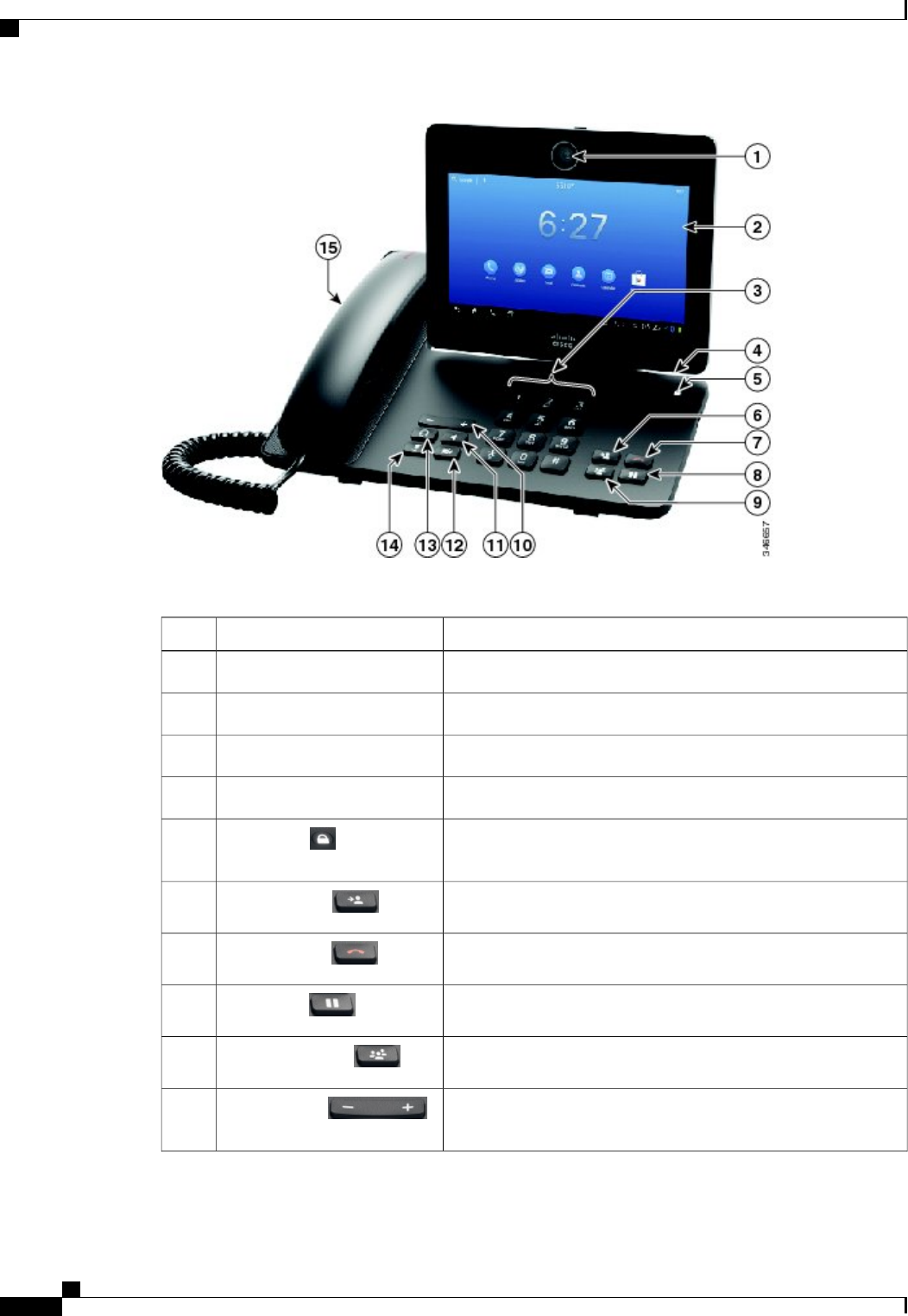
Table 1: Phone buttons and hardware
DescriptionItem
Front-facing camera for video calls.Camera1
Shows phone features.Phone screen2
Allows you to dial phone numbers.Keypad3
Allows you to connect a microSD card.microSD card slot4
Locks the phone screen, restarts the phone, or turns the phone on
and off.
Lock button
5
Transfers a call.
Transfer button
6
Ends a call.
End call button
7
Places a call on hold.
Hold button
8
Creates a conference call.
Conference button
9
Controls the handset, headset, and speakerphone volume (off-hook)
and the ringer volume (on-hook).
Volume button
10
Cisco Desktop Collaboration Experience DX600 Series User Guide, Release 10.0(1)
4OL-28931-01
Phone features
Cisco Desktop Collaboration Experience DX650 buttons and hardware
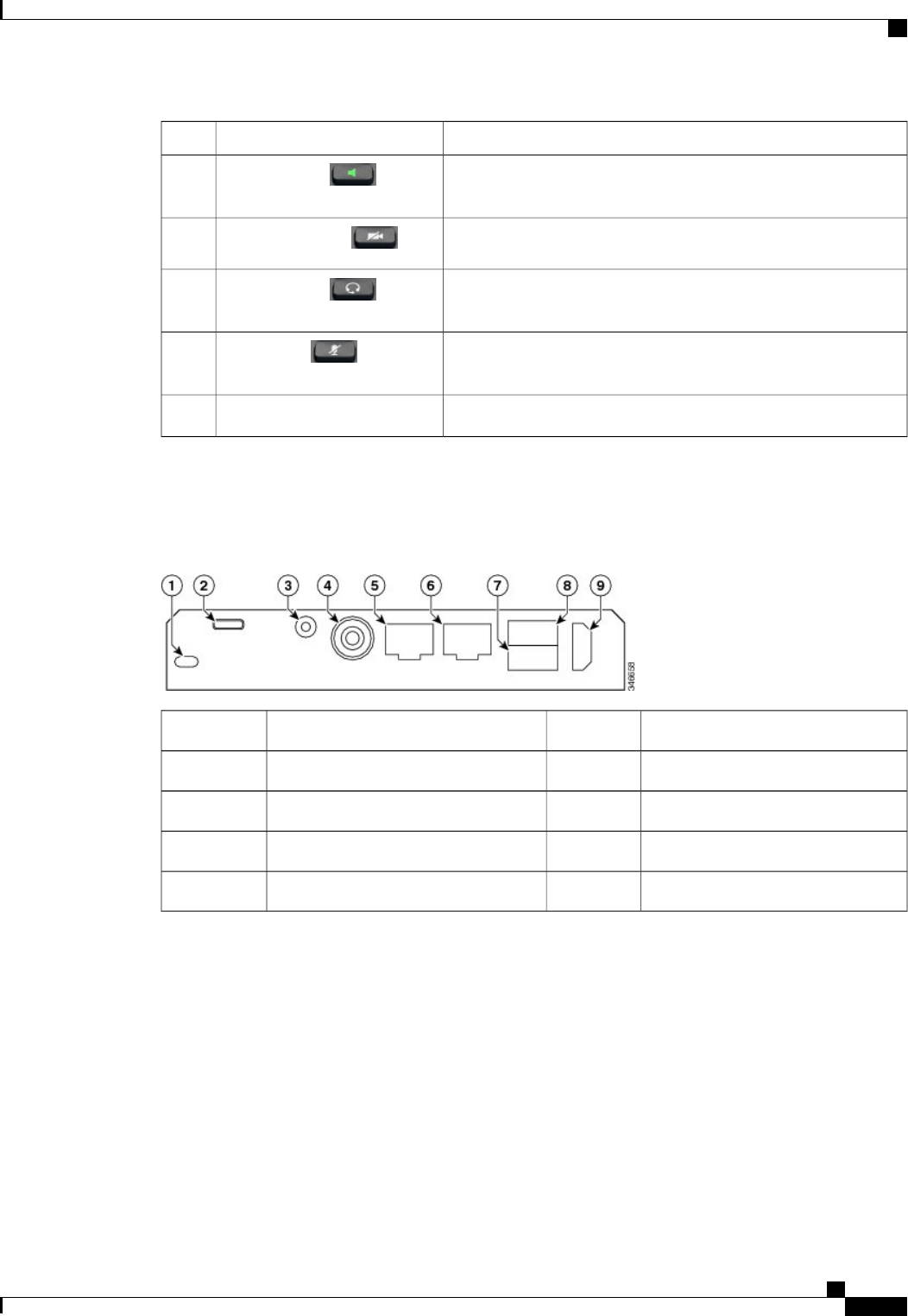
DescriptionItem
Toggles the speakerphone on or off. When the speakerphone is on,
the button is lit.
Speaker button
11
Toggles video on or off. When video is stopped, the button is lit.
Stop Video button
12
Toggles the headset on or off. When the headset is on, the button
is lit.
Headset button
13
Toggles the microphone on or off. When the microphone is muted,
the button is lit.
Mute button
14
Indicates an incoming call or new voice message.Handset with light strip15
Phone cable installation
See the following figure and table to connect your phone.
Computer port6Lock1
Auxiliary port7microUSB port2
Auxiliary port8Line in/out port3
HDMI port9Power port4
Network port5
Hookswitch clip removal
Some phones ship with a clip to secure the hookswitch. Before you use your phone, remove the hookswitch
clip (if present) from the cradle area. With the clip removed, the hookswitch lifts slightly when you pick up
the handset.
Cisco Desktop Collaboration Experience DX600 Series User Guide, Release 10.0(1)
OL-28931-01 5
Phone features
Phone cable installation
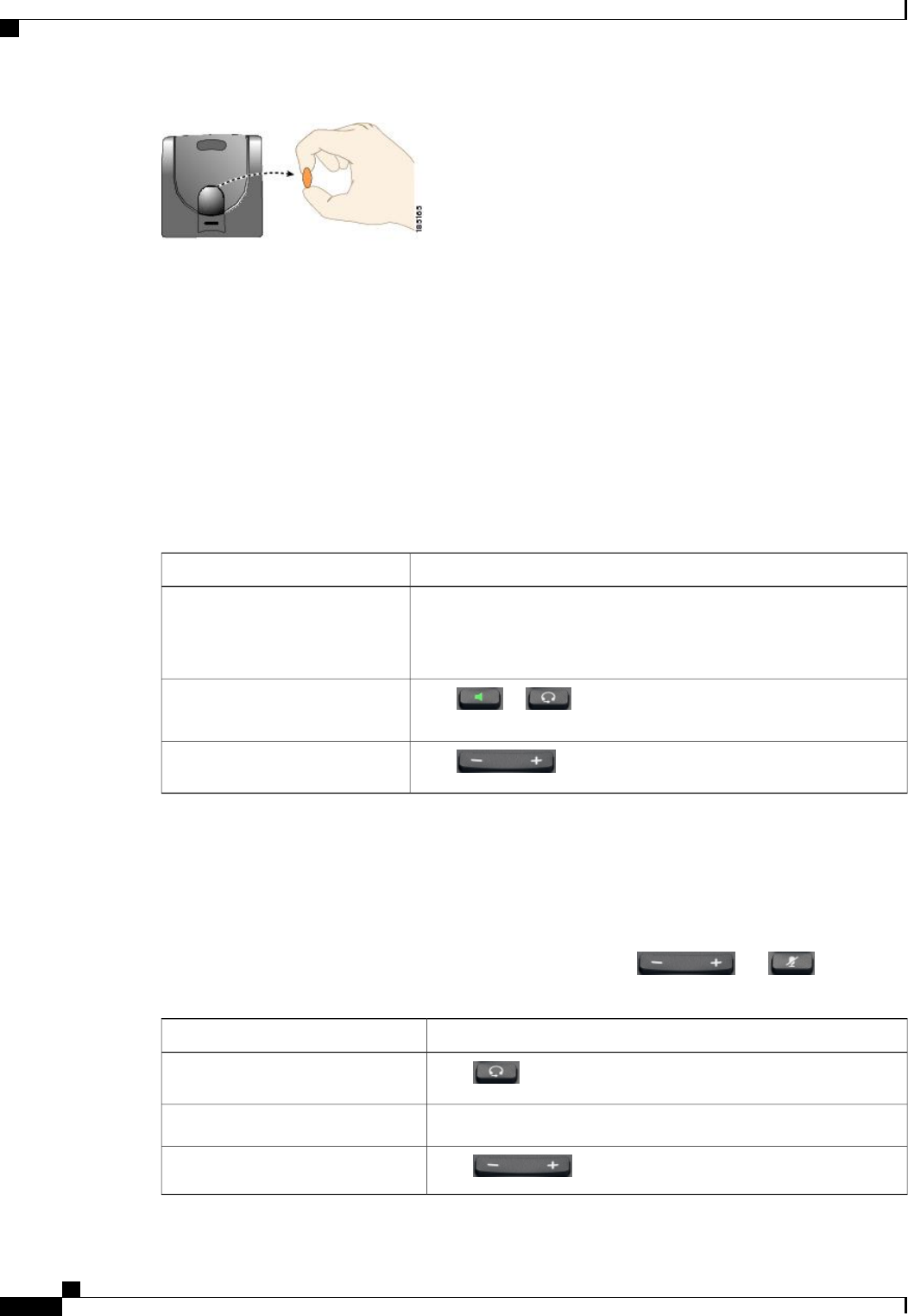
TAPS registration
Tool for Auto-Registered Phones Support (TAPS) is used either for a new phone or to replace an existing
phone. To register with TAPS, pick up the handset, enter the TAPS extension that your system administrator
provides, and follow the voice prompts. You may need to enter your entire extension, including the area code.
After your phone displays a confirmation message, hang up. The phone restarts.
Handset
The following table describes how to use the handset.
Then...If you want to...
Lift it to go off-hook; replace it in the cradle to go on-hook.
The ringing line is selected automatically. Contact your system
administrator for the options to select the primary line each time.
Use the handset
Press or , then hang up the handset.
Switch to the speakerphone or
headset during a call
Press during a call or after invoking a dial tone.
Adjust the volume level for a call
Headset
You can use a wired headset with your phone. You can also use a wireless headset with the wireless headset
remote hookswitch control feature.
You can use a headset with all the controls on your phone, including and .
However, if you use a wireless headset, refer to the wireless headset documentation for instructions.
Then...If you want to...
Press .
Toggle headset mode on and off
Lift the handset.Switch to a handset
Press during a call or after invoking a dial tone.
Adjust the volume level for a call
Cisco Desktop Collaboration Experience DX600 Series User Guide, Release 10.0(1)
6OL-28931-01
Phone features
TAPS registration

If you use AutoAnswer, see AutoAnswer with headset or speakerphone, on page 8.
Headset support
Although Cisco performs limited internal testing of third-party headsets for use with the Cisco DX600 Series
phones, Cisco does not certify or support products from headset (or handset) vendors.
Cisco recommends the use of good-quality headsets that are screened against unwanted radio frequency (RF)
and audio frequency (AF) signals. Depending on the quality of the headsets and their proximity to other
devices such as mobile phones and two-way radios, some audio noise or echo may still occur. An audible
hum or buzz may be heard by either the remote party or by both you and the remote party. A range of outside
sources can cause humming or buzzing sounds : for example, electric lights, electric motors, or large PC
monitors.
In some cases, use of a local power cube or power injector may reduce or eliminate hum.Note
Because of the environmental and hardware inconsistencies in the locations where Cisco DX600 Series phones
are deployed no single headset solution is optimal for all environments.
Cisco recommends that customers test headsets in their intended environment to determine performance before
they make a purchasing decision and deploy on a large scale.
Audio quality
Beyond physical, mechanical, and technical performance, the audio portion of a headset must sound good to
the user and to the party on the far end. Sound quality is subjective and Cisco cannot guarantee the performance
of any headsets. However, a variety of headsets from leading headset manufacturers perform well with Cisco
DX600 Series phones. For details, see the headset documentation.
3.5 mm headsets
You can plug a 3.5 mm headset into the headset port at the back of your phone.
Some headsets may have hardware incompatibilities with the phone, including pinout, microphone voltage,
and device control functionality. Headsets with an incompatible or nonexistent microphone generally can be
used with the phone built-in microphone for voice calls.
Wireless headset
Cisco DX600 Series phones support wireless headsets. Refer to the wireless headset documentation for
information about using the wireless headset remote features. Also, check with your system administrator to
be sure that your phone can use a wireless headset with the wireless headset remote hookswitch control feature.
Cisco Desktop Collaboration Experience DX600 Series User Guide, Release 10.0(1)
OL-28931-01 7
Phone features
Headset
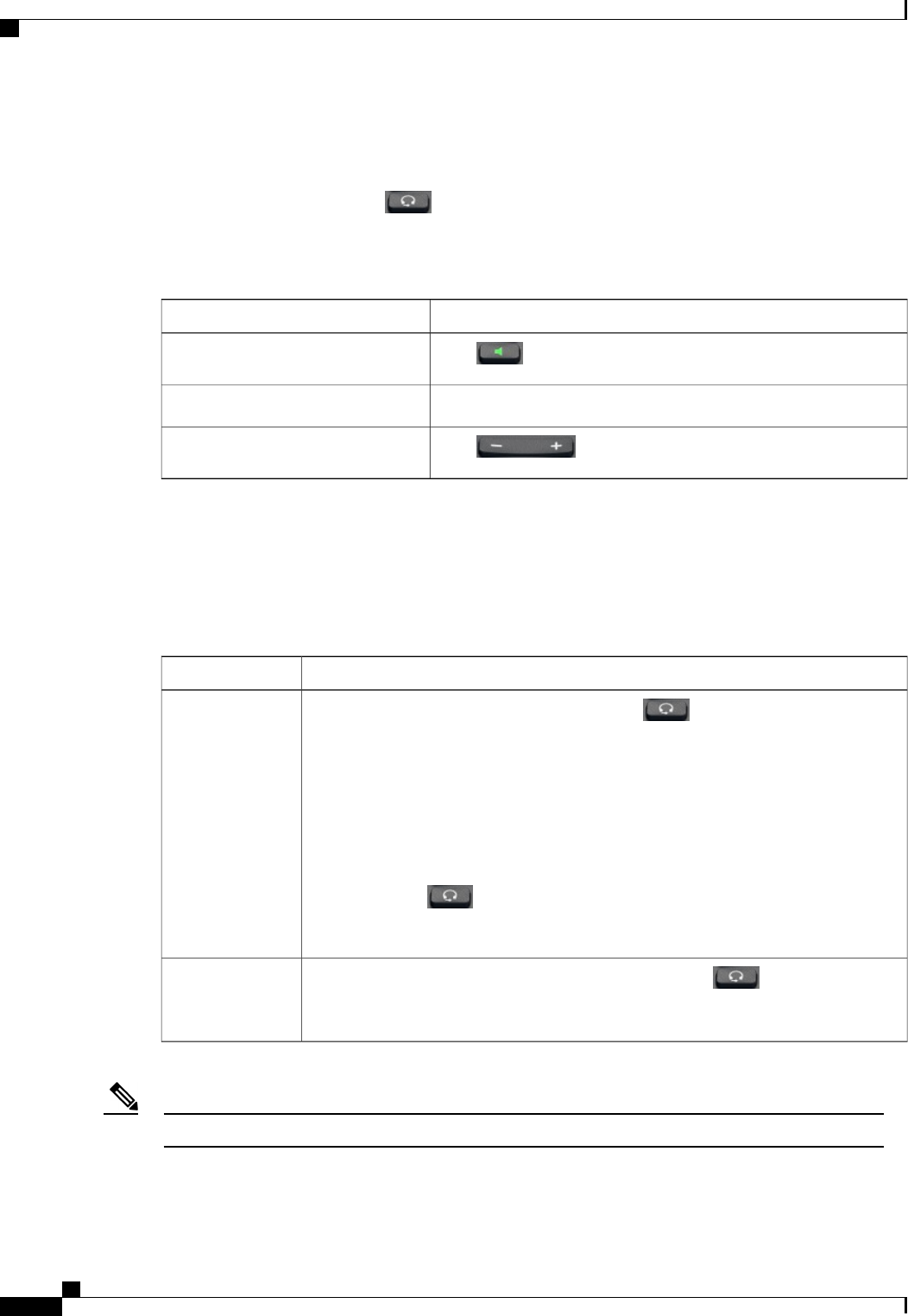
Speakerphone
If the handset is in its cradle and is not lit, many actions that you take to dial a number or answer a call
trigger speakerphone mode automatically.
Speakerphone is unavailable while headphones, or a headset with an incompatible microphone, are plugged
in.
Then...If you want to...
Press .
Toggle speakerphone mode on or off
Lift the handset.Switch to a handset
Press during a call or after invoking a dial tone.
Adjust the volume level for a call
AutoAnswer with headset or speakerphone
When AutoAnswer is enabled, your phone answers incoming calls automatically after a few rings. Your
system administrator configures AutoAnswer to use either the speakerphone or a headset. You may want to
use AutoAnswer if you receive a high volume of incoming calls.
Then...If you...
Keep headset mode active (in other words, keep lit), even when you are not on
a call.
To keep headset mode active, perform the following actions:
•Press EndCall to hang up.
•Press New Call or Dial to place new calls.
If your phone is set up to use AutoAnswer in headset mode, calls are automatically
answered only if is lit.
Otherwise, calls ring normally and you must answer them manually.
Use AutoAnswer
with a headset
Keep the handset in the cradle and headset mode inactive ( unlit).
Otherwise, calls ring normally and you must answer them manually.
Use AutoAnswer
with the
speakerphone
AutoAnswer is disabled when the Do Not Disturb feature is active.Note
Cisco Desktop Collaboration Experience DX600 Series User Guide, Release 10.0(1)
8OL-28931-01
Phone features
Speakerphone
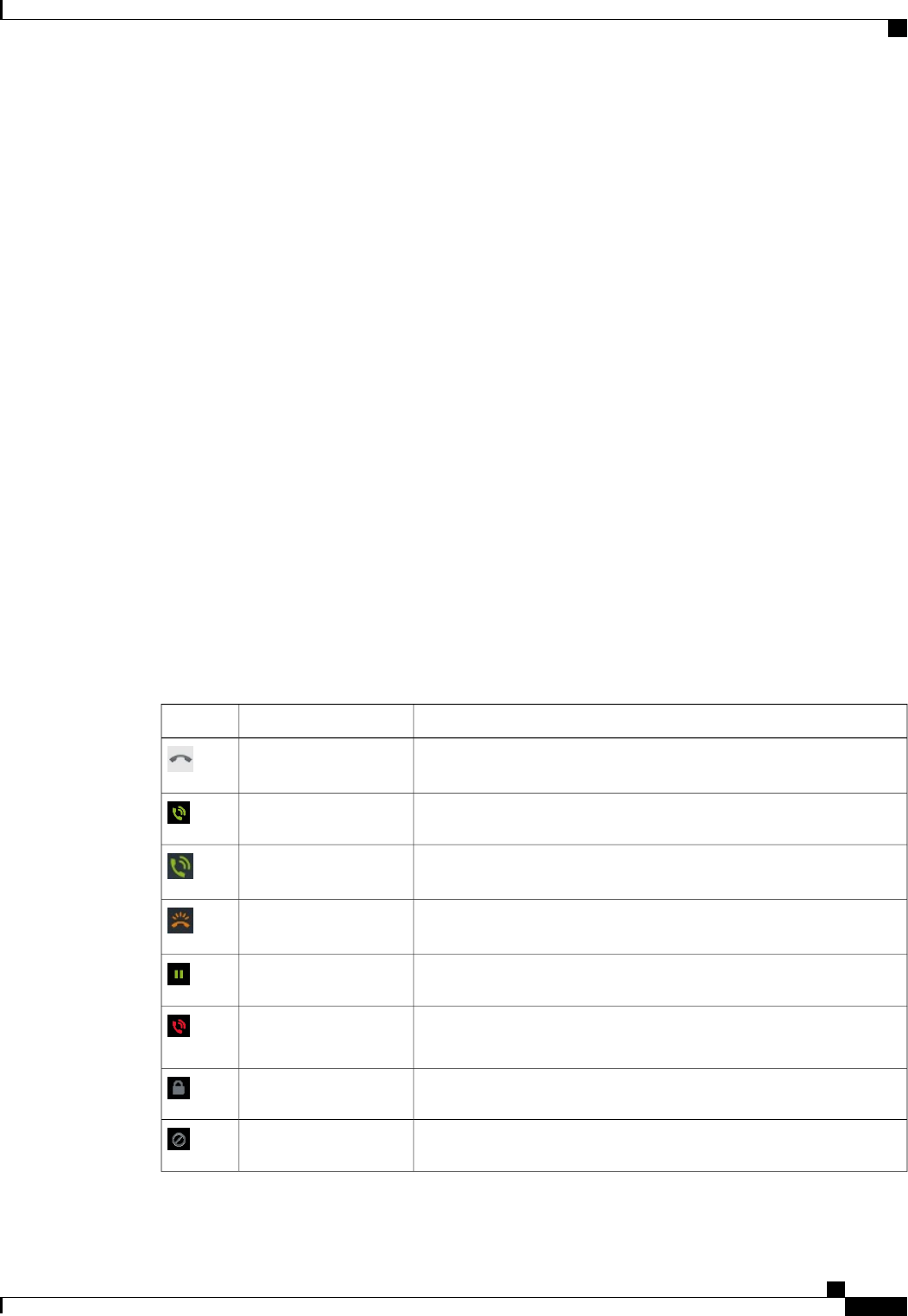
Phone cable lock
You can secure the phone to a desktop with a laptop cable lock. The lock connects to the security slot on the
back of the phone, and the cable can be secured to a desktop.
The security slot can accommodate a lock that is up to 20 mm wide. Compatible laptop cable locks include
the Kensington laptop cable lock and laptop cable locks from other manufacturers that can fit into the security
slot on the back of the phone.
Line and call definitions
The terms lines and calls can be easily confused.
•Lines: Each line corresponds to a directory number or intercom number that others can use to call you.
Your phone can support up to six lines, depending on your phone and configuration. To see how many
lines you have, look at the right side of your phone screen. You have as many lines as you have directory
numbers and phone line icons.
•Calls: Each line can support multiple calls. By default, your phone supports four calls per line, but your
system administrator can adjust this number according to your needs. Only one call can be active at any
time; other calls are automatically placed on hold.
Line and call icons
Your phone displays icons to help you determine the line and call state.
DescriptionLine or call stateIcon
No call activity on this line.On-hook line
You are dialing a number or an outgoing call is ringing.Off-hook line
You are connected to the other party.Connected call
A call is ringing on one of your lines.Ringing call
You have put the call on hold. See Hold and resume, on page 25.Call on hold
Another phone that shares your line has a connected call. See Shared
lines, on page 54.
Remote-in-use
See Secure calls, on page 52.Encrypted call
See Do Not Disturb, on page 45.Do Not Disturb
Cisco Desktop Collaboration Experience DX600 Series User Guide, Release 10.0(1)
OL-28931-01 9
Phone features
Phone cable lock
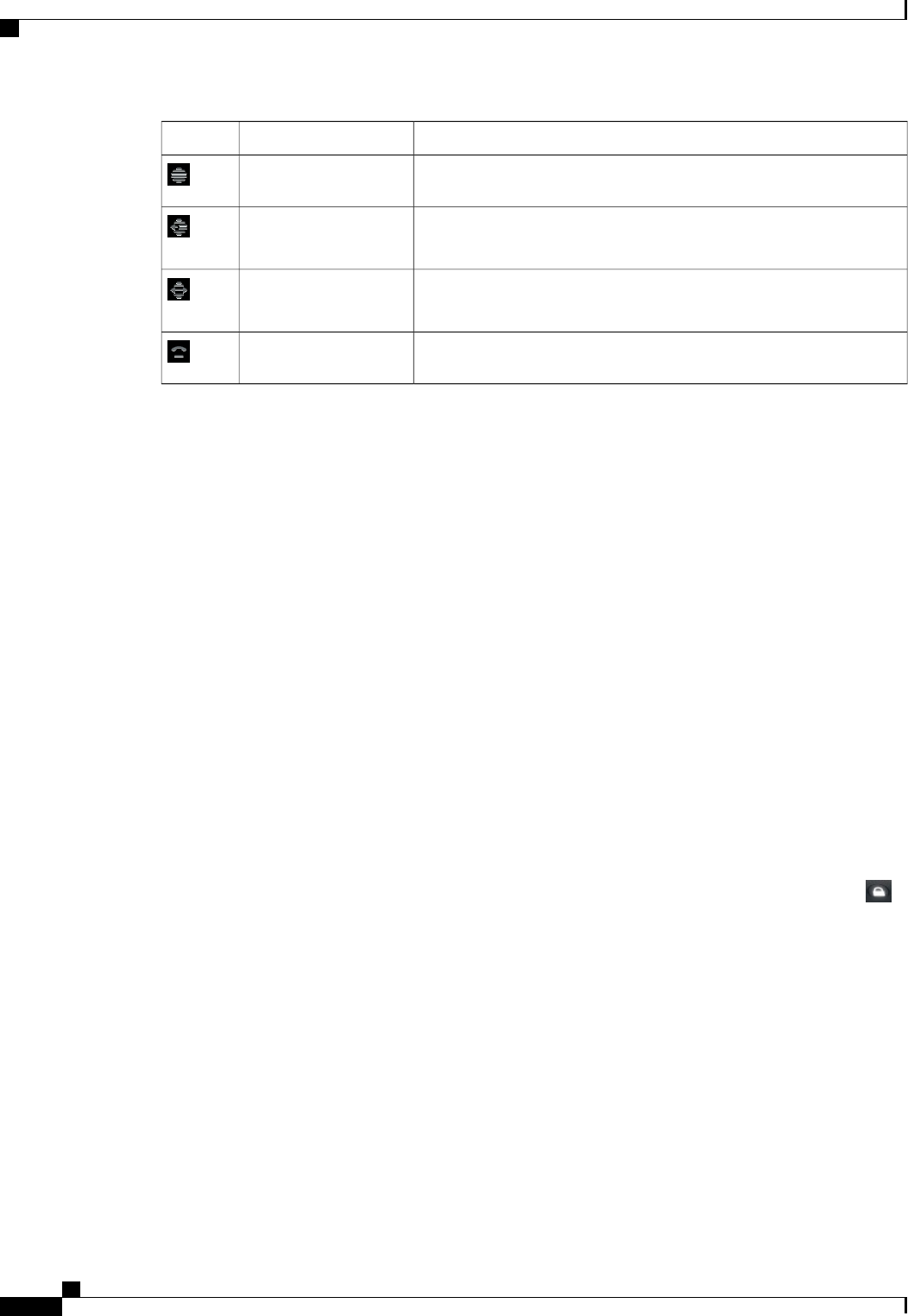
DescriptionLine or call stateIcon
The intercom line is not in use. See Intercom calls, on page 47.Idle intercom line
The intercom line is sending or receiving one-way audio. See Intercom
calls, on page 47.
One-way intercom call
You press the intercom line to enable two-way audio with the intercom
caller. See Intercom calls, on page 47.
Two-way intercom call
See Call Park, on page 39.Call Park
Energy savings
Your phone supports the Cisco EnergyWise program. Your system administrator may set up sleep (power
down) and wake (power up) times for your phone to save energy.
If your phone is scheduled to sleep, the Lock button begins to blink 10 minutes before the scheduled sleep
time.. If your system administrator enables audible alert, you hear your ringtone play. The ringtone plays
according to the following schedule:
•At 10 minutes before power down, the ringtone plays four times.
•At 7 minutes before power down, the ringtone plays four times.
•At 4 minutes before power down, the ringtone plays four times.
•At 30 seconds before power down, the ringtone plays 15 times or until the phone powers down.
If your phone is inactive (idle) at the sleep time, a message reminds you that your phone is going to power
down. To keep the phone active, tap the screen or press any key on the phone.
If your phone is active (for example, on a call), your phone waits until it has been inactive for a period of time
before it notifies you of the pending power shutdown. Before the shutdown happens, a message reminds you
that your phone is going to power down.
At the scheduled time, your phone powers up. To wake up the phone before the scheduled time, press .
Wake and sleep times are linked to the configured days that you normally work. If your requirements change
(for example, your work hours or work days change), contact your system administrator to adjust your phone
settings.
For more information about EnergyWise and your phone, contact your system administrator.
Android
This section describes the basic Android™features on your phone.
Cisco Desktop Collaboration Experience DX600 Series User Guide, Release 10.0(1)
10 OL-28931-01
Phone features
Energy savings
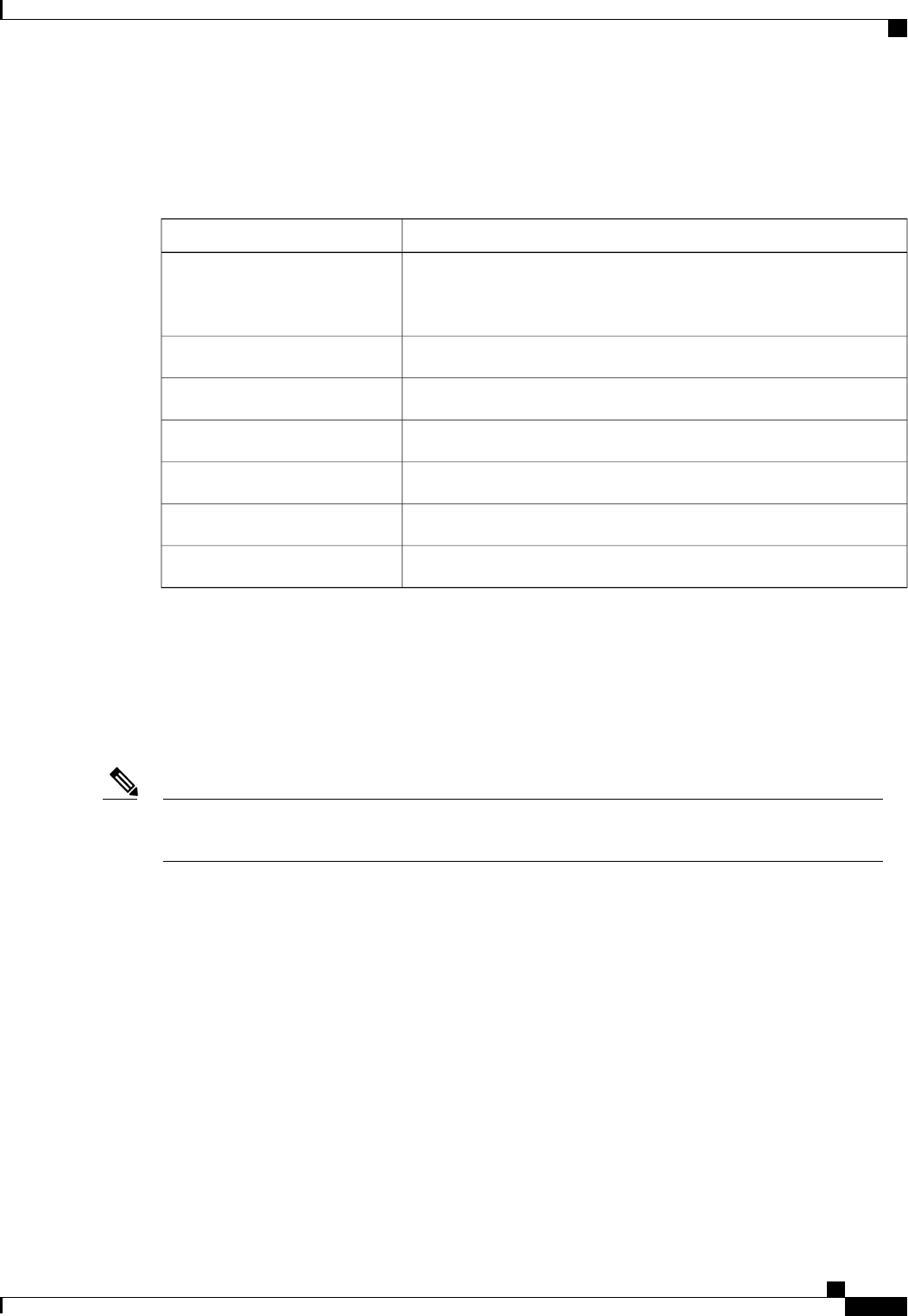
Gestures
Android includes some basic gestures.
ActionGesture
Use your fingertip to press the touchscreen.
Using other objects can damage the display. Be aware that
tapping a phone number can cause the phone to dial the number.
Note
Tap
Tap and hold.Long press
Tap and move.Swipe
Long press and move.Drag
Two taps in quick succession.Double-tap
Tap with two fingers, then move your fingers apart.Pinch open
Tap with two fingers, then move your fingers together.Pinch close
Lock screen
The Lock screen is displayed when the phone is locked (inactive). The Lock screen displays the date and time,
the number of unread email messages, the number of recently missed calls, the number of new voice messages,
and the number of upcoming events for the next 24 hours.
The number of unread email messages, and the number of upcoming events, are displayed only if you
have configured a Microsoft Exchange account.
Note
You can set the amount of time that your phone can be inactive before the screen locks. Your system
administrator may disable the screen lock during your work hours.
By default, the home screen is displayed when you unlock your phone. You can configure your phone to
unlock to the phone application.
Related Topics
Awake to Phone application, on page 13
Cisco Desktop Collaboration Experience DX600 Series User Guide, Release 10.0(1)
OL-28931-01 11
Phone features
Gestures
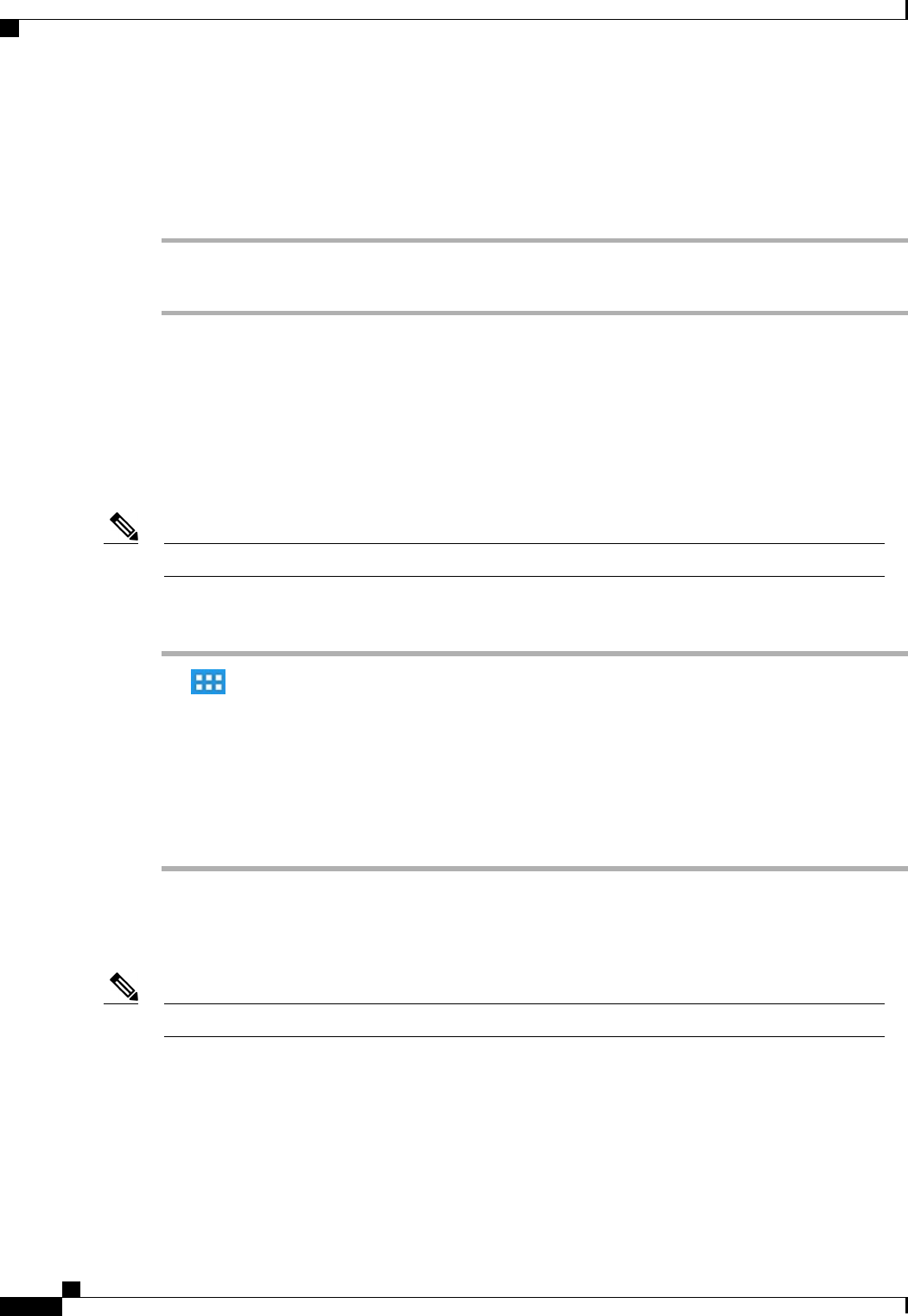
Unlock screen
Procedure
Step 1 Enter your PIN.
Step 2 Press #or tap Unlock.
Place emergency call from Lock screen
Tap Emergency Call.
Add PIN
The phone must be unlocked to set or reset your PIN.Note
Procedure
Step 1 Tap .
Step 2 Tap Settings.
Step 3 Tap Security.
Step 4 Tap Screen Lock.
Step 5 Tap PIN.
Step 6 Enter a PIN and tap Continue. Your PIN must be at least four digits.
Step 7 Enter your PIN again and tap OK to confirm your PIN.
Add password
The phone must be unlocked to set or reset your password.Note
Cisco Desktop Collaboration Experience DX600 Series User Guide, Release 10.0(1)
12 OL-28931-01
Phone features
Lock screen
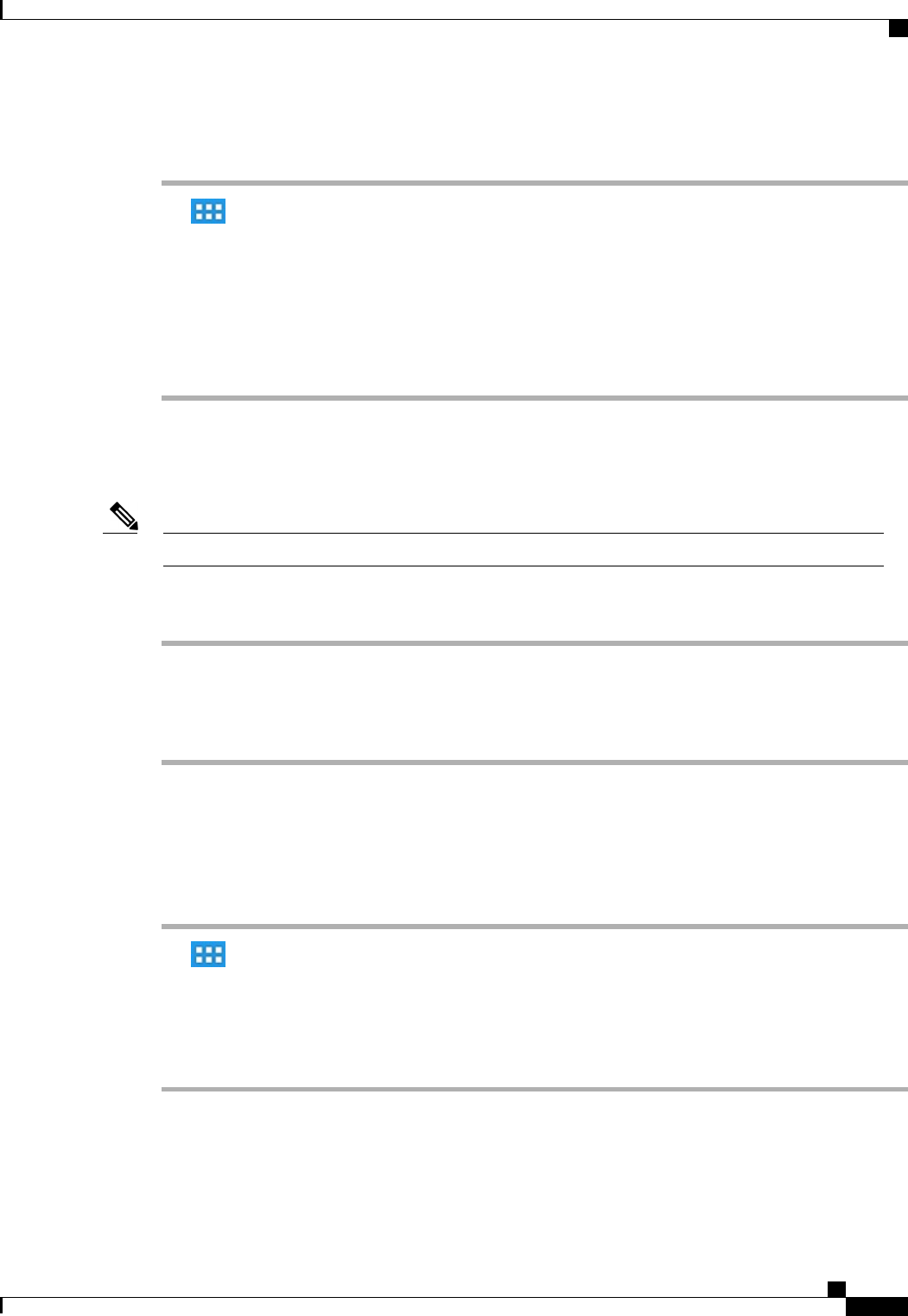
Procedure
Step 1 Tap .
Step 2 Tap Settings.
Step 3 Tap Security.
Step 4 Tap Screen Lock.
Step 5 Tap Password.
Step 6 Enter a password and tap Continue. Your password must be at least four characters.
Step 7 Enter your password again and tap OK to confirm your password.
Reset lost PIN or password
The phone must be unlocked to set or reset your PIN or password.Note
Procedure
Step 1 Tap Forgot PIN or Forgot Password on the Unlock screen.
Step 2 Select a Cisco Unified Communications Manager or Google™account and enter your credentials. You can
only select an active account.
Step 3 Reset your PIN or password. Your phone is now unlocked and your new PIN or password is ready to use.
Awake to Phone application
Procedure
Step 1 Tap .
Step 2 Tap Settings.
Step 3 Tap Security.
Step 4 Tap Default App.
Step 5 Select Awake to phone app.
Cisco Desktop Collaboration Experience DX600 Series User Guide, Release 10.0(1)
OL-28931-01 13
Phone features
Lock screen

Cisco Extension Mobility
Cisco Extension Mobility allows you to configure any Cisco DX600 Series phone as your own temporarily.
After you sign in to Extension Mobility, the phone adopts your user profile, including your phone lines,
features, established services, and web-based settings. Your system administrator must configure Extension
Mobility for you.
The Extension Mobility Change PIN feature allows you to change your PIN from the Settings application.
Tips
•Extension Mobility automatically signs you out after a certain amount of time. Your system administrator
establishes this time limit.
•Changes that you make to your Extension Mobility profile from your Cisco Unified Communications
Manager User Options web pages take effect immediately if you are signed in to Extension Mobility on
the phone; otherwise, changes take effect the next time you sign in.
•Changes that you make to the phone from your User Options web pages take effect immediately if you
are signed out of Extension Mobility; otherwise, changes take effect after you log out.
•Local settings that your phone controls are not maintained in your Extension Mobility profile.
•The data and applications of other users are not available to you when you sign in to Extension Mobility.
•Your phone deletes unused data after a certain length of time.
Sign In to Extension Mobility from Lock screen
Procedure
Step 1 Tap Sign In As New User.
Step 2 Enter your user ID and PIN, provided by your system administrator.
Step 3 If prompted, select a device profile.
Cisco Desktop Collaboration Experience DX600 Series User Guide, Release 10.0(1)
14 OL-28931-01
Phone features
Lock screen
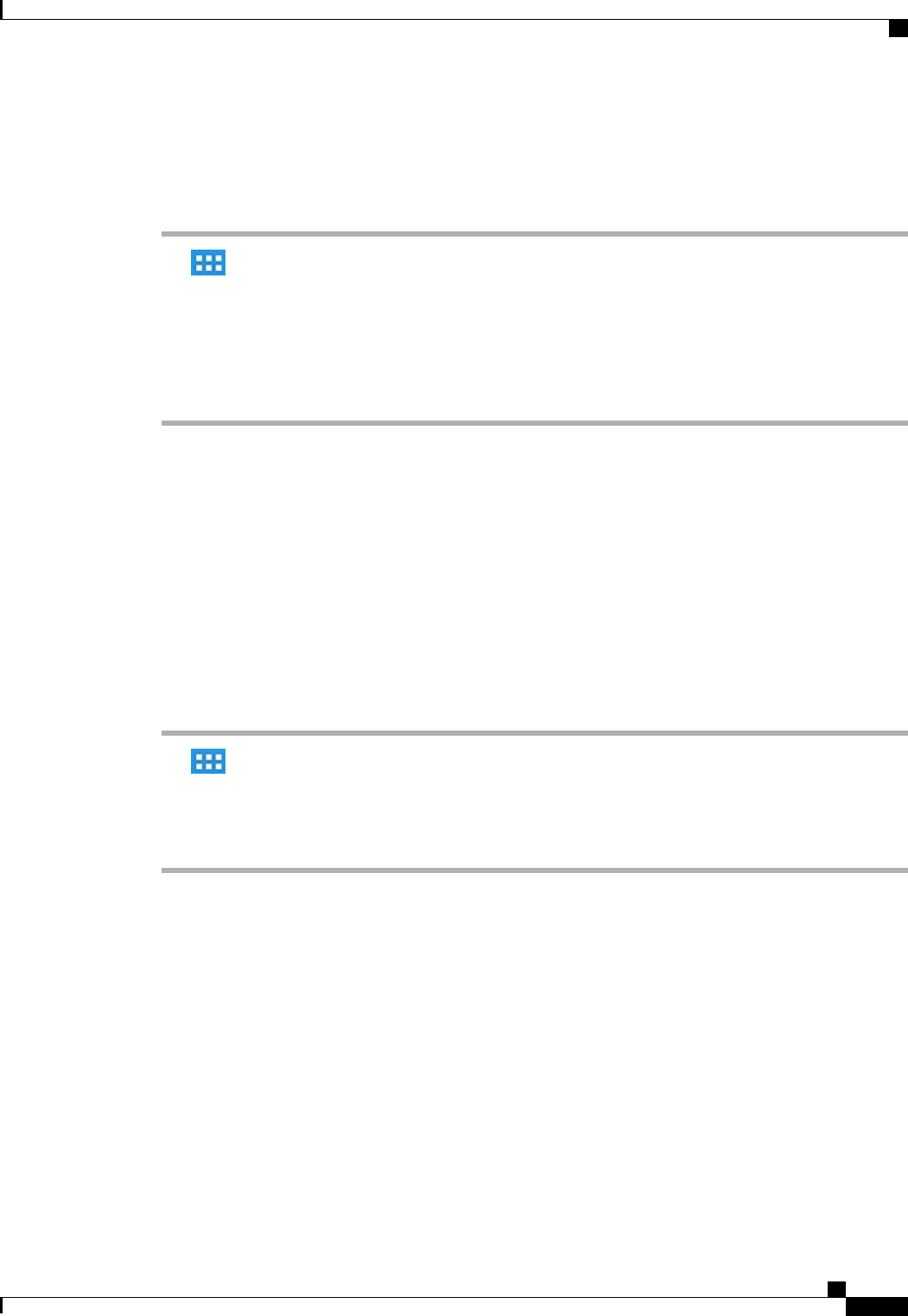
Sign in to Extension Mobility from Settings
Procedure
Step 1 Tap .
Step 2 Tap Settings.
Step 3 Tap Extension Mobility.
Step 4 Tap Sign In.
Step 5 Enter your user ID and PIN.
Step 6 Tap Submit.
Sign Out of Extension Mobility from Lock screen
Procedure
Tap Sign Out.
Sign Out of Extension Mobility from Settings
Procedure
Step 1 Tap .
Step 2 Tap Settings.
Step 3 Tap Extension Mobility.
Step 4 Tap Sign Out.
Cisco Desktop Collaboration Experience DX600 Series User Guide, Release 10.0(1)
OL-28931-01 15
Phone features
Lock screen

Set screen timeout
Procedure
Step 1 Tap .
Step 2 Tap Settings.
Step 3 Tap Security.
Step 4 Tap Automatically Lock.
Step 5 Select the length of time that your phone can be inactive before the screen locks. Note that your security
settings may limit your screen timeout choices.
Setup Assistant
Use the Setup Assistant to set up the following:
•Email
•Jabber IM
•WebEx
•Visual Voicemail
The Setup Assistant runs automatically the first time that you use your Cisco DX600 Series phone. If you
choose not to use the Setup Assistant, you can set up these applications through the Settings application.
Launch the Settings application from the Applications menu.
Some users find it easier to enter complex passwords with a standard keyboard, rather than the onscreen
keyboard. For information about using a standard keyboard with your phone, see USB keyboard and
mouse, on page 122.
Note
Run Setup Assistant
Procedure
Step 1 Tap Email and follow the on-screen instructions.
Step 2 Tap Jabber IM and follow the on-screen instructions.
Step 3 Tap WebEx and follow the on-screen instructions.
Step 4 Tap Voice Messages and follow the on-screen instructions.
Cisco Desktop Collaboration Experience DX600 Series User Guide, Release 10.0(1)
16 OL-28931-01
Phone features
Setup Assistant
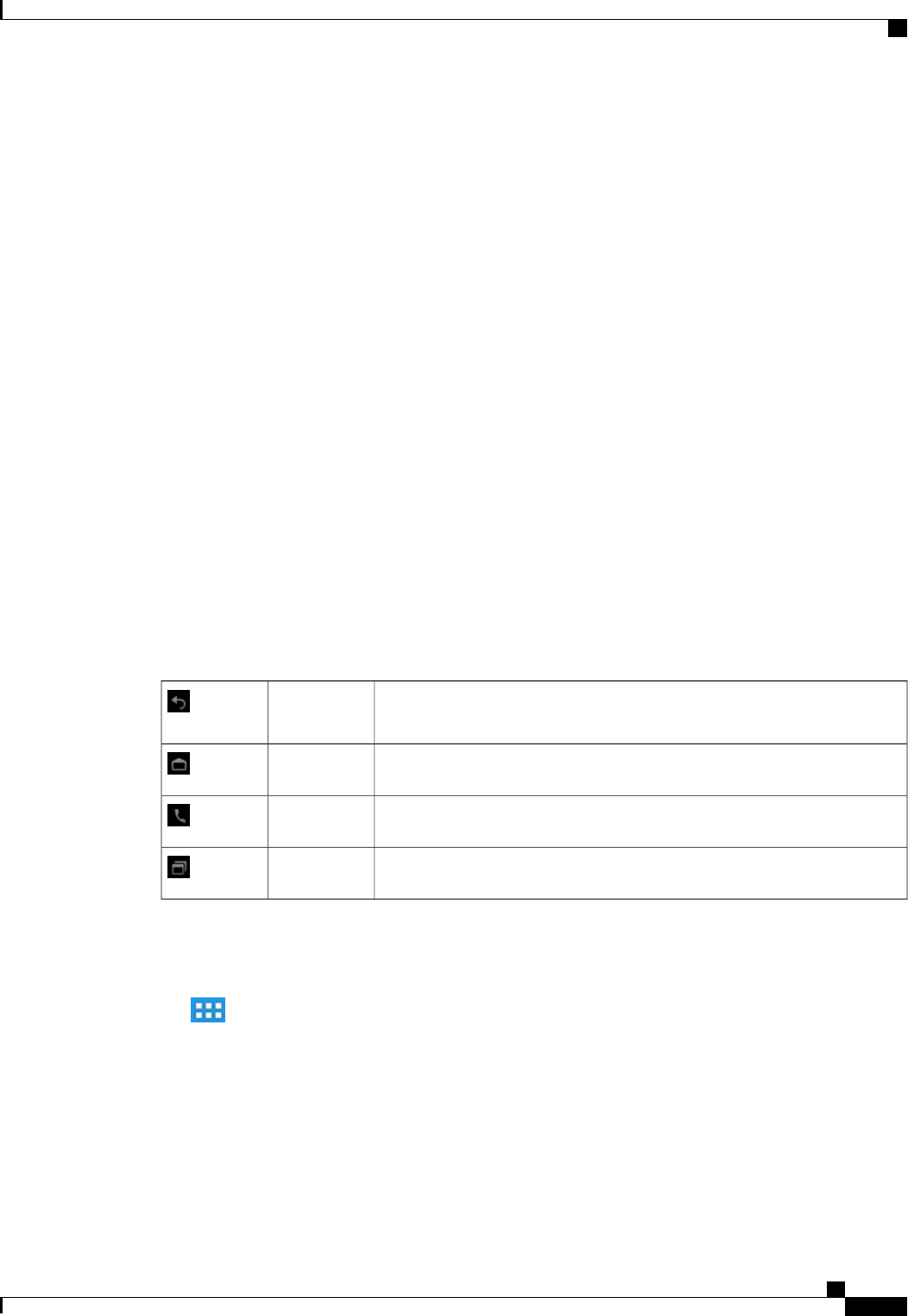
Related Topics
Email, on page 93
Jabber IM, on page 100
WebEx, on page 109
Home screen
The home screen uses a landscape orientation. Place widgets and shortcuts anywhere on the home screen.
Status bar
The status bar is at the bottom of the screen. The status bar includes:
•Navigation icons
•Notification icons for applications such as the phone, email, and Jabber IM
•Status icons for network connections
Tap a notification icon or status icon to see more detailed information.
Navigation icons
Table 2: Navigation icons
Tap Back to go to the previous page or application., or to dismiss the
on-screen keyboard.
Back
Tap Home to view the home screen.Home
Tap Phone to launch the phone application.Phone
Tap Recents to view the list of recently used applications.Recents
Applications menu
Tap to display the full collection of installed applications.
Work spaces
Multiple work spaces are available for you to set up. Each work space holds a variety of widgets and shortcuts
in any configuration.
Cisco Desktop Collaboration Experience DX600 Series User Guide, Release 10.0(1)
OL-28931-01 17
Phone features
Home screen

Navigate work spaces
Procedure
Swipe left or right on an open space on the home screen to go to the work space to the left or to the right.
Widgets
Widgets are small applications that you can place on the home screen. Widgets provide at-a-glance information
and some functions from full applications.
The following table describes some of the widgets that your phone includes:
Table 3: Widgets
Display upcoming events.Calendar
Display an icon for one of your contacts. Tap the icon
to open the Quick Contact Badge for that contact.
Contacts
Display a digital clock.Digital clock
Display an icon for one of your contacts. Tap the icon
to call that contact.
Direct Dial
Display recent email messages.Email
Display your favorite contacts.Favorites
Display all recent calls, missed calls, messages, or
speed dials.
Phone
Toggle these features on or off: Forward All, Privacy,
Do Not Disturb, Mobility and Self-View.
Phone features
Display the number of missed calls, new voice
messages, unread email messages, and upcoming
events.
Unified Inbox
Display upcoming WebEx meetings.WebEx
Set up home screen
Add applications, widgets, and folders, or change your wallpaper to set up your home screen.
Cisco Desktop Collaboration Experience DX600 Series User Guide, Release 10.0(1)
18 OL-28931-01
Phone features
Home screen
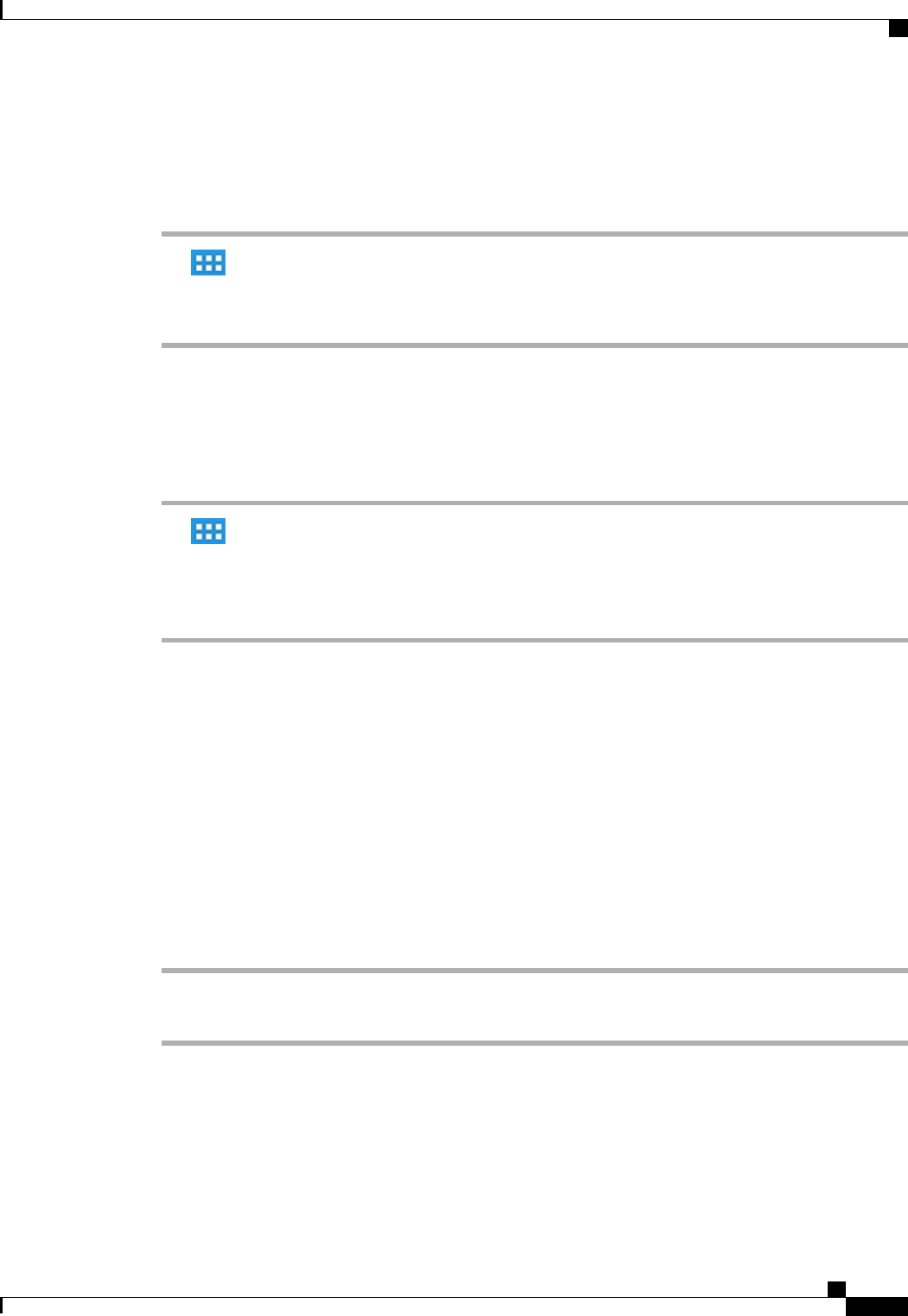
Add application icon to home screen
Procedure
Step 1 Tap .
Step 2 Long press an application.
Step 3 Drag the application icon to an empty space on any of the home screen work spaces.
Add widget to home screen
Procedure
Step 1 Tap .
Step 2 Tap Widgets.
Step 3 Long press a widget.
Step 4 Drag the widget to an empty space on any of the home screen work spaces.
Move widget or icon
Procedure
Drag the widget or icon to an empty space on the home screen. Drag a widget or icon to either side of the
screen to place the widget or icon on another work space.
Remove widget or icon
Procedure
Step 1 Long press the widget or icon.
Step 2 Drag the widget or icon up to Remove. The widget or icon is deleted and Remove disappears.
Cisco Desktop Collaboration Experience DX600 Series User Guide, Release 10.0(1)
OL-28931-01 19
Phone features
Home screen
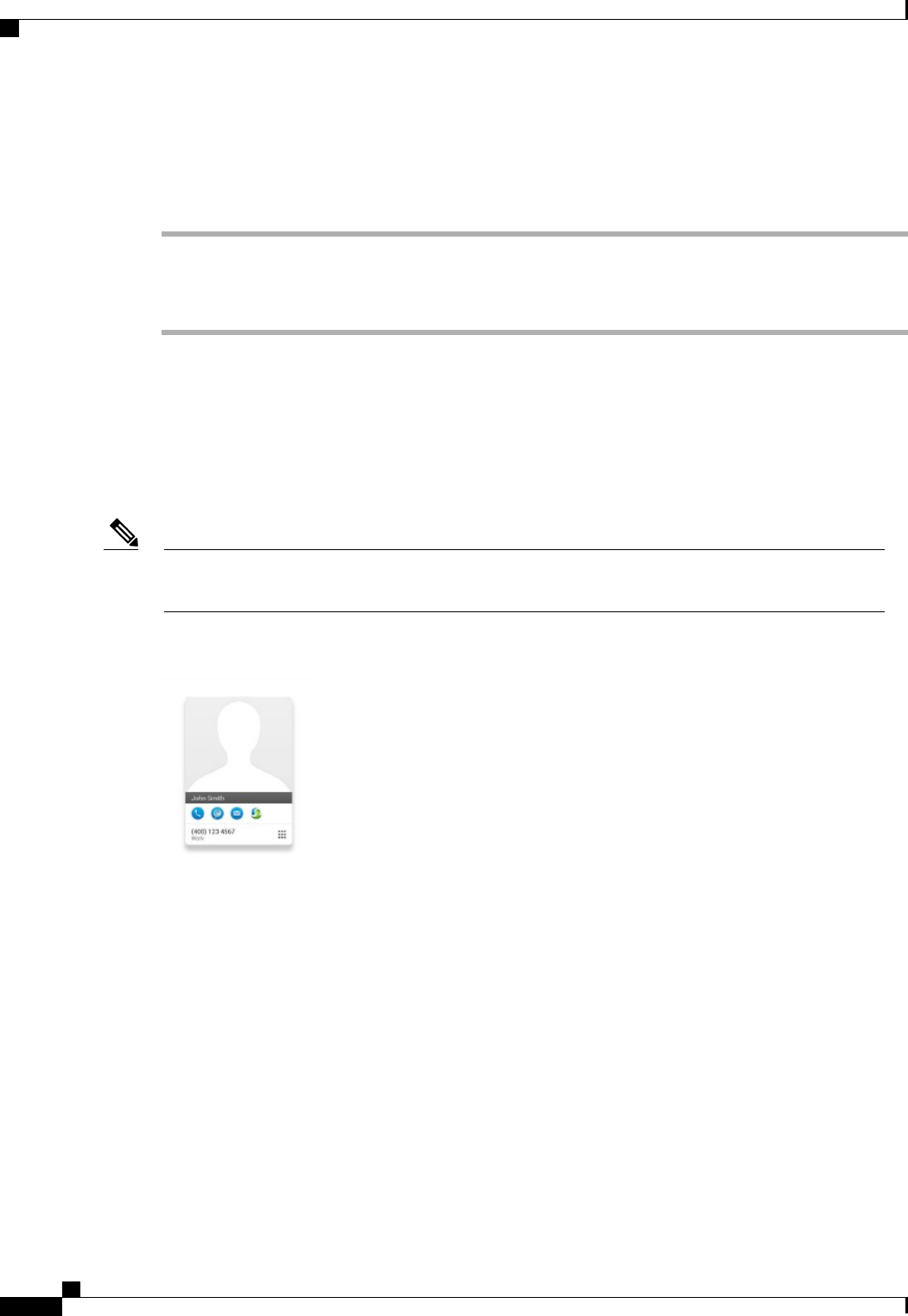
Change wallpaper
Procedure
Step 1 Long press an open space on the home screen.
Step 2 Tap Wallpapers.
Step 3 Select a wallpaper.
Quick Contact Badge
The Quick Contact Badge allows you to communicate with your contacts from within several applications
and in a variety of ways. Use the Quick Contact Badge to place a call, send an email message, send an instant
message (IM), or start a WebEx meeting.
Other options may be available on the Quick Contact Badge, depending on which applications you have
installed.
Note
Tap a contact icon to open the Quick Contact Badge.
The following image shows the Quick Contact Badge:
Share menu
Some content, such as URLs, contacts, and photos, can be shared with Bluetooth, email, Jabber IM, and other
applications through the Share menu. In any application that supports the Share menu, tap Share to view the
sharing options.
On-screen keyboard
An on-screen keyboard pops up automatically when you select a text input field.
Cisco Desktop Collaboration Experience DX600 Series User Guide, Release 10.0(1)
20 OL-28931-01
Phone features
Quick Contact Badge

Cleaning and maintenance
Use only a soft, dry cloth to wipe the touchscreen. Do not use any liquids or powders on the phone, because
they can contaminate phone components and cause failures.
Cisco Desktop Collaboration Experience DX600 Series User Guide, Release 10.0(1)
OL-28931-01 21
Phone features
Cleaning and maintenance

Cisco Desktop Collaboration Experience DX600 Series User Guide, Release 10.0(1)
22 OL-28931-01
Phone features
Cleaning and maintenance

CHAPTER 3
Calling tasks
You can use a range of features and services to perform basic call-handling tasks. Feature availability can
vary; contact your system administrator for more information.
•Common call tasks, page 23
•Advanced call tasks, page 31
Common call tasks
Here are some easy ways to place a call on your phone.
Tips
•You can dial on-hook, without a dial tone (predial). To predial, enter a number, then go off-hook by
lifting the handset, by tapping Dial, or by pressing or .
•When you predial, your phone tries to anticipate the number that you are dialing by displaying matching
numbers (if available) from your call history. This feature is called Auto Dial. To call a number that is
displayed with Auto Dial, tap the number, or scroll to it and go off-hook.
•If you make a mistake while dialing, tap Delete to delete digits.
•If parties on a call hear a beep, the call may be monitored or recorded. Contact your system administrator
for more information.
•You can start or stop a recording by tapping Record.
•Your phone may be set up for international call logging, as indicated by a plus (+) symbol on the call
history, redial, or call directory entries. Contact your system administrator for more information.
Answer call
You can answer a call by lifting the handset, or you can use other options if they are available on your phone.
Cisco Desktop Collaboration Experience DX600 Series User Guide, Release 10.0(1)
OL-28931-01 23

Then...If you want to...
Press if it is not lit. Or, if is lit, tap Answer.
The phone selects the ringing line automatically. For the
option to select the primary line each time, contact your
system administrator.
Note
If you are using a wireless headset, refer to the wireless headset
documentation.
Answer with a headset
Press , or tap Answer.
The phone selects the ringing line automatically. For the
option to select the primary line each time, contact your
system administrator.
Note
Answer with the speakerphone
Tap Answer.Switch from an active call to answer a
new call
Tap Answer.Answer by using call waiting
Tap Divert.Send a call to a voice message system
Use AutoAnswer.Autoconnect calls
Use Call Park, Directed Call Park, or Assisted Directed Call Park.Retrieve a parked call on another phone
Use Call Pickup.Use your phone to answer a call that is
ringing elsewhere
Set up Mobile Connect and answer your phone.
If you answer a call on your mobile phone, and you have
configured up to four IP Phones as shared lines, the additional
phones stop flashing when you answer the call.
Answer a call on your mobile phone or
other remote destination
Tips
•If parties on a call hear a beep, the call may be monitored or recorded. Contact your system administrator
for more information.
•If you work in a contact center or similar environment, you can create, update, and delete your own
prerecorded greeting that plays automatically if Agent Greeting is configured on your phone. For more
information, contact your system administrator.
•A Call Chaperone user cannot answer an incoming call while calls are chaperoned.
Disconnect call
To end a call, simply hang up. The following table provides more details.
Cisco Desktop Collaboration Experience DX600 Series User Guide, Release 10.0(1)
24 OL-28931-01
Calling tasks
Disconnect call
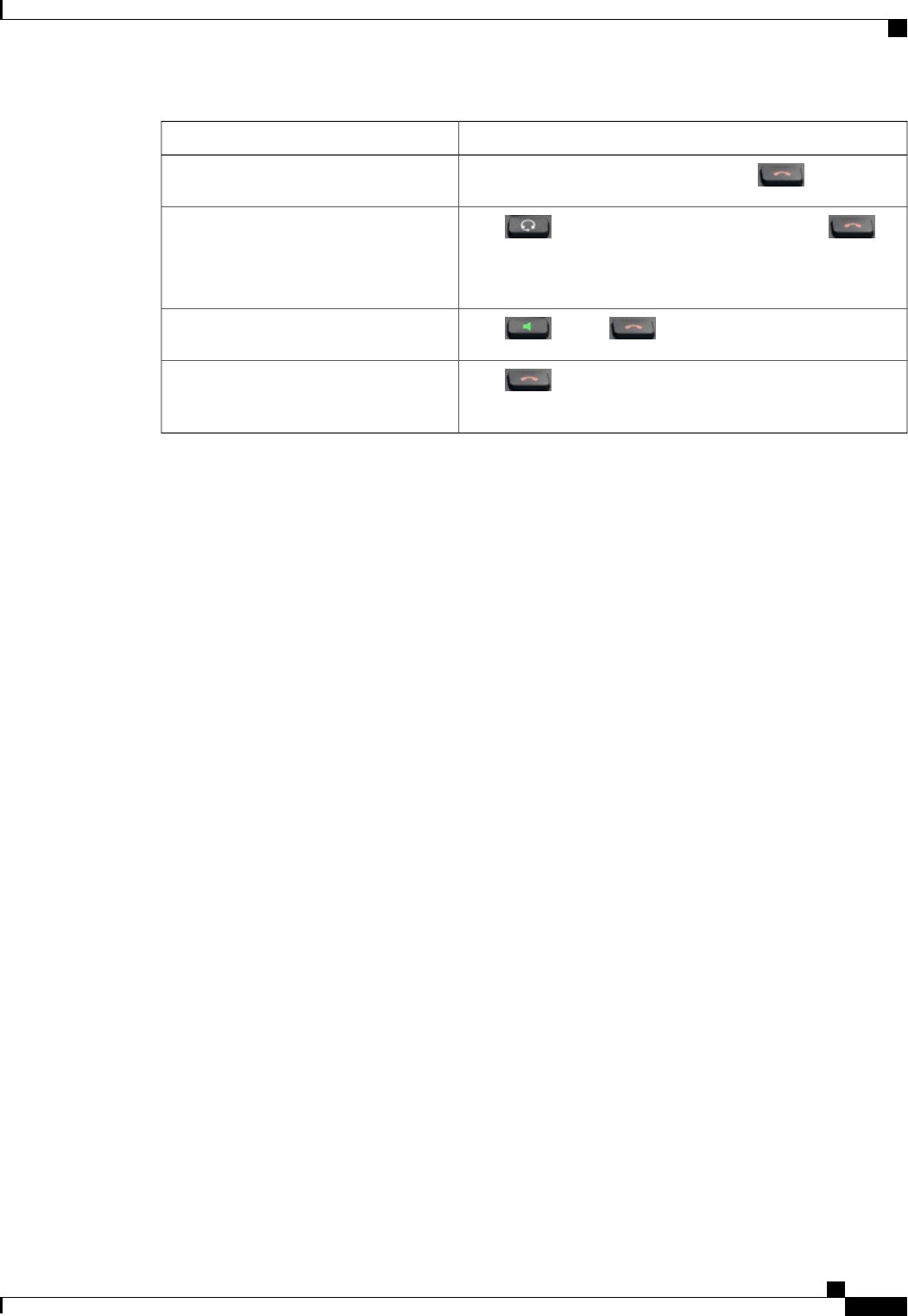
Then...If you want to...
Return the handset to the cradle. Or, press .
Hang up while using the handset
Press . Or, to keep headset mode active, press .
If you are using a wireless headset, refer to the wireless headset
documentation for instructions.
Hang up while using a headset
Press orpress .
Hang up while using the speakerphone
Press . If necessary, remove the call that you want to end
from hold first.
Hang up one call, but preserve another call
on the same line
Hold and resume
You can hold and resume calls. When you put a call on hold, the Hold icon appears on the right in the call
information area. With a shared line, when another phone places a call on hold, the phone displays the Remote
Hold icon.
If the Hold Reversion feature is enabled for your phone, a call that you put on hold reverts to ringing after a
certain time. The reverting call remains on hold until you resume it or until Hold Reversion times out. Your
phone indicates the presence of a reverting call by the following actions:
•Alerts you at intervals with a single ring (or flash or beep, depending on your phone line setting).
•Briefly displays a Hold Reversion message in the status bar at the bottom of the phone screen.
•Displays the animated Hold Reversion icon next to the caller ID for the held call.
Tips
•The Hold feature typically generates music (if Music on Hold is configured) or a beeping tone.
•If you receive an alert for an incoming call and a reverting call at the same time, your phone shifts the
focus of the phone screen to display the incoming call by default. Your system administrator can change
this focus priority setting.
•If you use a shared line, Hold Reversion rings only on the phone that puts the call on hold, not on the
other phones that share the line.
•Your system administrator determines the duration between Hold Reversion alerts.
•When a call is chaperoned, the call chaperone cannot use Hold.
Cisco Desktop Collaboration Experience DX600 Series User Guide, Release 10.0(1)
OL-28931-01 25
Calling tasks
Hold and resume

Put call on hold
Procedure
Step 1 Make sure that the call you want to put on hold is highlighted.
Step 2 Press .
Remove call from hold on different line
Procedure
Step 1 Select a line. Doing so may cause a held call to resume automatically:
•If a reverting call is on the line, that call resumes.
•If more than one reverting call is on the line, the oldest reverting call resumes.
•If a nonreverting held call is the only call on the line, the nonreverting held call resumes.
Step 2 If necessary, scroll to the appropriate call and press .
Mute
With Mute enabled, you can hear other parties on a call but they cannot hear you. You can use Mute with the
handset, speakerphone, or headset.
Mute or unmute call
Procedure
Step 1 To mute a call, press .
Step 2 To unmute a call, press again.
Cisco Desktop Collaboration Experience DX600 Series User Guide, Release 10.0(1)
26 OL-28931-01
Calling tasks
Mute
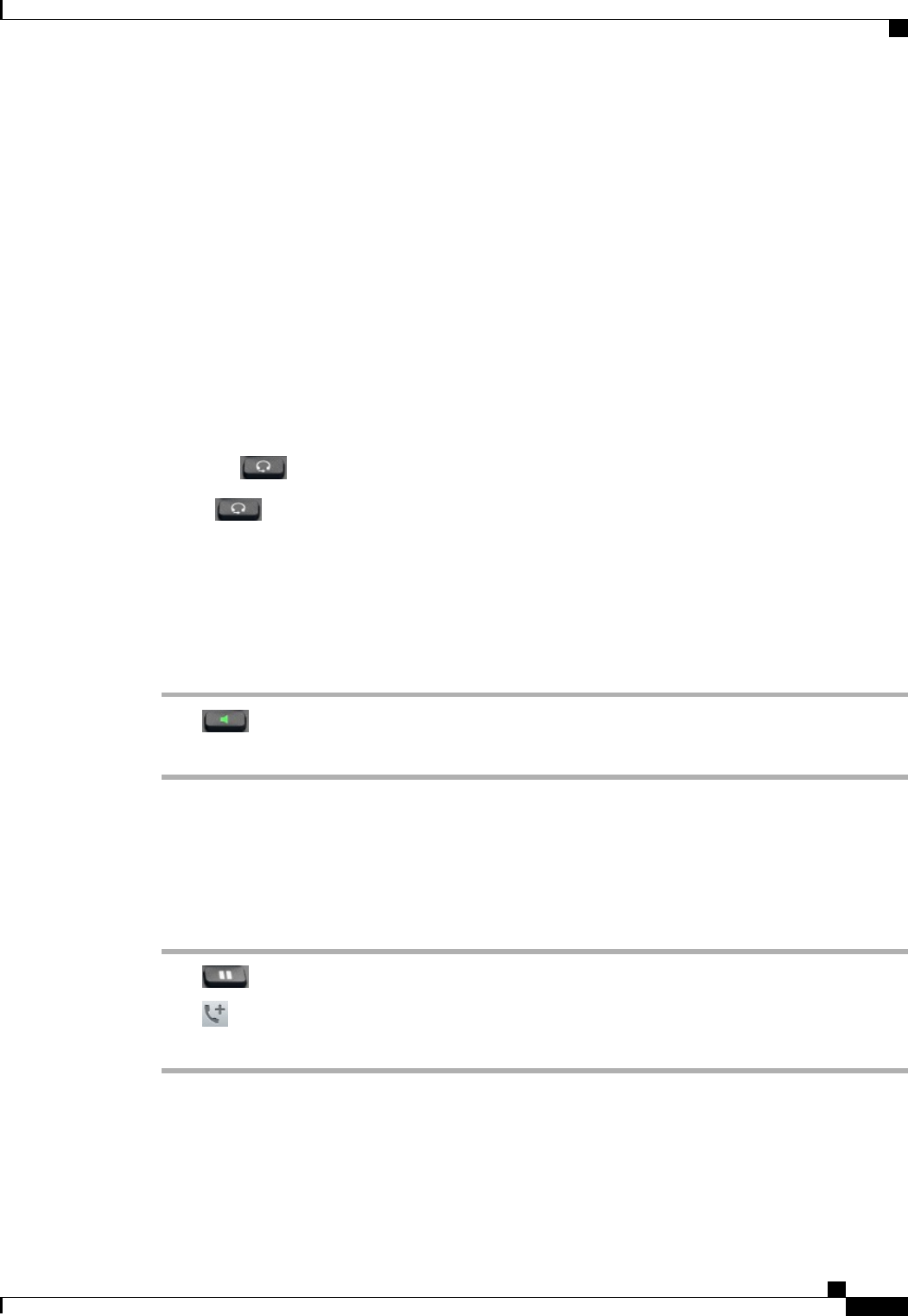
Place call
Procedure
Pick up the handset and dial the number.
Place call with headset
Procedure
Perform one of the following actions:
•Press and enter a number.
•If is lit, press New Call and enter a number.
Place call with speakerphone
Procedure
Step 1 Press .
Step 2 Enter a number.
Place call when another call is active
Procedure
Step 1 Press .
Step 2 Press .
Step 3 Enter a number.
Cisco Desktop Collaboration Experience DX600 Series User Guide, Release 10.0(1)
OL-28931-01 27
Calling tasks
Place call
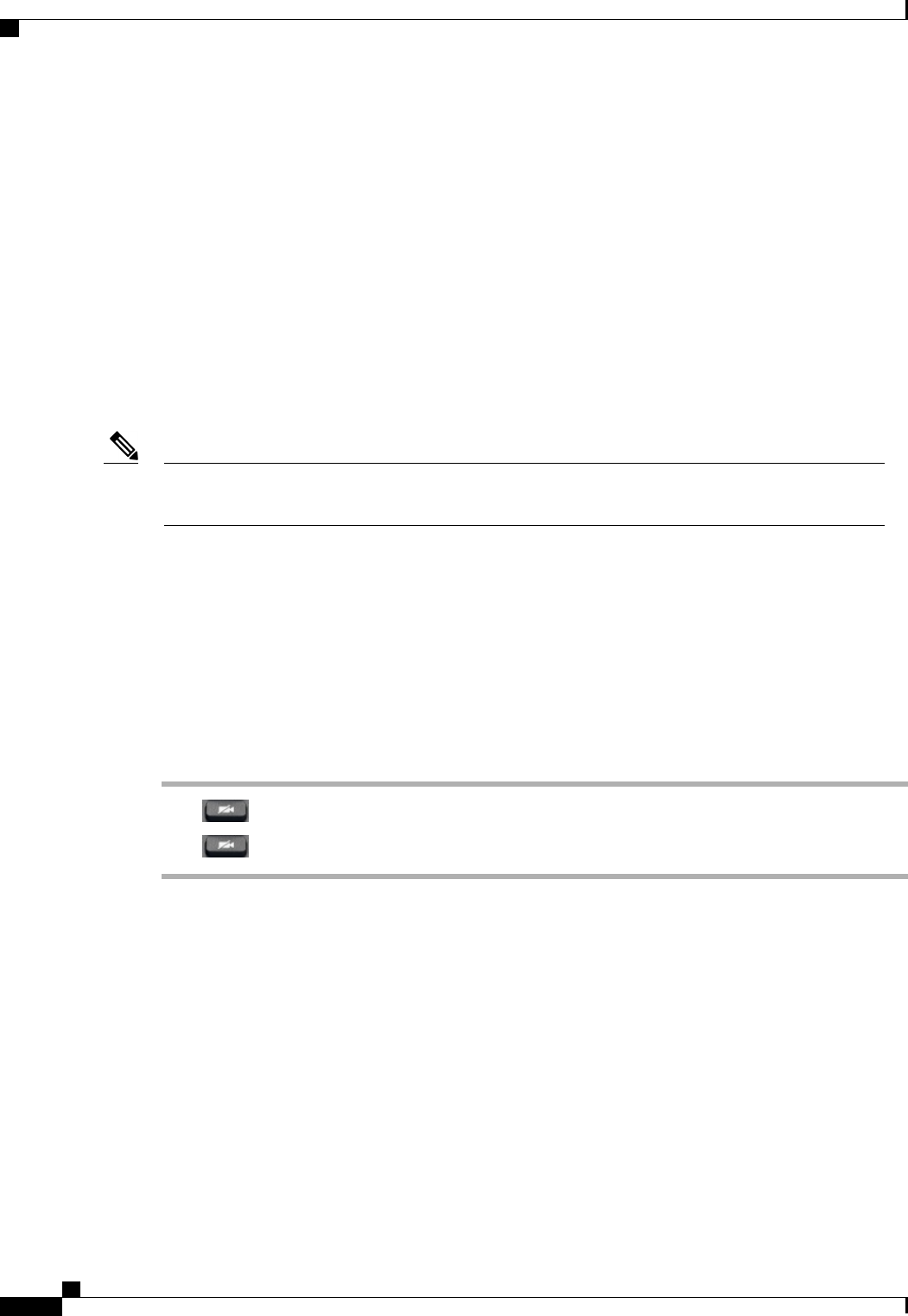
Redial number
Procedure
Press Redial to dial the last number.
Video calls
You can send and receive video calls. Some third-party endpoints will display compatibility issues. For
example, video may not resume after placing a call on hold, during video calls with a third-party endpoint.
Contact your system administrator for more details.
If you launch another application that requires use of the camera while you are on a video call, that
application may crash.
Note
Video call control bar
A call control bar appears at the bottom of an active video call. The video call control bar disappears after a
few seconds. Tap the screen to make the call control bar reappear.
Stop your video transmission
Procedure
Step 1 Press to stop your video.
Step 2 Press again to resume video transmission.
Automatic video transmission
By default, your phone automatically transmits video during a video call.
Cisco Desktop Collaboration Experience DX600 Series User Guide, Release 10.0(1)
28 OL-28931-01
Calling tasks
Redial number

Stop automatic video transmission
Procedure
Step 1 Tap .
Step 2 Toggle Always Send Video to off.
Adjust video call settings
You can adjust your video quality for video calls or turn off video calls.
Procedure
Step 1 Tap .
Step 2 Tap Settings.
Step 3 Tap Calls.
Step 4 Select a video call setting. Depending on how your system administrator set up your phone application, some
video call settings may not be available. Contact your system administrator for more information.
Self-video
Use self-video to preview the video of yourself that you display during video calls.
Show self-video
Procedure
Step 1 Tap .
Step 2 Tap Self View.
Step 3 Tap Xto stop showing self-video. During a video call, self-video disappears after a few seconds.
Visual Voicemail
Visual Voicemail allows you to manage your voice messages. You can also access your voice messages in
the Unified Inbox application.
Cisco Desktop Collaboration Experience DX600 Series User Guide, Release 10.0(1)
OL-28931-01 29
Calling tasks
Visual Voicemail

Set up Visual Voicemail
Before you can use Visual Voicemail, you must set up an account. If you have not already used the Setup
Assistant to enter your Visual Voicemail credentials, you can set up your account on the Voice Messages tab.
Procedure
Step 1 Tap Recents.
Step 2 Tap Messages.
Step 3 Enter your account credentials and tap Sign In.
Listen to voice message
Procedure
Tap next to a voice message to listen to that voice message.
View voice message details
Procedure
Tap a voice message to view details.
Reply to voice message
Procedure
Step 1 Tap a voice message to view details.
Step 2 Tap .
Cisco Desktop Collaboration Experience DX600 Series User Guide, Release 10.0(1)
30 OL-28931-01
Calling tasks
Visual Voicemail
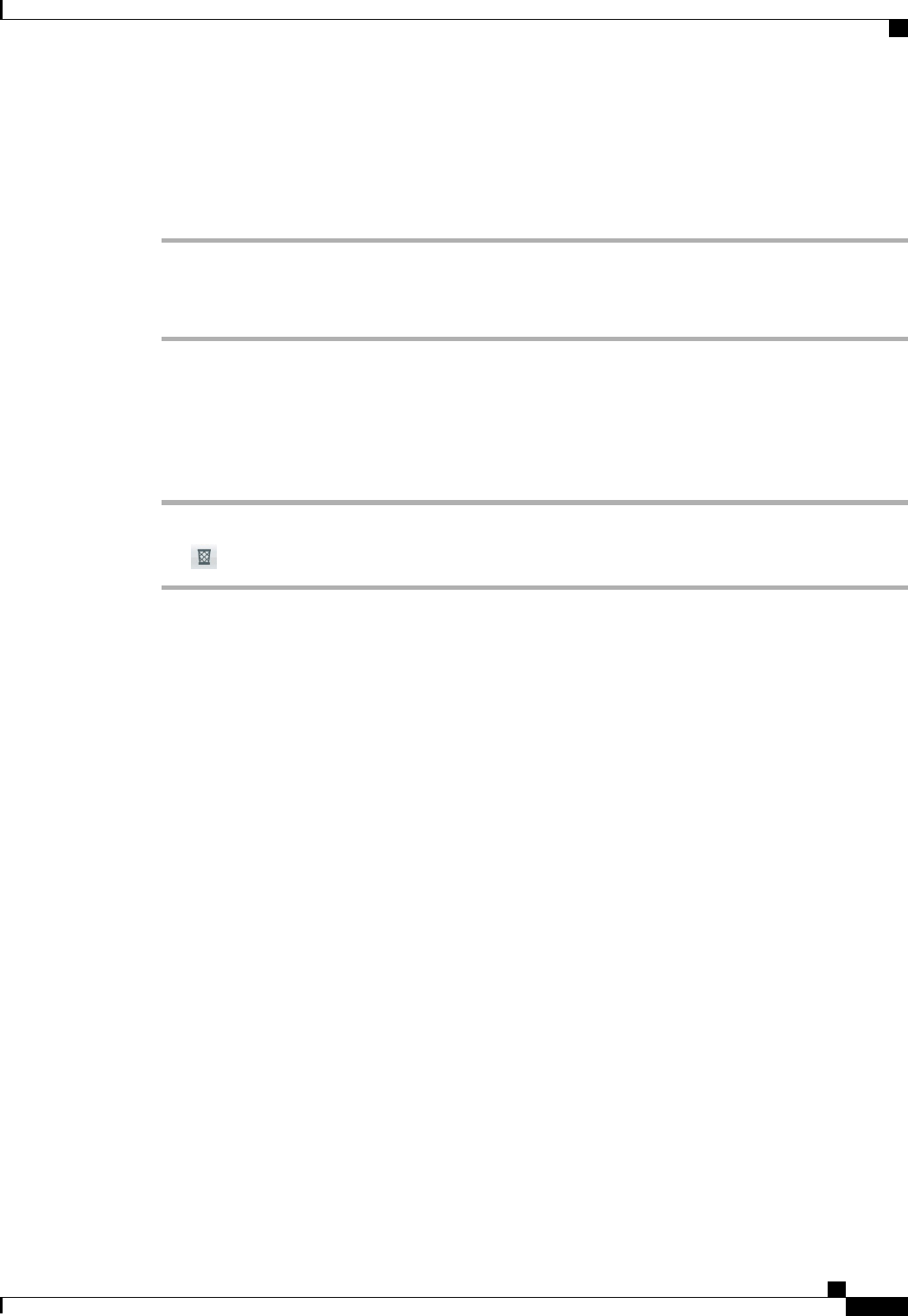
Forward voice message
Procedure
Step 1 Tap a voice message to view details.
Step 2 Tap More.
Step 3 Tap Forward and select the recipients.
Delete voice message
Procedure
Step 1 Select one or more voice messages.
Step 2 Tap .
Advanced call tasks
You can use special features and services that may be available on your phone to place calls. For more
information about these options, contact your system administrator.
Tips
•For more information about using your Cisco Extension Mobility prefix to place a call, see Cisco
Extension Mobility, on page 14.
•To check if a line that is associated with a Speed Dial, call record, or directory listing is busy before
placing a call to that line, see Line status features, on page 49.
Business calls with single phone number
Intelligent Session Control associates your mobile phone number with your business phone number. When
you receive a call to your remote destination (mobile phone), your desk phone does not ring; only your remote
destination rings. When you answer an incoming call on the mobile phone, the desk phone displays a Remote
in Use message.
During a call, you can also use any of your mobile phone features. For example, if you receive a call on your
mobile number, you can either answer the call from your desk phone or you can hand off the call from your
mobile phone to your desk phone.
Cisco Desktop Collaboration Experience DX600 Series User Guide, Release 10.0(1)
OL-28931-01 31
Calling tasks
Advanced call tasks

Then...If you want to...
Use the various features of your mobile phone (for example,
*74). Contact your system administrator for a list of access
codes.
Transfer your incoming mobile active call
to desk phone
Mobile Connect and Mobile Voice Access
If you have Mobile Connect and Mobile Voice Access installed, you can use your mobile phone to handle
calls that are associated with your desktop phone number.
Your desktop and remote destinations receive calls simultaneously.
When you answer the call on your desktop phone, the remote destinations stop ringing, disconnect, and display
a missed call message.
When you answer the call on one remote destination, the other remote destinations stop ringing and disconnect;
the other remote destinations show a missed call message.
Then...If you want to...
Use the User Options web pages to set up remote destinations and create
access lists to allow or block calls from specific phone numbers from being
passed to the remote destinations. See Set up phone and access list for Mobile
Connect, on page 79.
Configure Mobile Connect
See Answer call, on page 23.Answer a call using your
mobile phone
See Active call movement, on page 46.Switch an active call between
your desk phone and mobile
phone
See Advanced call tasks, on page 31.Make a call from your mobile
phone
Tips
•When you call Mobile Voice Access, you must enter the number that you are calling and your PIN if
any of the following are true:
◦The number you are calling from is not one of your remote destinations.
◦The number is blocked by you or your carrier (shown as Unknown Number).
◦The number is not accurately matched in the Cisco Unified Communications Manager database;
for example, if your number is 510-666-9999, but it is listed as 666-9999 in the database, or your
number is 408-999-6666, but the database entry is 1-408-999-6666.
Cisco Desktop Collaboration Experience DX600 Series User Guide, Release 10.0(1)
32 OL-28931-01
Calling tasks
Business calls with single phone number

•If you incorrectly enter any requested information (such as mobile phone number or PIN) three times
in a row, the Mobile Voice Access call disconnects, and you are locked out for a period of time. Contact
your system administrator for assistance.
Put call picked up on mobile phone on hold
Procedure
Step 1 Tap Enterprise Hold (name may vary).
The other party is placed on hold.
Step 2 On your mobile phone, tap Resume (name may vary).
Connect to Mobile Voice Access
Procedure
Step 1 From any phone, dial your assigned Mobile Voice Access number.
Step 2 Enter the number that you are calling from, if prompted, and your PIN.
Turn on Mobile Connect from mobile phone
Procedure
Step 1 Dial your assigned Mobile Voice Access number.
Step 2 If requested, enter your mobile phone number and PIN.
Step 3 Press 2to enable Mobile Connect.
Step 4 Choose whether to turn Mobile Connect on for all configured phones or just one:
•All phones: Enter 2.
•One phone: Enter 1and enter the number that you want to add as a remote destination, followed by #.
Cisco Desktop Collaboration Experience DX600 Series User Guide, Release 10.0(1)
OL-28931-01 33
Calling tasks
Business calls with single phone number

Turn off Mobile Connect from mobile phone
Procedure
Step 1 Dial your assigned Mobile Voice Access number.
Step 2 If requested, enter your mobile phone number and PIN.
Step 3 Press 3to disable Mobile Connect.
Step 4 Choose whether to turn Mobile Connect off for all configured phones or just one:
•All phones: Enter 2.
•One phone: Enter 1and enter the number that you want to remove as a remote destination, followed by
#.
Turn on or off Mobile Connect access to all remote destinations from desk phone
Procedure
Step 1 Tap Mobility to display the current remote destination status (Enabled or Disabled).
Step 2 Tap Select to change the status.
Step 3 Tap Exit.
Conference calls
Your phone allows you to talk with multiple parties in a conference call.
You can create a conference in various ways, depending on your needs and the features that are available on
your phone.
•Conference: Allows you to create a standard (ad hoc) conference by calling each participant. Conference
is available on most phones.
•Join: Allows you to create a standard (ad hoc) conference by combining existing calls.
•cBarge: Allows you to create a standard (ad hoc) conference by adding yourself to a call on a shared
line. Press a line button or use cBarge. Only phones that use shared lines have cBarge.
•Meet Me: Allows you to create or join a conference by calling a conference number.
Ad hoc conference
Ad hoc conference allows you to call each participant.
Cisco Desktop Collaboration Experience DX600 Series User Guide, Release 10.0(1)
34 OL-28931-01
Calling tasks
Conference calls
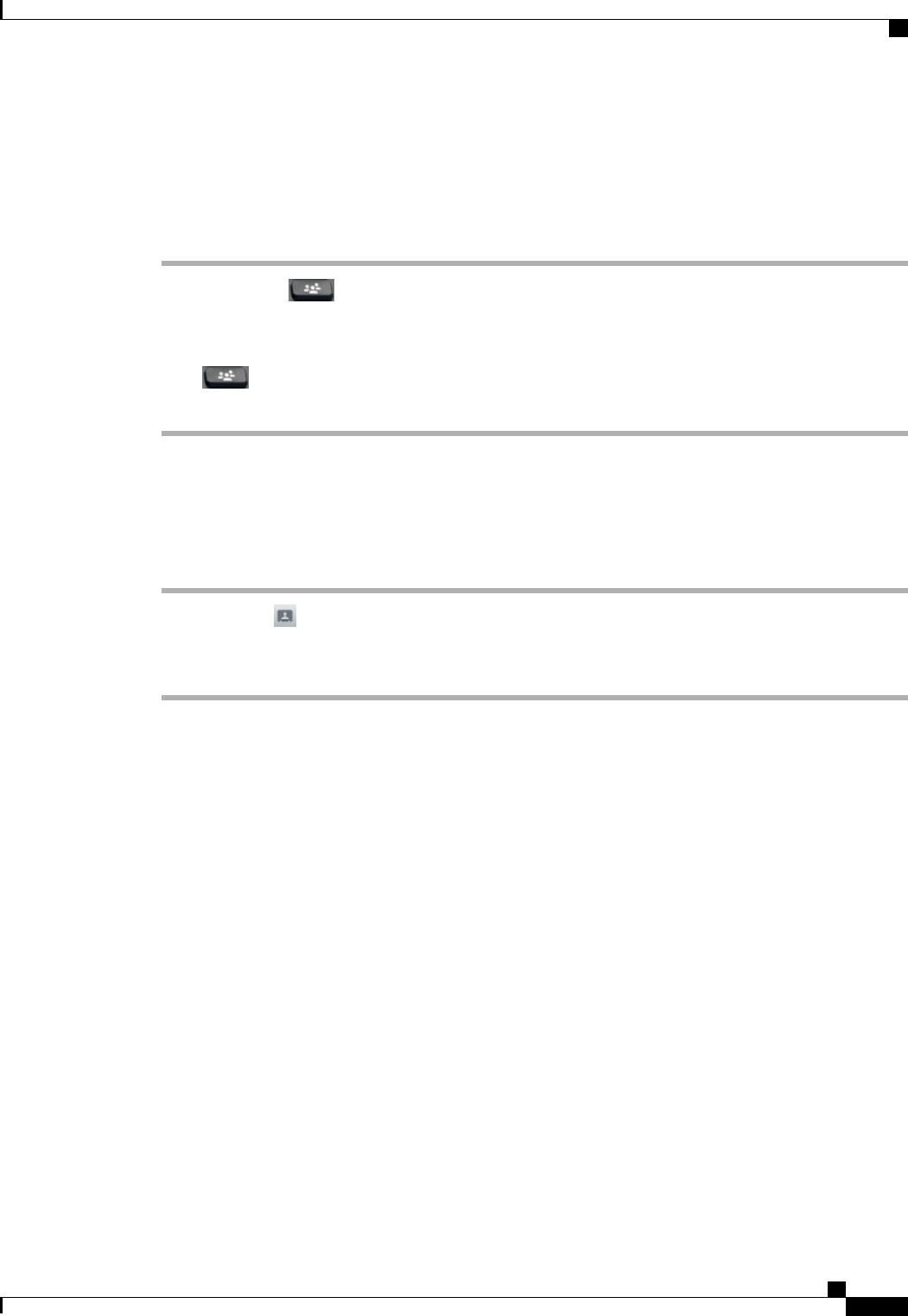
Call participants to create conference
Your system administrator determines whether noninitiators of a conference can add or remove participants.
Procedure
Step 1 From a call, press .
Step 2 Enter the phone number of the participant.
Step 3 Wait for the call to connect.
Step 4 Press again to add the participant to your call.
Step 5 Repeat to add additional participants.
Add contacts to conference
Procedure
Step 1 From a call, tap .
Step 2 Drag a contact from the contact list to the call.
Step 3 Repeat to add additional participants.
Join conference
Join allows you to combine two or more existing calls to create a conference in which you are a participant.
Tips
•If you frequently join more than two parties into a single conference, you may find it useful to first select
the calls that you want to join together, and then tap Join to complete the action.
•When Join completes, the caller ID changes to Conference.
•You may be able to combine multiple conference calls by using the Join button. Contact your system
administrator to see if this feature is available to you.
•A Call Chaperone user can conference only the first caller. The other participants in the conference can
conference subsequent callers.
Cisco Desktop Collaboration Experience DX600 Series User Guide, Release 10.0(1)
OL-28931-01 35
Calling tasks
Conference calls

Join together existing calls on single phone line
Procedure
Step 1 From an active call, highlight another call that you want to include in the conference and tap Select.
Step 2 Repeat this step for each call that you want to add.
Step 3 Tap Join. You may need to tap to see Join.
Join together existing calls on multiple phone lines
Procedure
Step 1 From an active call, highlight a call on another line that you want to include in the conference and tap Select.
Step 2 Repeat this step for each call that you want to add.
Step 3 Tap Join. You may need to tap to see Join.
Barge conference
You can create a conference by using cBarge to add yourself to a call on a shared line.
Related Topics
Barge, cBarge, and shared lines, on page 54
Barge call on shared line to create conference
Procedure
Tap the line button for the shared line.
Meet Me conference
Meet Me conferencing enables you to start or join a conference by calling the conference number.
Tips
•If you call a secure Meet Me conference number from a nonsecure phone, your phone displays the
message Device Not Authorized. For more information, see Secure calls, on page 52.
•A Meet Me conference ends when all participants hang up.
Cisco Desktop Collaboration Experience DX600 Series User Guide, Release 10.0(1)
36 OL-28931-01
Calling tasks
Conference calls

•If the conference initiator disconnects, the conference call continues until all participants hang up.
Start Meet Me conference
Participants cannot join the conference until the initiator starts the conference.
Procedure
Step 1 Obtain a Meet Me phone number from your system administrator.
Step 2 Distribute the number to participants.
Step 3 When you are ready to start the meeting, go off-hook to get a dial tone, then tap Meet Me.
Step 4 Dial the Meet Me conference number.
Participants can now join the conference by dialing the Meet Me number.
Join Meet Me conference
Procedure
Step 1 Dial the Meet Me conference number that the conference initiator provides.
Step 2 If you hear a busy tone, the conference initiator has not joined the conference. Wait a minute and then try
your call again.
Conference participants list
During a standard (ad hoc) conference, you can view a list of participants and remove participants.
Control conference with participants list
The conference participants list displays conference participants.
Procedure
Step 1 Tap Conference List.
Participants are listed in the order in which they join the conference with the most recent additions at the top.
Step 2 To remove any conference participant, highlight the participant and tap End Call.
You can remove participants only if you initiated the conference call.
Cisco Desktop Collaboration Experience DX600 Series User Guide, Release 10.0(1)
OL-28931-01 37
Calling tasks
Conference calls

Call forward
You can use the call forwarding features to redirect incoming calls from your phone to another number.
Your system administrator may allow you to choose from two types of call forwarding features:
•Unconditional call forwarding (Call Forward All): Applies to all calls that you receive.
•Conditional call forwarding (Call Forward No Answer, Call Forward Busy, Call Forward No Coverage):
Applies to certain calls that you receive, according to conditions.
You can access Call Forward All on your phone or from your Cisco Unified Communications Manager User
Options web pages. Conditional call forwarding features are accessible only from your User Options web
pages. Your system administrator determines which call forwarding features are available to you.
Tips
•Enter the call forward target number exactly as you would dial it from your phone. For example, enter
an access code or the area code, if necessary.
•You can forward your calls to a traditional analog phone or to another phone, although your system
administrator may restrict the call forwarding feature to numbers within your company.
•Call forwarding is specific to the phone line. If a call reaches you on a line where call forwarding is not
enabled, the call rings as usual.
•Your system administrator can enable a call forward override feature that allows the person receiving
your forwarded calls to reach you. With override enabled, a call placed from the target phone to your
phone is not forwarded, but rings through.
•Your phone may reject your attempt to set up Call Forward All directly on the phone if the target number
that you enter creates a call forwarding loop or exceeds the maximum number of links that are permitted
in a call forwarding chain.
•When you switch an in-progress call from your mobile phone to Cisco DX600 Series phones that share
the same line (Session Handoff), the phone disables the Call Forward feature. The Call Forward feature
returns when the call ends.
•To verify that your primary line has Call Forward All enabled look for:
◦The call forward icon above your primary phone number.
◦The call forward target number in the status line.
Related Topics
Line settings on web, on page 77
User Options web page actions, on page 71
Cisco Desktop Collaboration Experience DX600 Series User Guide, Release 10.0(1)
38 OL-28931-01
Calling tasks
Call forward

Set up and cancel Call Forward All from phone
Procedure
Step 1 To set Call Forward All, tap Forward All Calls and enter a target phone number.
Step 2 To cancel Call Forward All, tap Forward All Calls.
Set up or cancel call forwarding
When call forwarding is enabled for any line other than the primary line, your phone does not provide you
with confirmation that calls are being forwarded. Instead, you must confirm your settings in the User Options
web pages.
Procedure
Step 1 Log in to your User Options web pages.
Step 2 Access your call forwarding settings.
Call Park
You park a call when you want to store the call so that you or someone else can retrieve it from another phone
in the Cisco Unified Communications Manager system (for example, a phone at a coworker’s desk or in a
conference room).
Use these methods to park a call:
•Call Park: Use Park to store the call. Your phone displays the call park number where the system stored
your call. You must record this number and then use the same number to retrieve the call.
•Directed Call Park: Tap Transfer during a call. To store the call, dial the Directed Call Park number
and tap Transfer again.
•Assisted Directed Call Park: Tap the Directed Call Park button that displays an idle line status indicator.
To retrieve the call from any other phone in your network, tap the flashing Directed Call Park button.
Tips
•You have a limited amount of time to retrieve a parked call before it reverts to ringing at the original
number. Contact your system administrator for details.
•You can dial Directed Call Park numbers if you do not have Directed Call Park buttons. However, you
cannot see the status of the directed call park number.
Cisco Desktop Collaboration Experience DX600 Series User Guide, Release 10.0(1)
OL-28931-01 39
Calling tasks
Call Park

Store and retrieve active call with Call Park
Procedure
Step 1 During a call, tap Park. You may need to tap to see Park.
Step 2 Record the call park number that is displayed on your phone screen.
Step 3 Hang up.
Step 4 To pick up the parked call, enter the Call Park number from any phone in your network.
Direct and store active call at Directed Call Park number
Procedure
Step 1 During a call, tap Transfer.
Step 2 Select a speed-dial number that is assigned to a Directed Call Park number or dial the number.
Step 3 Tap Transfer again to finish storing the call.
Retrieve parked call from Directed Call Park number
Procedure
From any phone in your network, enter the park retrieval prefix and dial the Directed Call Park number.
Direct, store, and retrieve active call at Assisted Directed Call Park number
Procedure
Step 1 During a call, tap the Direct Call Park button that displays an idle line status indicator.
Step 2 To retrieve the call, tap the flashing Direct Call Park button.
If your administrator has not configured a reversion directory number, the parked call reverts to the phone
that parked the call.
Cisco Desktop Collaboration Experience DX600 Series User Guide, Release 10.0(1)
40 OL-28931-01
Calling tasks
Call Park

Call Pickup
Call Pickup enables you to answer a call that is ringing on a coworker’s phone by redirecting the call to your
phone. You might use Call Pickup if you share call-handling tasks with coworkers.
Tips
•If multiple calls are available for pickup, your phone picks up the oldest call first (the call that has been
ringing for the longest time).
•If you tap Pickup or Group Pickup and enter a line number, your phone picks up the ringing call on
that particular line (if available).
•If you have multiple lines and want to pick up the call on a nonprimary line, first tap the line button for
the desired line, then tap Pickup or Group Pickup.
•Depending on how your phone is configured, you might receive an audio or visual alert about a call to
your pickup group.
Answer call ringing on another extension within Call Pickup group
Procedure
Step 1 Tap Pickup.
If your phone supports autopickup, you are now connected to the call.
Step 2 If the call rings, tap Answer to connect to the call.
Answer call ringing on another extension outside Call Pickup group
Procedure
Step 1 Tap Group Pickup.
Step 2 Enter the group pickup number.
If your phone supports autopickup, you are now connected to the call.
Step 3 If the call rings, tap Answer to connect to the call.
Cisco Desktop Collaboration Experience DX600 Series User Guide, Release 10.0(1)
OL-28931-01 41
Calling tasks
Call Pickup

Answer call ringing on another extension in group or in associated group
Procedure
Step 1 Tap Pickup.
If your phone supports autopickup, you are now connected to the call.
Step 2 If the call rings, tap Answer to connect to the call.
Answer call ringing on particular extension
Procedure
Step 1 Tap Group Pickup.
Step 2 Enter the line number with the call that you want to pick up. For example, if the call that you want to pick up
is ringing on line 12345, enter 12345.
If your phone supports autopickup, you are now connected to the call.
Step 3 If the call rings, tap Answer to connect to the call.
Call transfer
Transfer redirects a call. The target is the number to which you want to transfer the call.
Tips
•If on-hook transfer is enabled on your phone, you can either hang up to complete the call, or tap Transfer
and then hang up.
•If on-hook transfer is not enabled on your phone, hanging up without tapping Transfer again places the
call on hold.
•You cannot use Transfer to redirect a call that is on hold. Tap Resume to remove the call from hold
before transferring it.
•When a call is chaperoned, the call chaperone cannot use transfer.
•To redirect a call to a voice message system, tap iDivert.
Cisco Desktop Collaboration Experience DX600 Series User Guide, Release 10.0(1)
42 OL-28931-01
Calling tasks
Call transfer

Transfer call without talking to transfer recipient
Procedure
Step 1 From an active call, tap Transfer.
Step 2 Enter the target number.
Step 3 Tap Transfer again to complete the transfer or EndCall to cancel.
Step 4 If your phone has on-hook transfer enabled, complete the transfer by hanging up.
Talk to transfer recipient before transferring call
Procedure
Step 1 From an active call, tap Transfer.
Step 2 Enter the target number.
Step 3 Wait for the transfer recipient to answer.
Step 4 Tap Transfer again to complete the transfer or EndCall to cancel.
Step 5 If your phone has on-hook transfer enabled, complete the transfer by hanging up.
Call transfer to voice message system
You can use Divert to send an active, ringing, or held call to your voice message system. Depending on the
type of call and your phone configuration, you can also use Divert to send the call to the voice message system
of another party.
•If the call was originally sent to the phone of another person, Divert allows you to redirect the call either
to your own voice message system or to the voice message system of the original called party. Your
system administrator makes this option available to you.
•If the call is sent to you directly (not transferred or forwarded to you), or if your phone does not support
the option described above, using Divert redirects the call to your voice message system.
Tips
•If your phone displays a menu that disappears before you make your selection, tap Divert again to
redisplay the menu. You can also contact your system administrator to configure a longer timeout value.
•When you switch an in-progress call from your mobile phone to a Cisco DX600 Series phone that shares
the same line (Session Handoff), the Divert feature is disabled on the Cisco DX600 Series phone. The
Divert feature returns when the call ends.
Cisco Desktop Collaboration Experience DX600 Series User Guide, Release 10.0(1)
OL-28931-01 43
Calling tasks
Call transfer to voice message system

Send active, ringing, or held call to voice message system
Procedure
Step 1 Tap Divert.
If you have no redirect options available, the call transfers to your voice message system.
Step 2 If you have redirect options available, your phone displays a new menu. Choose an option to redirect the call.
Dial from corporate directory on personal computer using Cisco Web Dialer
Procedure
Step 1 Open a web browser and go to a Web Dialer-enabled corporate directory.
Step 2 Click the number that you want to dial.
Notify when busy or ringing extension available
When a call is being chaperoned, the call chaperone cannot use CallBack.Note
Procedure
Step 1 Tap Call Back while listening to the busy tone or ring sound.
Step 2 Hang up. Your phone alerts you when the line is free.
Step 3 Tap the call back notification to place the call again.
Cisco Desktop Collaboration Experience DX600 Series User Guide, Release 10.0(1)
44 OL-28931-01
Calling tasks
Dial from corporate directory on personal computer using Cisco Web Dialer

Dial from corporate directory on phone
Procedure
Step 1 Tap .
Step 2 Enter a name in the Search field. This will search your local contacts and the corporate directory.
Step 3 Highlight a listing and go off-hook.
Do Not Disturb
Do Not Disturb (DND) turns off all audible and visual notifications of incoming calls. Your system administrator
enables DND on your phone.
When DND and Call Forward are enabled on your phone, calls forward immediately and the caller does not
hear a busy tone.
DND interaction with other types of calls includes:
•DND does not affect intercom calls or nonintercom priority calls.
•If both DND and AutoAnswer are enabled, only intercom calls autoanswer.
•When you switch an in-progress call from your mobile phone to a Cisco DX600 Series phone that share
the same line (Session Handoff), the Cisco DX600 Series phone disables the DND feature. The DND
feature returns when the call ends.
Turn DND on and off
Procedure
Step 1 To turn DND on, tap Do Not Disturb. You may need to tap if Do Not Disturb is not visible.
Step 2 To turn DND off, tap Do Not Disturb again.
Set up DND settings
If your system administrator configured DND settings to appear on the User Options page, perform these
steps:
Cisco Desktop Collaboration Experience DX600 Series User Guide, Release 10.0(1)
OL-28931-01 45
Calling tasks
Dial from corporate directory on phone

Procedure
Step 1 Log in to your User Options web pages.
Step 2 From the drop-down menu, choose User Options >Device.
Step 3 You can set the following options:
•Do Not Disturb: Set to enable/disable DND.
•DND Option: Choose either Call Reject (to turn off all audible and visual notifications) or Ringer Off
(to turn off only the ringer).
•DND Incoming Call Alert (applies to either DND option set): Set the alert to beep only, flash only,
disable the alert, or choose “None”(to use the “Alert”setting configured by your system administrator).
Hunt groups
If your organization receives a large number of incoming calls, you may be a member of a hunt group, which
includes a series of directory numbers that share the incoming call load. When the first directory number in
the hunt group is busy, the system hunts for the next available directory number in the group and directs the
call to that phone.
When you are away from your phone, you can prevent hunt group calls from ringing your phone by logging
out of hunt groups.
Logging out of hunt groups does not prevent non-hunt-group calls from ringing your phone.
Sign in and out of hunt groups
Procedure
Step 1 Tap Sign In. You are now signed into the Hunt Group.
Step 2 Tap Sign Out.
Active call movement
You can switch active calls between the desktop phone and your mobile phone or other remote destination.
Cisco Desktop Collaboration Experience DX600 Series User Guide, Release 10.0(1)
46 OL-28931-01
Calling tasks
Hunt groups

Switch active call on desk phone to mobile phone
Procedure
Step 1 Tap Mobility and select Send call to mobile.
Step 2 Answer the active call on your mobile phone.
The handset icons and the calling party number appear on the phone display. You cannot use the same phone
line for any other calls, but if your desk phone supports multiple lines, you can use another line to make or
receive calls.
Switch active call from mobile phone to desk phone
Procedure
Step 1 Hang up the call on your mobile phone to disconnect the mobile phone but not the call.
Step 2 Tap Resume on your desk phone within 4 seconds and start talking on the desk phone.
Switch active call from mobile phone to desk phone that shares same line
Procedure
Step 1 While on your mobile phone, enter the access code for the Session Handoff feature (for example, *74). Contact
your system administrator for a list of access codes.
Step 2 Hang up the call on your mobile phone to disconnect the mobile phone but not the call.
Step 3 Tap Answer on your desk phone within 10 seconds and start talking on the desk phone. Your system
administrator sets the maximum number of seconds you have to answer the call on your desk phone.
Cisco Unified IP phones that share the same line display a Remote in Use message.
Intercom calls
You can place an intercom call to a target phone that autoanswers the call in speakerphone mode with mute
enabled. The one-way intercom call allows you to deliver a short message to the recipient. The audio plays
on the handset or headset, if one of these is in use. Any current call activity that your recipient is engaged in
continues simultaneously.
When you receive an intercom-alert tone, you can choose one of these options:
Cisco Desktop Collaboration Experience DX600 Series User Guide, Release 10.0(1)
OL-28931-01 47
Calling tasks
Intercom calls

•Listen to the caller with your microphone muted (you can hear the caller, but the caller cannot hear you).
•End the intercom call by tapping End Call with the intercom call in focus. Do this if you do not want
to hear the message.
•Talk to the caller by tapping the active intercom button and using either the handset, headset, or speaker.
The intercom call becomes a two-way connection so that you can converse with the caller.
When using the intercom feature, be aware of the following:
•From an intercom line, you can only dial other intercom lines.
•You can use only one intercom line at a time.
•When your active call is being monitored or recorded, you can receive or place intercom calls.
•You cannot place an intercom call on hold.
If you sign in to the same phone on a daily basis using your Cisco Extension Mobility profile, ensure that
your system administrator assigns the phone button template that contains intercom information to this
profile and assign the phone as the default intercom device for the intercom line.
Note
Place intercom call to preconfigured intercom number
Procedure
Step 1 Tap a dedicated intercom line.
Step 2 After you hear the intercom-alert tone, begin speaking.
Place intercom call to any intercom number
Procedure
Step 1 Tap a dialable intercom line.
Step 2 Enter the intercom target number or tap a speed-dial number for your target.
Step 3 After you hear the intercom-alert tone, begin speaking.
Cisco Desktop Collaboration Experience DX600 Series User Guide, Release 10.0(1)
48 OL-28931-01
Calling tasks
Intercom calls

Receive intercom call
Procedure
When you hear the intercom-alert tone, handle the call in one of these ways:
•Listen to the message in one-way audio.
•Speak to the caller by tapping Connect.
•Tap Decline.
Line status features
Line status features allow you to view the state of a phone line that is associated with a speed-dial button, call
history, or directory listing on your phone. If you use Line Status Pickup, you can answer a ringing call for
the line that you are monitoring. Your system administrator determines which line status features are set up
on your phone.
Then...If you want to...
Look for one of these line status indicators next to the line number:
•Line is in-use.
•Line is idle.
•Line is in Do Not Disturb state.
•Line status indicator unavailable for this line.
See the state of a line
listed in a call history
or directory
Look for one of these line status indicators next to the line number:
•Line is in-use.
•Line is idle.
•Line is in Do Not Disturb state.
•Line is ringing (Line Status Pickup only).
•Line status indicator unavailable for this line.
See the state of a
speed-dial line
Tips
•Your phone may play an audible indicator to alert you when a call is ringing on the monitored line (Line
Status Pickup only).
•Line Status Pickup answers the oldest ringing call first, if the line that you are monitoring has more than
one ringing call.
Cisco Desktop Collaboration Experience DX600 Series User Guide, Release 10.0(1)
OL-28931-01 49
Calling tasks
Line status features

•If you press the Line Status Pickup button when the monitored line is not ringing, your phone will speed
dial the line number.
Use line status pickup to answer ringing call
Procedure
Step 1 If the current line is ringing, tap the Line Status Pickup button.
The call redirects to the next available line on your phone.
Step 2 If you want to specify a line, first press a line button and then tap the line status button.
If your phone supports autopickup, the call connects automatically.
Step 3 If the call rings on your phone, answer it.
Make call from mobile phone using mobile voice access
Procedure
Step 1 Obtain your Mobile Voice Access number and PIN from your system administrator.
Step 2 Dial your assigned Mobile Voice access number.
Step 3 Enter your mobile phone number (if requested) and PIN.
Step 4 Press 1to make a call to an enterprise IP Phone.
Step 5 Dial a desktop phone number other than your desktop phone number.
Multiple calls
Understanding how multiple calls display on your phone can help you organize your call-handling efforts.
In standard viewing mode, your phone displays calls as follows for the highlighted line:
•Calls with the highest precedence and longest duration display at the top of the list.
•Calls of a similar type are grouped together. For example, calls that you have interacted with are grouped
near the top, and calls on hold are grouped last.
You can switch between multiple calls on one or more lines.
Cisco Desktop Collaboration Experience DX600 Series User Guide, Release 10.0(1)
50 OL-28931-01
Calling tasks
Make call from mobile phone using mobile voice access

Switch between calls on one line
Procedure
Step 1 Highlight the call you want to switch to.
Step 2 Tap Resume.
Any active call is placed on hold and the selected call resumes.
Switch between calls on different lines
Procedure
Step 1 Select the line that you are switching to.
If a single call is holding on the line, the call automatically resumes.
Step 2 If multiple calls are holding, highlight the appropriate call and tap Resume.
Switch from active call to answer ringing call
Procedure
Perform one of the following actions:
•Tap Answer.
•If the call is ringing on a different line, select that line.
The phone places the active call on hold and the selected call resumes.
Remove call from hold on current line
Procedure
Step 1 Highlight the appropriate call.
Step 2 Tap Resume.
Cisco Desktop Collaboration Experience DX600 Series User Guide, Release 10.0(1)
OL-28931-01 51
Calling tasks
Multiple calls

Place call while another call is active (using different line)
Procedure
Step 1 Tap a new line. The first call is automatically placed on hold.
Step 2 Enter a number.
Secure calls
Depending on how your system administrator configured your phone system, your phone may support making
and receiving secure calls.
Your phone can support these types of calls:
Authenticated call
The identities of the phones participating in the call have been verified.
Encrypted call
The phone is receiving and transmitting encrypted audio (your conversation) within the Cisco Unified
Communications Manager network. Encrypted calls are authenticated.
Protected call
The phone is a secure (encrypted and trusted) device on the Cisco Unified Communications Manager
server and is configured as a Protected Device in Cisco Unified Communications Manager
Administration.
If Play Secure Indication Tone is enabled (True) in Cisco Unified Communications Manager
Administration, the protected phone plays a secure or nonsecure indication tone at the beginning of the
call:
•When end-to-end secure media is established through the Secure Real-Time Transfer Protocol
(SRTP) and the call status is secure, the phone plays the secure indication tone (three long beeps
with brief pauses).
•When end-to-end nonsecure media is established through the Real-Time Protocol (RTP) and the
call status is nonsecure, the phone plays the nonsecure indication tone (six short beeps with brief
pauses).
If the Play Secure Indication Tone option is disabled (False), no tone plays.
Nonprotected call
The phone does not have a Protected Device status in Cisco Unified Communications Manager. No
secure or nonsecure indication tone is played.
Cisco Desktop Collaboration Experience DX600 Series User Guide, Release 10.0(1)
52 OL-28931-01
Calling tasks
Place call while another call is active (using different line)

Nonsecure call
The phone is not protected on the Cisco Unified Communications Manager server and the call status
is nonsecure.
Then...If you want to...
Look for a security icon in the top right corner of the call activity
area, next to the call duration timer:
•Authenticated call or conference
•Encrypted call or conference
•Nonsecure call or conference
Check the security level of a call or
conference
Listen for a secure indication tone at the beginning of the call:
•Secure call status: If the phone is protected, the Play Secure
Indication Tone is enabled, and the call status is secure, a
secure indication tone plays on the protected phone at the
beginning of a call (three long beeps with pauses). The lock
icon is also present to indicate that the call is secure.
•Nonsecure call status: If the phone is protected, the Play
Secure Indication Tone is enabled, and the call status is
nonsecure, a nonsecure indication tone plays on the protected
phone at the beginning of a call (six short beeps with brief
pauses). The play arrow icon is also present to indicate that
the call is not secure.
For more information, contact your system administrator.
Verify that the phone connection (call
status) is secure.
Contact your system administrator.Determine whether secure calls can be
made in your company
There are interactions, restrictions, and limitations that affect how security features work on your phone. For
more information, contact your system administrator.
Cisco determines that a device that is engaged in a call is either trusted or untrusted. Lock or shield icons
are not displayed on a Cisco DX650 screen when a call is to or from an untrusted device, even though the
call might be secure.
Note
VPN client
Your system administrator configures the Virtual Private Network (VPN) Client feature as needed.
Related Topics
AnyConnect VPN, on page 66
Cisco Desktop Collaboration Experience DX600 Series User Guide, Release 10.0(1)
OL-28931-01 53
Calling tasks
Secure calls

Shared lines
Your system administrator might ask you to use a shared line if you:
•Have multiple phones and want one phone number
•Share call-handling tasks with coworkers
•Handle calls on behalf of a manager
Remote-in-use icon
The remote-in-use icon appears when another phone that shares your line has a connected call. You can place
and receive calls as usual on the shared line, even when the remote-in-use icon appears.
Call information and Barge
Phones that share a line each display information about calls that are placed and received on the shared line.
This information might include caller ID and call duration. See the Privacy section for exceptions.
When call information is visible in this way, you and the coworkers who share a line can use Barge or cBarge
to join a call.
Barge, cBarge, and shared lines
You can use barge features (cBarge or Barge) to add yourself to calls on your shared line. Calls must be
nonprivate calls.
Depending on how your phone is configured, you can add yourself to a nonprivate call on a shared line using
either cBarge or Barge:
•cBarge converts the call into a standard conference, allowing you to add new participants.
•Barge enables you to add yourself to the call but does not convert the call into a conference or allow
you to add new participants.
Related Topics
Shared lines, on page 54
Conference calls, on page 34
Single-button and multitouch Barge
Your system administrator determines whether the barge feature on your phone operates as a single-button
or multitouch feature.
•Single-button barge allows you to press a line button to barge a call (if only one call is on the line).
•Multitouch barge allows you to view call information before barging.
Cisco Desktop Collaboration Experience DX600 Series User Guide, Release 10.0(1)
54 OL-28931-01
Calling tasks
Shared lines

Barge features
The table below describes how to use barge features (cBarge or Barge) to add yourself to a call on a shared
line.
Then...If you want to...
Look for the remote-in-use icon.See if the shared line is in
use
Tap the line button for the shared line. You see one of these results:
•You are added to the call.
•A window opens on your phone screen prompting you to select the call
that you want to barge. Tap Barge or cBarge to complete the action. You
may need to tap to display Barge or cBarge.
Add yourself to a call on
a shared line
Tips
•When you Barge a call, other parties may hear a beep announcing your presence. With cBarge, other
parties hear a brief audio interruption and the phone screen changes to display conference details.
•If a phone that is using the shared line has Privacy enabled, call information and barge buttons do not
appear on the other phones that share the line.
•If a phone that is using the shared line has Privacy disabled and is configured with Private Line Automated
Ringdown (PLAR), the Barge and cBarge features are available.
•You will be disconnected from a call that you have joined using Barge if the call is put on hold, transferred,
or turned into a conference call.
Related Topics
Conference participants list, on page 37
Privacy and shared lines
If you share a phone line, use the Privacy feature to prevent others who share the line from viewing or barging
(adding themselves to) your calls.
Tips
•If the phone that shares your line has Privacy enabled, you can place and receive calls using the shared
line as usual.
•The Privacy feature applies to all shared lines on your phone. Consequently, if you have multiple shared
lines and Privacy is enabled, coworkers cannot view or barge calls on any of your shared lines.
Cisco Desktop Collaboration Experience DX600 Series User Guide, Release 10.0(1)
OL-28931-01 55
Calling tasks
Shared lines

Prevent and allow others to view or barge calls on shared line
Procedure
Step 1 To prevent others from viewing or barging a call on a shared line,
a) Tap Private.
b) To verify that Privacy is on, look for the Privacy-enabled icon.
Step 2 To allow others to view or barge calls on a shared line,
a) Tap Private.
b) To verify that Privacy is off, look to see that the Privacy-enabled icon has disappeared.
Speed Dial
Speed Dial enables you to enter an index number, or tap a phone screen item to place a call. Depending on
configuration, your phone can support several speed-dial features:
•Speed-dial buttons
•Abbreviated Dialing
To set up speed-dial buttons and Abbreviated Dial, tap Add a speed dial and follow the on-screen prompts.
There is a brief interruption to telephony service after you add a speed dial. Alternately, your system
administrator can configure speed-dial features for you.
Make call using Speed-Dial button
If your phone supports the line status speed-dial feature, you can see if the speed-dial number is busy before
dialing.
Procedure
Step 1 Set up speed-dial numbers.
Step 2 To place a call, tap a speed-dial icon. Or, drag the icon to the idle screen to prepopulate the phone number.
Cisco Desktop Collaboration Experience DX600 Series User Guide, Release 10.0(1)
56 OL-28931-01
Calling tasks
Speed Dial

Make call using on-hook abbreviated dial
Procedure
Step 1 Set up Abbreviated Dialing codes.
Step 2 To place a call, enter the Abbreviated Dialing code.
Suspicious call trace
If you are receiving suspicious or malicious calls, your system administrator can add the Malicious Call
Identification (MCID) feature to your phone. This feature enables you to identify an active call as suspicious,
which initiates a series of automated tracking and notification messages.
Notify system administrator about suspicious or harassing call
Procedure
Step 1 Tap Report.
Step 2 Tap Report Caller.
Your phone displays the message The caller has been reported as malicious. Your
administrator receives notification about the call with supporting information to take appropriate actions.
Cisco Desktop Collaboration Experience DX600 Series User Guide, Release 10.0(1)
OL-28931-01 57
Calling tasks
Suspicious call trace

Cisco Desktop Collaboration Experience DX600 Series User Guide, Release 10.0(1)
58 OL-28931-01
Calling tasks
Suspicious call trace

CHAPTER 4
Phone customization and settings
You can personalize your phone by adjusting the ringtone and other settings.
•Rings and message indicator customization, page 59
•Phone screen customization, page 61
•Networks, page 62
Rings and message indicator customization
You can customize how your phone indicates an incoming call and a new voicemail message. You can also
adjust the ringer volume for your phone.
Tip
You can customize your phone to have up to six distinctive ringtones. In addition, you can have a default
ringtone.
Related Topics
User Options web page actions, on page 71
Line settings on web, on page 77
Cisco Desktop Collaboration Experience DX600 Series User Guide, Release 10.0(1)
OL-28931-01 59

Change ringtone
Procedure
Step 1 Tap .
Step 2 Tap Settings.
Step 3 Tap Sound.
Step 4 Tap Phone Ringtone.
Step 5 Tap a ringtone to play a sample of it.
Step 6 Select a ringtone and tap OK.
Adjust phone ringer volume level
Check with your system administrator to see if a minimum ringer volume setting was configured.
Procedure
Press while the handset is in the cradle and the headset and speakerphone buttons are off. The
new ringer volume is saved automatically.
Change ring pattern
Before you can access this setting, your system administrator might need to enable it for you.
Procedure
Step 1 Log in to your User Options web pages.
Step 2 Access your call ring pattern settings.
Cisco Desktop Collaboration Experience DX600 Series User Guide, Release 10.0(1)
60 OL-28931-01
Phone customization and settings
Change ringtone

Change audible voice-message indicator
Procedure
Step 1 Log in to your User Options web pages.
Step 2 Access your message indicator settings.
Change how voice message light on handset works
Procedure
Step 1 Log in to your User Options web pages.
Step 2 Choose Change the Message Waiting Lamp policy.
Step 3 Access your message indicator settings. Typically, the default system policy is to indicate a new voice message
by displaying a steady light on the handset light strip.
Phone screen customization
You can adjust the characteristics of the phone screen.
Change phone screen language
Procedure
Step 1 Log in to your User Options web pages.
Step 2 Access your user settings.
Step 3 Select a language.
Cisco Desktop Collaboration Experience DX600 Series User Guide, Release 10.0(1)
OL-28931-01 61
Phone customization and settings
Change audible voice-message indicator

Change phone screen brightness
If you change the brightness setting on your phone, do not unplug the phone from its power source for at
least one minute or the brightness setting will not get saved.
Note
Procedure
Step 1 Tap Settings.
Step 2 To make adjustments, slide the brightness indicator up or down.
Change line text label
Procedure
Step 1 Log in to your User Options web pages.
Step 2 Access your line text label settings.
Networks
Connect your Cisco DX650 to a network before launching an Internet application such as the email or browser
application.
You can connect to an Ethernet or wireless network. Wi-Fi is disabled while your phone is connected to an
Ethernet network.
You can add a total of four wireless network profiles.
Wired network connection
You can connect your Cisco DX650 to a wired network.
You can also share a wired connection between a computer and your phone.
If you restart your phone with the Lock button, network connectivity may be disrupted.Note
Cisco Desktop Collaboration Experience DX600 Series User Guide, Release 10.0(1)
62 OL-28931-01
Phone customization and settings
Change phone screen brightness
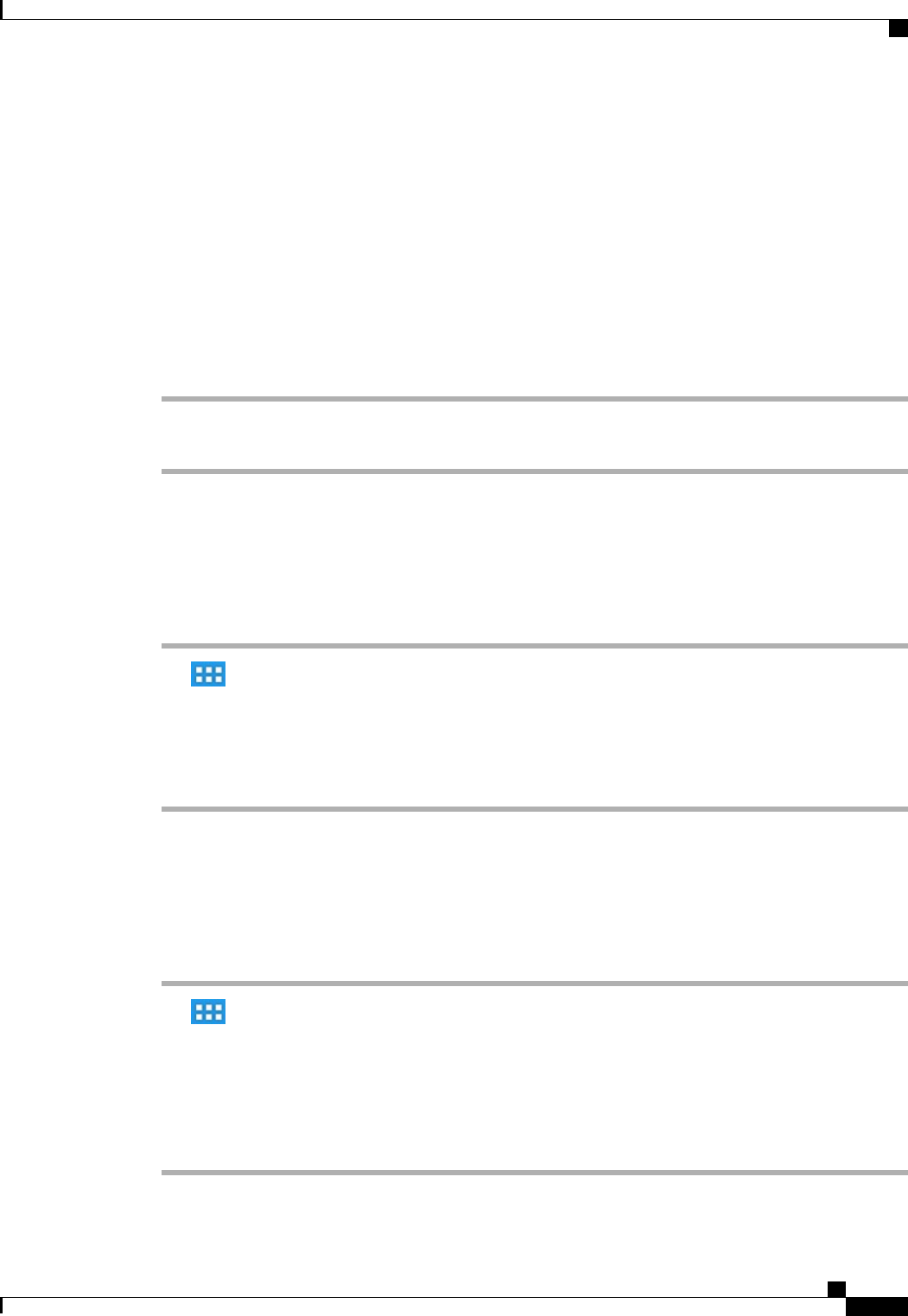
Connect to wired network
Procedure
Connect an Ethernet cable from the network port to the network.
Share wired network connection with computer
Procedure
Step 1 Connect an Ethernet cable from the network port to the network.
Step 2 Connect an Ethernet cable from the computer port to a network port on the computer.
Connect to wireless network
Procedure
Step 1 Tap .
Step 2 Tap Settings.
Step 3 Toggle on Wi-Fi.
Step 4 Select a wireless network from the list of available networks.
Step 5 Enter your credentials and tap Connect.
Connect to hidden wireless network
Procedure
Step 1 Tap .
Step 2 Tap Settings.
Step 3 Toggle on Wi-Fi.
Step 4 Tap Add Network.
Step 5 Enter the Network Service Set Identifier (SSID), select the Security, enter your credentials and tap Save.
Step 6 Select the network and tap Connect.
Cisco Desktop Collaboration Experience DX600 Series User Guide, Release 10.0(1)
OL-28931-01 63
Phone customization and settings
Connect to wireless network
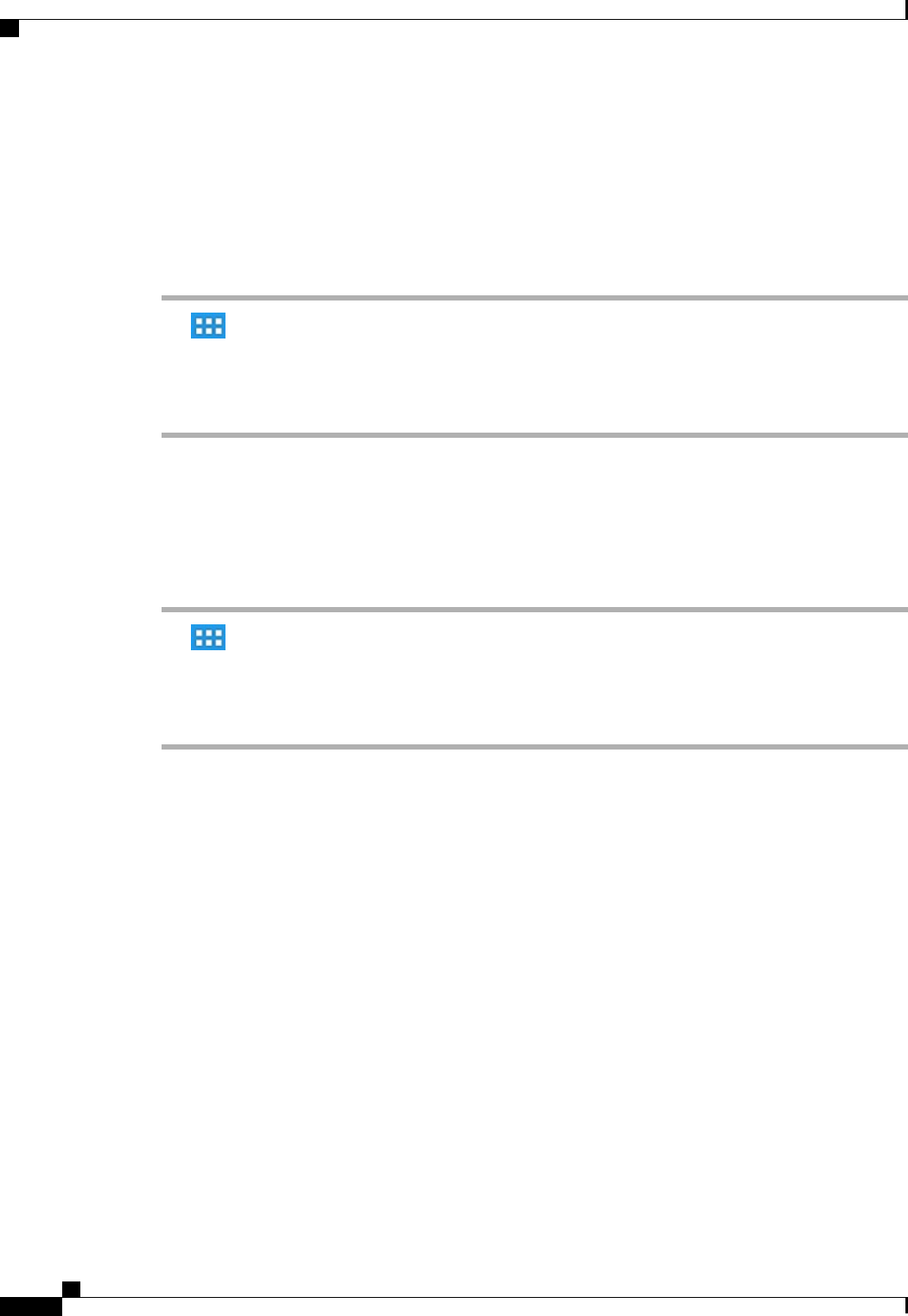
Edit wireless network
Procedure
Step 1 Tap .
Step 2 Tap Settings.
Step 3 Long press a wireless network from the list of available networks.
Step 4 Tap Modify Network.
Delete wireless network
Procedure
Step 1 Tap .
Step 2 Tap Settings.
Step 3 Long press a wireless network from the list of available networks.
Step 4 Tap Forget Network.
Supported wireless security
Cisco DX650 supports the following security types:
•None (open)
•WEP (Static)
•WPA/WPA2-PSK
•802.1x EAP (FAST/EAP-FAST, PEAP-GTC, PEAP-MSCHAPv2, TLS/EAP-TLS)
Contact your system administrator for more information.
Web proxy
Depending on your security settings, you may need to connect to a web proxy to access the Internet. If a VPN
is enabled, you cannot use a web proxy with that VPN. Contact your system administrator for more information.
Cisco Desktop Collaboration Experience DX600 Series User Guide, Release 10.0(1)
64 OL-28931-01
Phone customization and settings
Edit wireless network
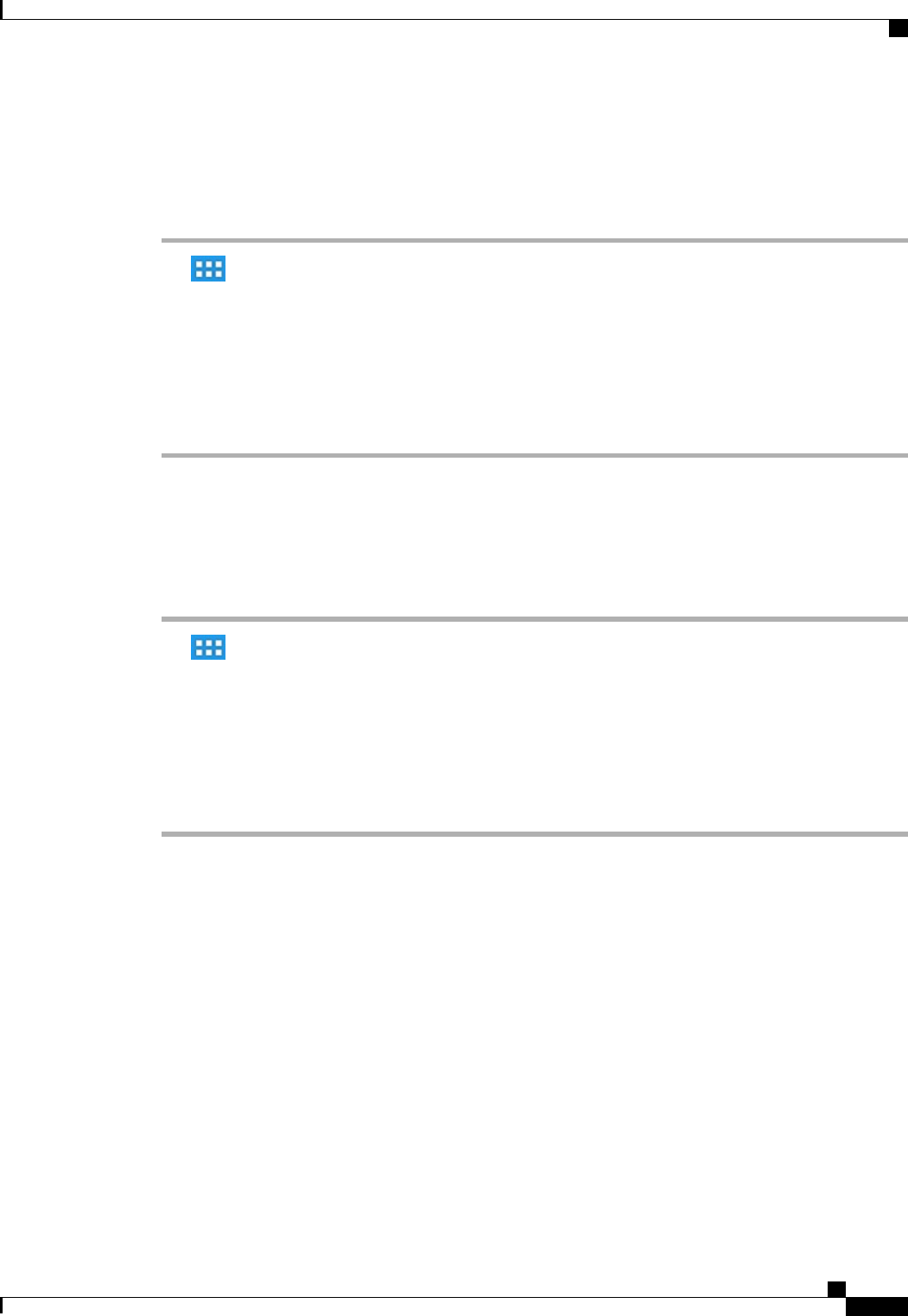
Add web proxy
Procedure
Step 1 Tap .
Step 2 Tap Settings.
Step 3 Tap Wireless & Networks.
Step 4 Tap Proxy Settings.
Step 5 Tap Proxy.
Step 6 Tap Add Proxy.
Step 7 Enter the Web Proxy settings and tap Save.
Edit web proxy
Procedure
Step 1 Tap .
Step 2 Tap Settings.
Step 3 Tap Wireless & Networks.
Step 4 Tap Proxy Settings.
Step 5 Tap and hold a proxy from the list of available proxies.
Step 6 Tap Modify.
Step 7 Edit the Web Proxy settings and tap Save.
Cisco Desktop Collaboration Experience DX600 Series User Guide, Release 10.0(1)
OL-28931-01 65
Phone customization and settings
Web proxy
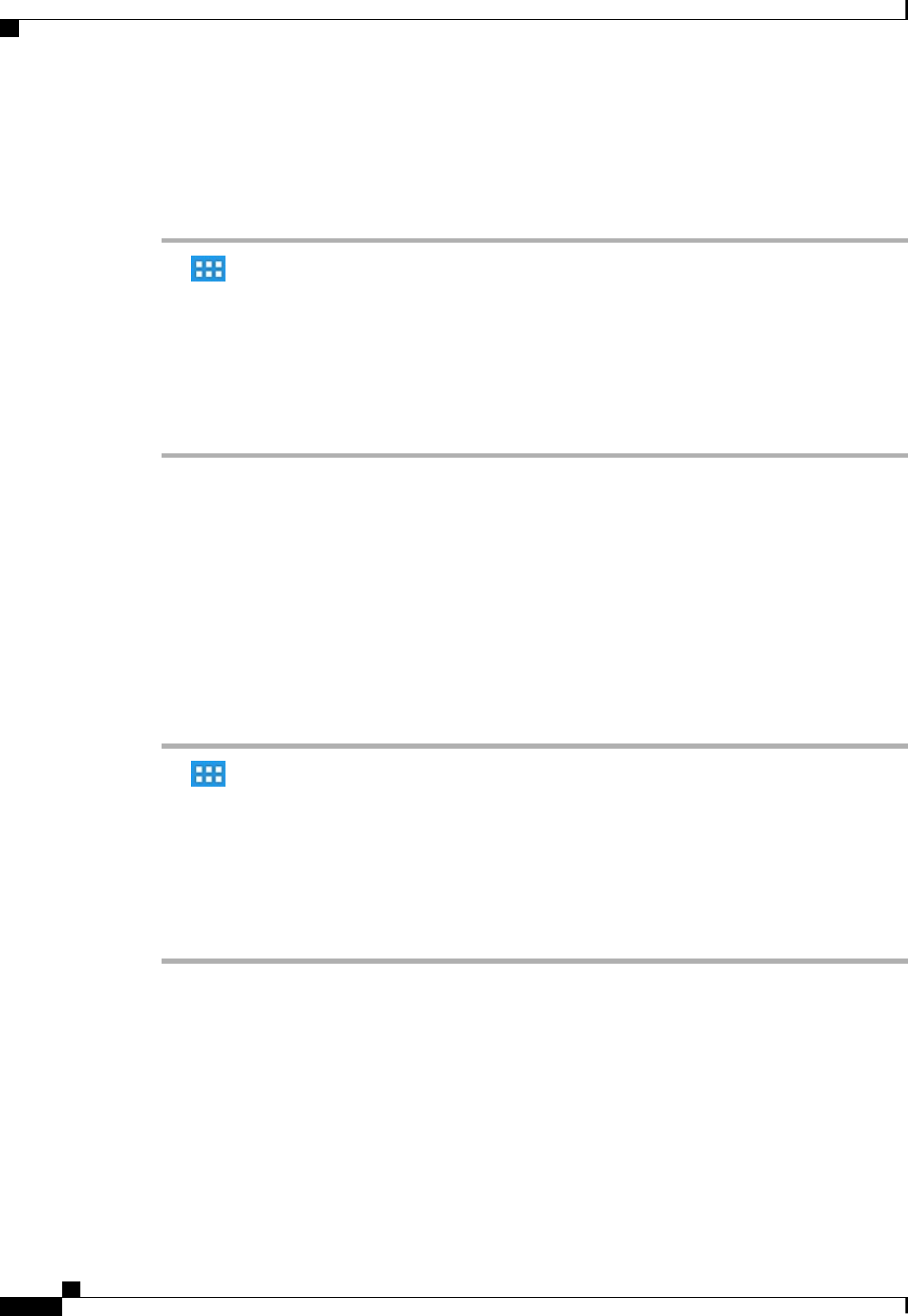
Delete web proxy
Procedure
Step 1 Tap .
Step 2 Tap Settings.
Step 3 Tap Wireless & Networks.
Step 4 Tap Proxy Settings.
Step 5 Tap and hold a proxy from the list of available proxies.
Step 6 Tap Delete.
Step 7 Tap Yes.
TFTP
Connect to a Trivial File Transfer Protocol (TFTP) server for phone configuration, connectivity, and to receive
firmware updates. Contact your system administrator for a TFTP server address.
Connect to TFTP Server
Procedure
Step 1 Tap .
Step 2 Tap Settings.
Step 3 Tap More.
Step 4 Tap TFTP Server Settings.
Step 5 Tap Use Alternate TFTP Server.
Step 6 Tap TFTP Server1.
Step 7 Enter the TFTP server address and tap OK.
AnyConnect VPN
Your system administrator sets up the AnyConnect VPN application. AnyConnect VPN allows you to have
secure remote access to corporate resources on your Cisco DX650. For security reasons, it is usually
recommended that you connect to a VPN through a wired network connection.
If your system administrator has set up a VPN connection profile for you with Cisco Unified Communications
Manager, it will appear in the VPN Connection list. You cannot edit or delete these VPN connections.
Cisco Desktop Collaboration Experience DX600 Series User Guide, Release 10.0(1)
66 OL-28931-01
Phone customization and settings
TFTP
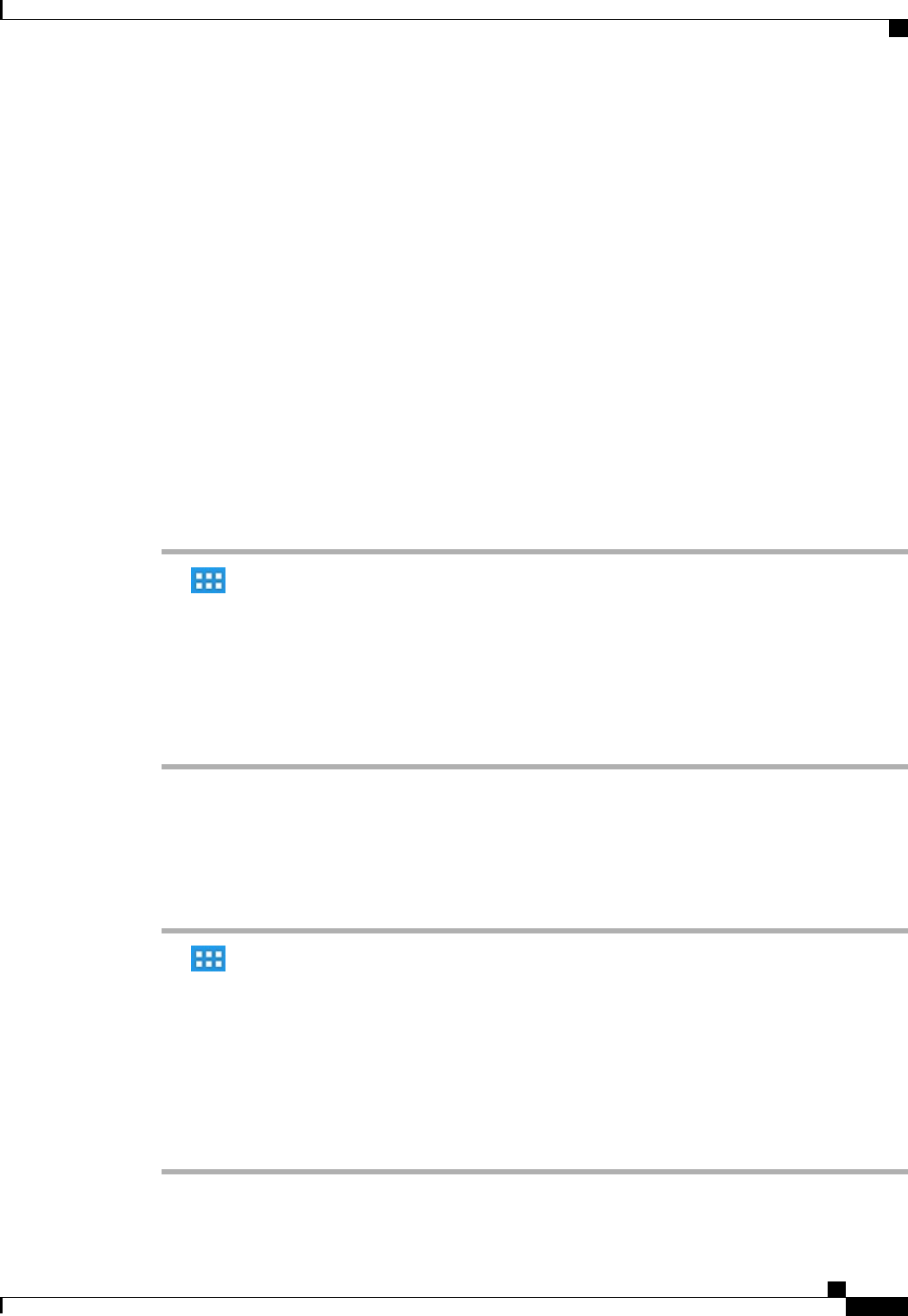
Your system administrator can enable you to create and edit your own VPN connections.
AutoNetDetect
If your system administrator enables the AutoNetDetect feature for a VPN connection profile that is set up
with Cisco Unified Communications Manager, your phone will automatically attempt to establish a VPN
connection.
Password persistence
If your system administrator enables the Password Persistence feature for a VPN connection profile that is
set up with Cisco Unified Communications Manager, the AnyConnect VPN application will store a previously
successful password. You cannot change a working password.
Add VPN connection profile
Procedure
Step 1 Tap .
Step 2 Tap Settings.
Step 3 Tap More.
Step 4 Tap VPN .
Step 5 Tap Add VPN Network.
Step 6 Enter a description of the VPN connection and the server address.
Step 7 Tap Save.
Edit VPN connection profile
Procedure
Step 1 Tap .
Step 2 Tap Settings.
Step 3 Tap More.
Step 4 Tap VPN.
Step 5 Tap and hold a VPN connection.
Step 6 Tap Edit Network.
Step 7 Edit the connection description or server address.
Step 8 Tap Save.
Cisco Desktop Collaboration Experience DX600 Series User Guide, Release 10.0(1)
OL-28931-01 67
Phone customization and settings
AnyConnect VPN
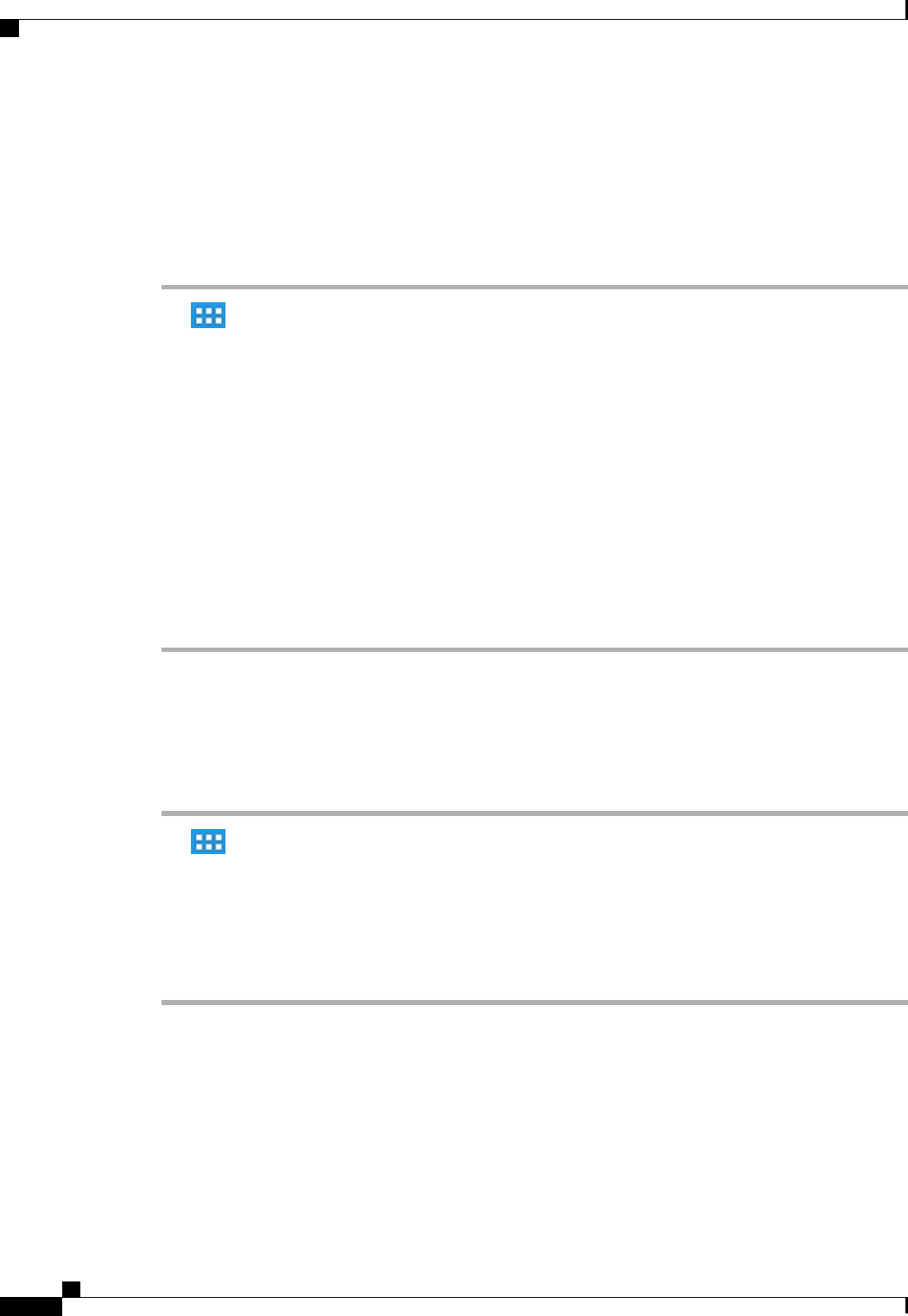
Connect to VPN
Procedure
Step 1 Tap .
Step 2 Tap Settings.
Step 3 Tap More.
Step 4 Tap VPN.
Step 5 Tap and hold a VPN connection.
Step 6 If necessary, do either of the following in response to the appropriate prompts:
•Enter your credentials. If prompted to do so, also enter your secondary credentials to support double
authentication.
•Tap Get Certificate, then enter the certificate enrollment credentials that are supplied by your system
administrator. AnyConnect saves the certificate and reconnects to the VPN secure gateway to use the
certificate for authentication.
Step 7 Tap Connect.
Disconnect from VPN
Procedure
Step 1 Tap .
Step 2 Tap Settings.
Step 3 Tap More.
Step 4 Tap VPN.
Step 5 Tap and hold a VPN connection.
Step 6 Tap Disconnect.
Cisco Desktop Collaboration Experience DX600 Series User Guide, Release 10.0(1)
68 OL-28931-01
Phone customization and settings
AnyConnect VPN

Delete VPN connection profile
Procedure
Step 1 Tap .
Step 2 Tap Settings.
Step 3 Tap More.
Step 4 Tap VPN.
Step 5 Tap and hold a VPN connection.
Step 6 Tap Delete Network.
Cisco Desktop Collaboration Experience DX600 Series User Guide, Release 10.0(1)
OL-28931-01 69
Phone customization and settings
AnyConnect VPN

Cisco Desktop Collaboration Experience DX600 Series User Guide, Release 10.0(1)
70 OL-28931-01
Phone customization and settings
AnyConnect VPN

CHAPTER 5
User Options web pages
Your Cisco DX650 is a network device that can share information with other network devices in your
company, including your personal computer. You can use your computer to log in to your Cisco Unified
Communications Manager User Options web pages, where you control features, settings, and services for
your phone. For example, you can set up speed-dial buttons from your User Options web pages.
•User Options web page actions, page 71
•Features and services setup on web, page 72
User Options web page actions
This section describes how to log in and select a phone device.
Sign in and out of User Options web pages
Before you can access any of your user options, you must sign in. When you are finished using the User
Options web pages, you must sign out.
In some cases, you can access your User Option web pages without having to sign in. For more information,
contact your system administrator.
Procedure
Step 1 Obtain the User Options URL, user ID, and default password from your system administrator.
Step 2 Open a web browser on your computer and enter the URL.
Step 3 If prompted to accept security settings, select Yes or Install Certificate.
Step 4 Enter your user ID in the Username field.
Step 5 Enter your password in the Password field.
Step 6 Select Login.
Cisco Desktop Collaboration Experience DX600 Series User Guide, Release 10.0(1)
OL-28931-01 71

The Cisco Unified CM User Options home page displays. From this page you can select User Options to
select a device, access User Settings, Directory features, and Fast Dials.
Step 7 To sign out of your User Options web pages, select Logout.
Select device from User Options web page
Procedure
Step 1 On your User Options web page, select User Options >Device.
The Device Configuration window displays. Toolbar buttons located at the top of the Device Configuration
window are specific to the selected device type.
Step 2 (Optional) If you have multiple devices assigned to you, select the appropriate device (phone model, Extension
Mobility profile, or Remote Destination profile) from the Name drop-down menu.
Select configuration option
Procedure
Step 1 After you have logged in to your User Options web pages, choose User Options to access User Settings,
Directory, Fast Dials, and Mobility Settings.
Step 2 To return to the Device Configuration page from another page, choose User Options >Device.
Features and services setup on web
The topics in this section describe how to configure features and services from your User Options web pages
after logging in.
Speed Dial setup on web
Depending on configuration, your phone can support several speed-dial features:
•Speed-dial buttons
•Abbreviated Dialing
•Fast Dials
Cisco Desktop Collaboration Experience DX600 Series User Guide, Release 10.0(1)
72 OL-28931-01
User Options web pages
Select device from User Options web page

Set up speed-dial buttons
Procedure
Step 1 On your User Options web page, select User Options >Device.
Step 2 Select a phone from the Name drop-down menu.
Step 3 Select Speed Dials.
Step 4 In the Speed Dial Settings area, enter a number and label for a speed-dial button on your phone.
Step 5 Select Save.
Set up abbreviated dialing codes
Procedure
Step 1 Select User Options >Device.
Step 2 Select a phone from the Name drop-down list.
Step 3 Select Speed Dials.
Step 4 Enter a number and label for an Abbreviated Dialing code.
Step 5 Select Save.
Phone services setup on web
Phone services can include special phone features, network data, and web-based information (for example,
stock quotes and movie listings). You must first subscribe to a phone service before accessing it on your
phone.
The services available for your phone depend on the phone system configuration and the services you subscribed
to. Contact your system administrator for more information.
Cisco Desktop Collaboration Experience DX600 Series User Guide, Release 10.0(1)
OL-28931-01 73
User Options web pages
Phone services setup on web

Subscribe to service
Procedure
Step 1 On your User Options web page, select User Options >Device.
Step 2 Select a phone from the Name drop-down menu.
Step 3 Select Phone Services.
Step 4 Select Add New.
Step 5 Select a service from the drop-down list and select Next.
Step 6 (Optional) Change the service label or enter additional service information, if available.
Step 7 Select Save.
Search for services
Procedure
Step 1 On your User Options web page, select a device.
Step 2 Select Phone Services.
Step 3 Select Find.
Change or end services
Procedure
Step 1 On your User Options web page, search for services.
Step 2 Select one or more entries.
Step 3 Select Delete Selected.
Cisco Desktop Collaboration Experience DX600 Series User Guide, Release 10.0(1)
74 OL-28931-01
User Options web pages
Phone services setup on web

Change service name
Procedure
Step 1 On your User Options web page, search for services.
Step 2 Select a service name.
Step 3 Change the information and select Save.
Add service to programmable feature button
Procedure
Step 1 On your User Options web page, select User Options >Device.
Step 2 Select a phone from the Name drop-down menu.
Step 3 Select Service URL.
Your system administrator sets up a service URL button for your phone.
Step 4 Select a service from the Button Service drop-down list .
Step 5 (Optional) If you want to rename the service, edit the label fields.
If your phone does not support double-byte character sets, it uses ASCII Label fields.
Step 6 Select Save.
Step 7 Select Reset to reset your phone to see the new button label on your phone.
User settings on web
User settings include your password, PIN, and language (locale) settings.
Your PIN and password allow you to access different features and services. For example, use your PIN to log
in to Cisco Extension Mobility or Personal Directory on your phone. Use your password to log in to your
User Options web pages and Cisco Web Dialer on your personal computer. For more information, contact
your system administrator.
Cisco Desktop Collaboration Experience DX600 Series User Guide, Release 10.0(1)
OL-28931-01 75
User Options web pages
User settings on web

Change browser password
Procedure
Step 1 Sign in to your User Options web pages.
Step 2 Select User Options >User Settings.
Step 3 Enter your Current Password.
Step 4 Enter your New Password.
Step 5 Reenter your new password in the Confirm Password field.
Step 6 Select Save.
Change PIN
Procedure
Step 1 Sign in to your User Options web pages.
Step 2 Select User Options >User Settings.
Step 3 Enter your Current PIN.
Step 4 Enter your New PIN.
Step 5 Reenter your new PIN in the Confirm PIN field.
Step 6 Select Save.
Change User Options web page language setting
Procedure
Step 1 Sign in to your User Options web page.
Step 2 Select User Options >User Settings.
Step 3 In the User Locale area, select an item from the Locale drop-down list.
Step 4 Select Save.
Cisco Desktop Collaboration Experience DX600 Series User Guide, Release 10.0(1)
76 OL-28931-01
User Options web pages
User settings on web

Change phone display language
Procedure
Step 1 Sign in to your User Options web page.
Step 2 Select User Options >Device.
Step 3 Select an item from the User Locale drop-down list.
Step 4 Select Save.
Line settings on web
Line settings affect a specific phone line (directory number) on your phone. Line settings can include
call-forwarding, voice message indicators, ring patterns, and line labels.
You can set up other line settings directly on your phone:
•Set up call forwarding for your primary phone line.
•Change rings, display, and other phone-model specific settings.
Related Topics
Call forward, on page 38
Phone customization and settings, on page 59
Set up call forward for each line
Procedure
Step 1 Select User Options >Device.
Step 2 Select a phone from the Name drop-down menu.
Step 3 Select Line Settings.
Step 4 (optional) If you have more than one directory number (line) assigned to your phone, choose a line from the
Line drop-down menu.
Step 5 In the Incoming Call Forwarding area, select Call Forward settings for various conditions.
Step 6 Select Save.
Cisco Desktop Collaboration Experience DX600 Series User Guide, Release 10.0(1)
OL-28931-01 77
User Options web pages
Line settings on web

Change voice message indicator setting for each line
Procedure
Step 1 Select User Options >Device.
Step 2 Select a phone from the Name drop-down menu.
Step 3 Select Line Settings.
Step 4 (optional) If you have more than one directory number (line) assigned to your phone, select a line from the
Line drop-down list.
Step 5 In the Message Waiting Lamp area, choose from various settings.
By default your phone displays a steady red light from the handset light strip to indicate a new voice
message.
Note
Step 6 Select Save.
Change audible voice message indicator setting for each line
Procedure
Step 1 Select User Options >Device.
Step 2 Select a phone from the Name drop-down menu.
Step 3 Select Line Settings.
Step 4 (optional) If you have more than one directory number (line) assigned to your phone, choose a line from the
Line drop-down menu.
Step 5 In the Audible Message Waiting Indicator area, select from various settings.
By default your phone displays a steady red light from the handset light strip to indicate a new voice
message.
Note
Step 6 Select Save.
Cisco Desktop Collaboration Experience DX600 Series User Guide, Release 10.0(1)
78 OL-28931-01
User Options web pages
Line settings on web

Change or create line text label that appears on phone screen
Procedure
Step 1 Select User Options >Device.
Step 2 Select a phone from the Name drop-down menu.
Step 3 Select Line Settings.
Step 4 (optional) If you have more than one directory number (line) assigned to your phone, select a line from the
Line drop-down menu.
Step 5 In the Line Text Label area, enter a text label.
Step 6 Select Save.
Your phone uses the ASCII Label field if the phone does not support double-byte character
sets.
Note
Set up phone and access list for Mobile Connect
You must add your mobile phone (and any other phones you use) to Cisco Mobile Connect, before you can
place and receive calls using the same directory numbers as your desk phone. These phones are called remote
destinations. You can also define access lists to restrict or allow calls from certain numbers to be sent to your
mobile phone.
Create access list
Procedure
Step 1 Sign in to your User Options web page.
Step 2 Select User Options >Mobility Settings >Access Lists.
Step 3 Select Add New.
Step 4 Enter a name to identify the access list and a description (optional).
Step 5 Select whether the access list will allow or block specified calls.
Step 6 Select Save.
Step 7 Select Add Member to add phone numbers or filters to the list.
Step 8 Select an option from the Filter Mask drop-down list box. You can filter a directory number, calls with
restricted caller ID (Not Available), or calls with anonymous caller ID (Private).
Step 9 If you select a directory number from the Filter Mask drop-down list box, enter a phone number or filter in
the DN Mask field.
You can use the following wildcards to define a filter:
•X (upper or lower case): Matches a single digit. For example, 408555123X matches any number between
4085551230 and 4085551239.
Cisco Desktop Collaboration Experience DX600 Series User Guide, Release 10.0(1)
OL-28931-01 79
User Options web pages
Set up phone and access list for Mobile Connect

•!: Matches any number of digits. For example, 408! matches any number that starts with 408.
•#: Used as a single digit for exact match.
Step 10 To add this member to the access list, select Save.
Step 11 To save the access list, select Save.
Add new remote destination
Procedure
Step 1 Sign in to your User Options web page.
Step 2 Select User Options >Mobility Settings >Remote Destinations.
Step 3 Select Add New.
Step 4 Enter the following information:
•Name: Enter a name for the mobile (or other) phone.
•Destination Number: Enter your mobile phone number.
Step 5 Select your remote destination profile from the drop-down list box. Your remote destination profile contains
the settings that apply to remote destinations that you create.
Step 6 Check the Mobile Phone check box to allow your remote destination to accept a call sent from your desk
phone.
Step 7 Check the Enable Mobile Connect check box to allow your remote destination to ring simultaneously with
your desk phone.
Step 8 Select one of the following options in the Ring Schedule area (the ring schedule drop-down list boxes include
only the access lists that you have created):
•All the time: Select this option if you do not want to impose day and time restrictions on ringing the
remote destination.
•As specified below: Select this option and select from the following items to set up a ring schedule based
on day and time:
1Check a check box for each day of the week you want to allow calls to ring the remote destination.
2For each day, select All Day or select the beginning and ending times from the drop-down lists.
3Select the time zone from the drop-down list box.
Step 9 Select one of these ringing options:
•Always ring this destination.
•Ring this destination only if the caller is in the allowed access list that you select.
•Do not ring this destination if the caller is in the blocked access list that you select.
Cisco Desktop Collaboration Experience DX600 Series User Guide, Release 10.0(1)
80 OL-28931-01
User Options web pages
Set up phone and access list for Mobile Connect

Step 10 Select Save.
Cisco Web Dialer
Cisco Web Dialer allows you to place calls on your phone to directory contacts by selecting items in a web
browser. Your system administrator configures this feature for you.
Use WebDialer with User Options directory
Procedure
Step 1 Log in to your User Options web pages.
Step 2 Select User Options >Directory and search for a coworker.
Step 3 Select the number that you want to dial.
Step 4 If this is your first time using WebDialer, set up preferences on the Make Call page.
Step 5 Select Dial.
The call is now placed on your phone.
Step 6 To end a call, select Hangup or hang up from your phone.
Use WebDialer with another online corporate directory
Procedure
Step 1 Log in to a WebDialer-enabled corporate directory and search for coworkers.
Step 2 Click the number that you want to dial.
Step 3 When prompted, enter your user ID and password.
Step 4 If this is your first time using WebDialer, set up preferences on the Make Call page.
Step 5 Click Dial.
The call is now placed on your phone.
Step 6 To end a call, click Hangup or hang up from your phone.
Cisco Desktop Collaboration Experience DX600 Series User Guide, Release 10.0(1)
OL-28931-01 81
User Options web pages
Cisco Web Dialer

Log out of WebDialer
Procedure
Click the Logout icon in the Make Call or Hang Up page.
Set up, view, or change Web Dialer preferences
Procedure
Step 1 Access the Make Call page.
The Make Call page appears the first time that you use Web Dialer (after you click the number that you want
to dial).
Step 2 (Optional) Make changes to your settings.
The Make Call page contains the following options:
•Preferred language: Determines the language that is used for Web Dialer settings and prompts.
•Use preferred device: Identifies the phone (Calling device) and directory number (Calling device or line)
that you use to place WebDialer calls. If you have one phone with a single line, the appropriate phone
and line are automatically selected. Otherwise, choose a phone or line. If you have more than one phone,
it will be specified by device type and MAC address. To display the MAC address on your phone, select
Settings >About device >Status.
If you have an Extension Mobility profile, you can select your Extension Mobility logged-in
device from the Calling device menu.
Note
•Do not display call confirmation: If selected, prompts Web Dialer to suppress the Make Call page. This
page appears by default after you click a phone number in a Web Dialer-enabled online directory.
•Disable Auto Close: If selected, the call window does not close automatically after 15 seconds.
Cisco Desktop Collaboration Experience DX600 Series User Guide, Release 10.0(1)
82 OL-28931-01
User Options web pages
Cisco Web Dialer

CHAPTER 6
Applications
This chapter outlines the Cisco DX650 applications.
•Calendar, page 83
•Contacts, page 87
•Email, page 93
•Jabber IM, page 100
•Unified Inbox, page 106
•WebEx, page 109
•More applications, page 112
Calendar
Tap Day,Week,Month, or Agenda to change your calendar view. Tap Today to return to the Day view of
the current day.
Upcoming appointments are listed on the right side of the screen.
Calendar reminders appear on the notification bar.
The Calendar application is integrated with the Cisco WebEx application.
Calendar account
The Calendar application shares account settings with the Email application. If your email account is already
set up, you do not need to enter that account information again for the Calendar application.
The first time that you open the Calendar application, you are taken to the Settings page to configure your
account credentials, unless you already entered the credentials using the Setup Assistant or the Settings
application.
If you choose not to set up the account credentials right away, use the Settings application to enter the credentials
later.
Cisco Desktop Collaboration Experience DX600 Series User Guide, Release 10.0(1)
OL-28931-01 83
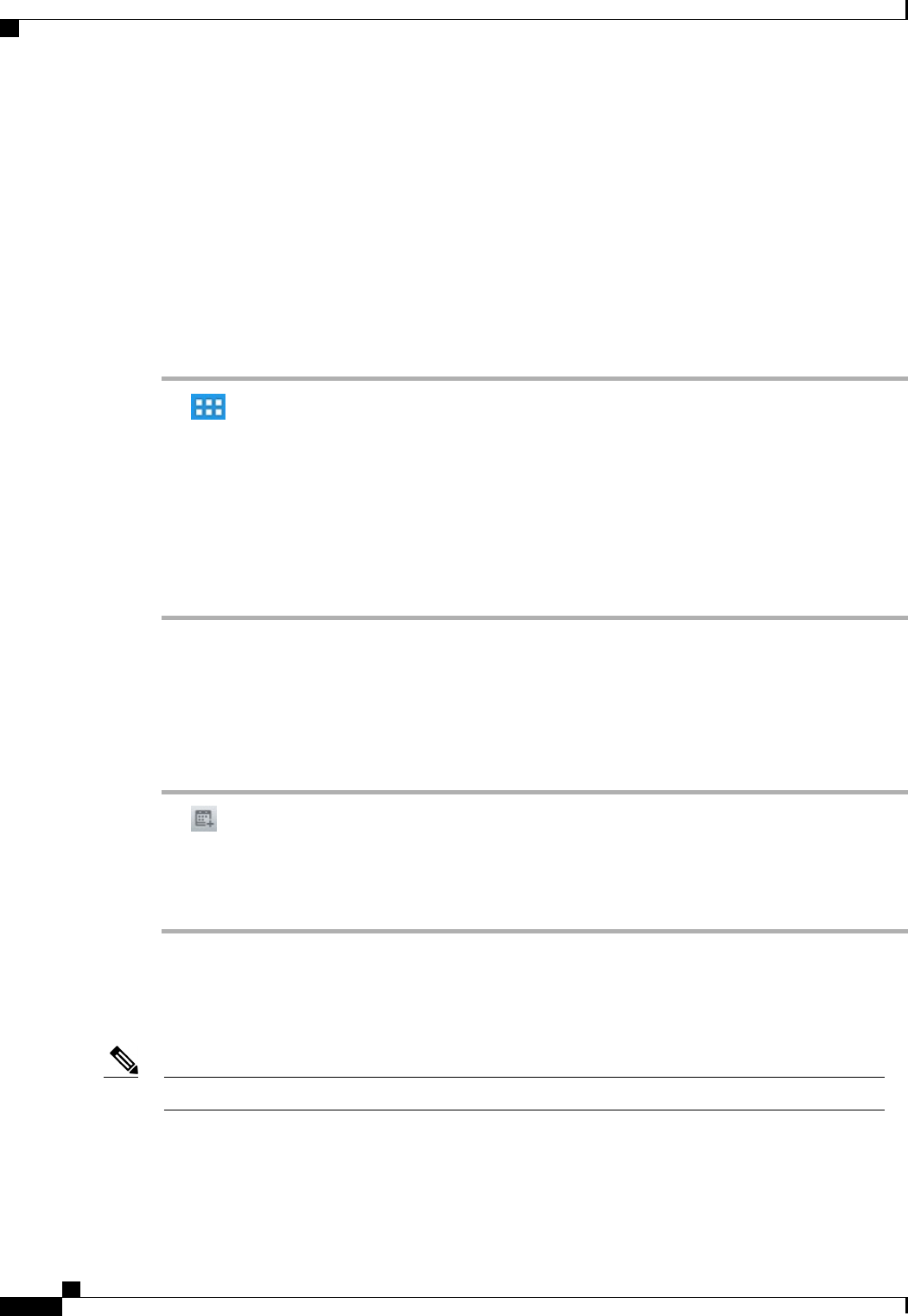
On first use, you are prompted to sign in to Cisco WebEx, where you must enter a valid WebEx account user
ID and password.
Use the Calendar application to set up multiple calendar accounts. ActiveSync can be set up with Google,
Yahoo, and other accounts.
Use the Calendar application to sync your calendar events with Microsoft Outlook and Microsoft Exchange.
Add calendar account
Procedure
Step 1 Tap .
Step 2 Tap Settings.
Step 3 Tap Accounts & Sync.
Step 4 Tap Add Account.
Step 5 Select an account type.
Step 6 Enter the calendar account credentials.
Enter all credentials before you save account settings. The application tries to authenticate credentials before
saving and prompts you to try again when you enter incorrect information.
Add calendar event
Procedure
Step 1 Tap .
Step 2 Enter the details of the event on the Add Event screen.
Step 3 Tap Done.
Your event is displayed in the Day view for the date of the event.
Edit event
Some events cannot be edited.Note
Cisco Desktop Collaboration Experience DX600 Series User Guide, Release 10.0(1)
84 OL-28931-01
Applications
Add calendar event

Procedure
Step 1 Long press an event.
Step 2 Tap .
Step 3 Edit the event.
Step 4 Uncheck the WebEx check box on the Edit Event screen if you do not wish to make a WebEx event.
Step 5 Tap Done.
Delete event
Procedure
Step 1 Long press an event.
Step 2 Tap .
Step 3 Tap OK.
Start scheduled WebEx meeting
Tap Start.
Join scheduled WebEx meeting
Tap Join.
Settings
The Calendar application allows you to edit your settings for declined events, alerts and notifications, and
your default reminder time.
Cisco Desktop Collaboration Experience DX600 Series User Guide, Release 10.0(1)
OL-28931-01 85
Applications
Delete event
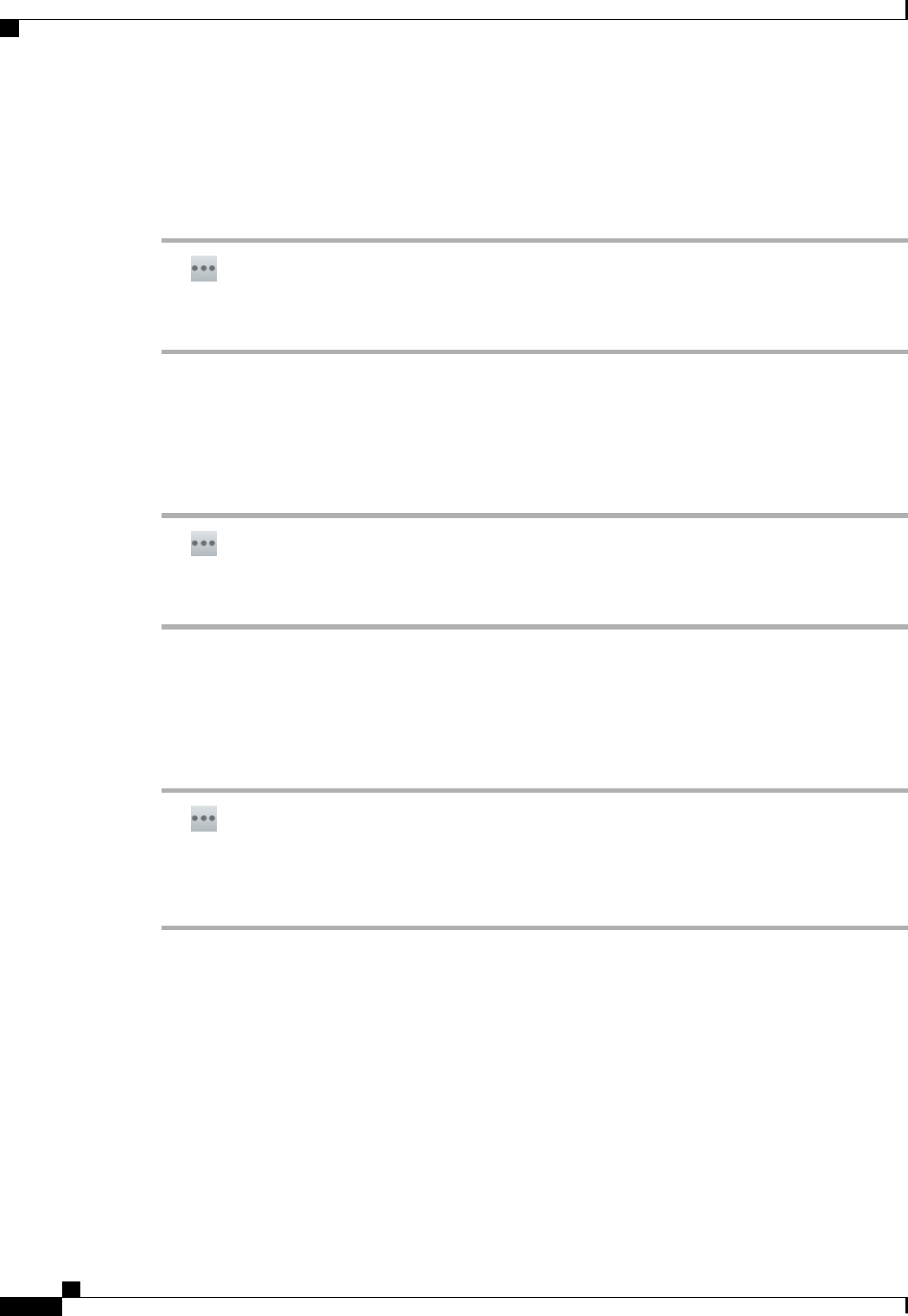
Hide declined events
Procedure
Step 1 Tap .
Step 2 Tap Settings.
Step 3 Tap Hide Declined Events.
Set alerts and notifications
Procedure
Step 1 Tap .
Step 2 Tap Settings.
Step 3 Tap Set Alerts & Notifications.
Select ringtone
Procedure
Step 1 Tap .
Step 2 Tap Settings.
Step 3 Tap Select Ringtone.
Step 4 Select a ringtone and tap OK.
Cisco Desktop Collaboration Experience DX600 Series User Guide, Release 10.0(1)
86 OL-28931-01
Applications
Settings
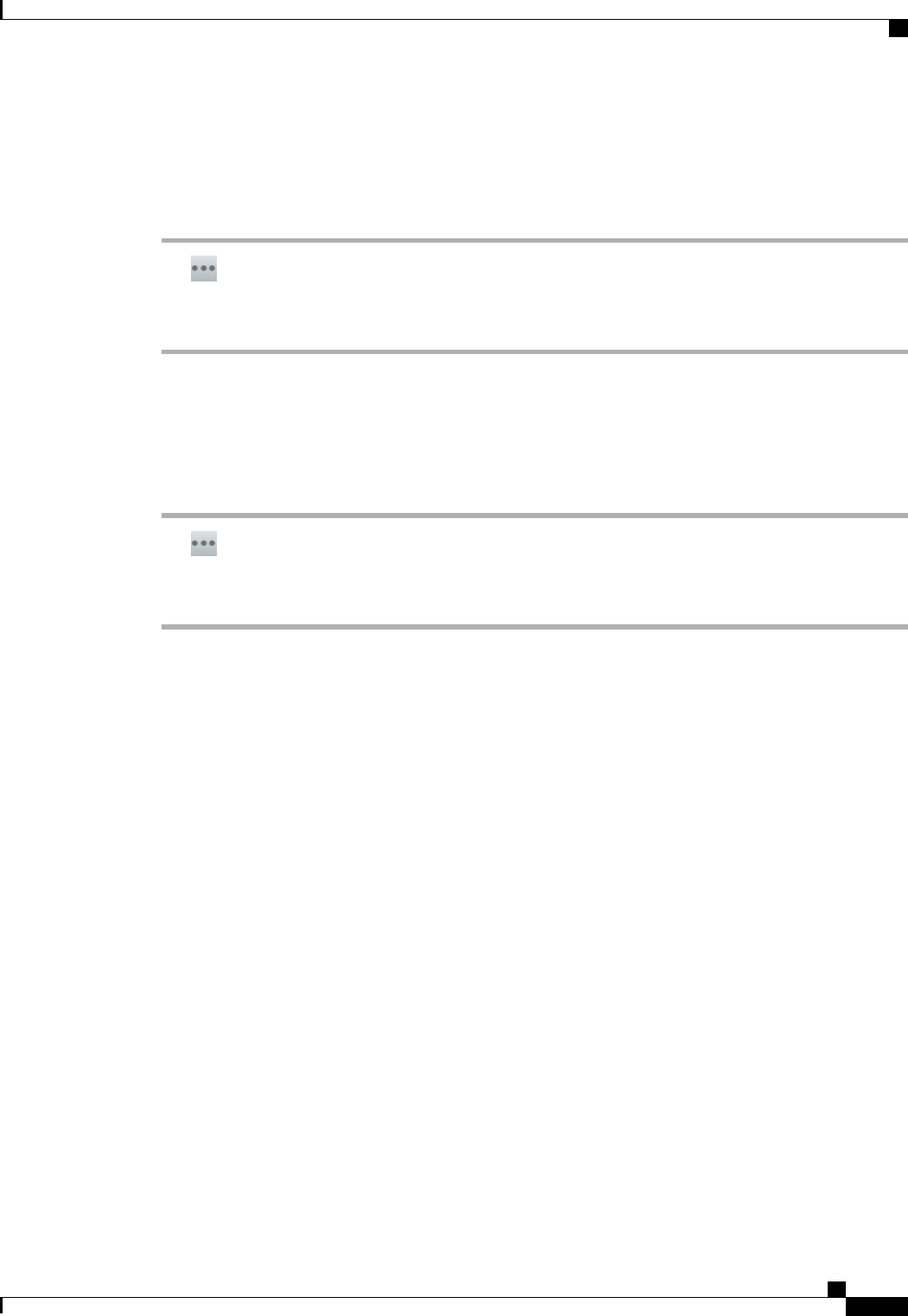
Edit vibrate settings
Procedure
Step 1 Tap .
Step 2 Tap Settings.
Step 3 Tap Vibrate.
Set default reminder time
Procedure
Step 1 Tap .
Step 2 Tap Settings.
Step 3 Tap Default Reminder Time.
Calendar widget
Use the Calendar widget to display your upcoming events on your home screen.
Contacts
Use Contacts to store, sort, and search your contacts. Contacts is integrated into other applications, such as
Email, and also functions as a standalone application.
The first time that you open the Contacts application, you are prompted to create a new contact, sign in to an
account, or to import contacts.
You can view your contacts all together, by group, or view your favorite and most frequent contacts.
Contact details
Tap an entry in your contact list to view details for that contact. From the contact details screen, you can edit
the contact details, mark the contact as a favorite, place a call, start a chat, start a Cisco WebEx meeting, or
send an email message to that contact.
Cisco Desktop Collaboration Experience DX600 Series User Guide, Release 10.0(1)
OL-28931-01 87
Applications
Calendar widget
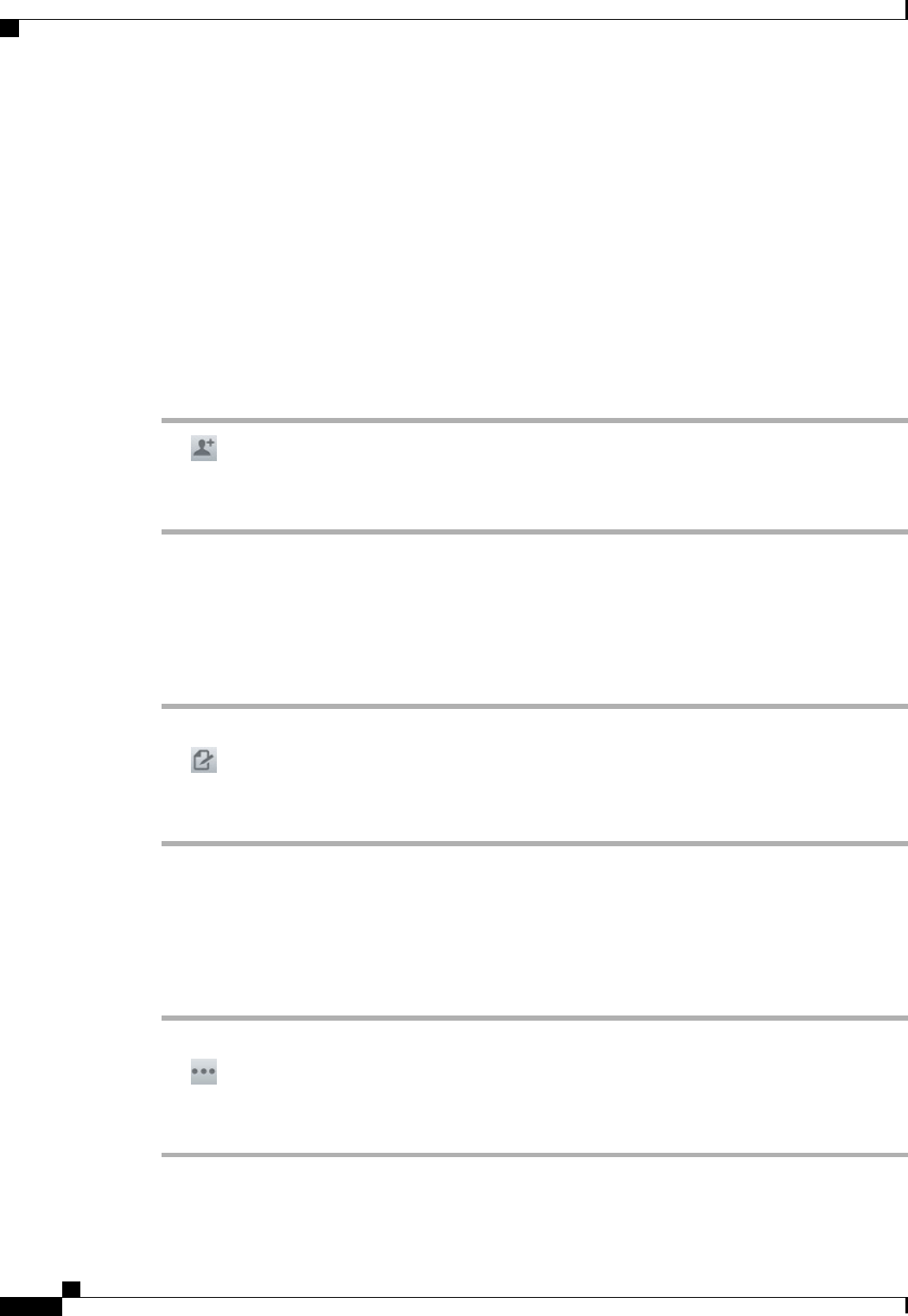
View recent activity
Procedure
To view your recent activity, select the entry for yourself at the top of the contact list.
Add contact
Procedure
Step 1 Tap .
Step 2 Enter the contact name and details
Step 3 Tap Done.
Edit contact
Procedure
Step 1 Select a contact.
Step 2 Tap .
Step 3 Edit the contact information.
Step 4 Tap Done.
Remove contact
Procedure
Step 1 Select a contact.
Step 2 Tap .
Step 3 Tap Delete.
Step 4 Tap OK.
Cisco Desktop Collaboration Experience DX600 Series User Guide, Release 10.0(1)
88 OL-28931-01
Applications
View recent activity

Join contacts
Procedure
Step 1 Select a contact.
Step 2 Tap Join.
Step 3 Select another contact to join.
Step 4 Tap Done.
Share contact
Procedure
Step 1 Tap .
Step 2 Tap Share.
Step 3 Select a service from the Share menu.
Favorites
Tap Favorites to view your favorite and most frequent contacts.
Mark contact as favorite
Procedure
Step 1 Select a contact.
Step 2 Tap .
Step 3 Tap again to unmark the contact as a favorite.
Groups
Use groups to organize your contacts.
Cisco Desktop Collaboration Experience DX600 Series User Guide, Release 10.0(1)
OL-28931-01 89
Applications
Join contacts

Add group
Procedure
Step 1 Tap Groups.
Step 2 Tap .
Step 3 Enter the name of the group.
Step 4 Tap OK.
Delete group
Procedure
Step 1 Select a group.
Step 2 Tap .
Step 3 Tap Delete.
Add contact to group
Procedure
Step 1 Select a group.
Step 2 Tap New Contact.
Step 3 Select a contact.
Step 4 Tap OK.
Cisco Desktop Collaboration Experience DX600 Series User Guide, Release 10.0(1)
90 OL-28931-01
Applications
Groups
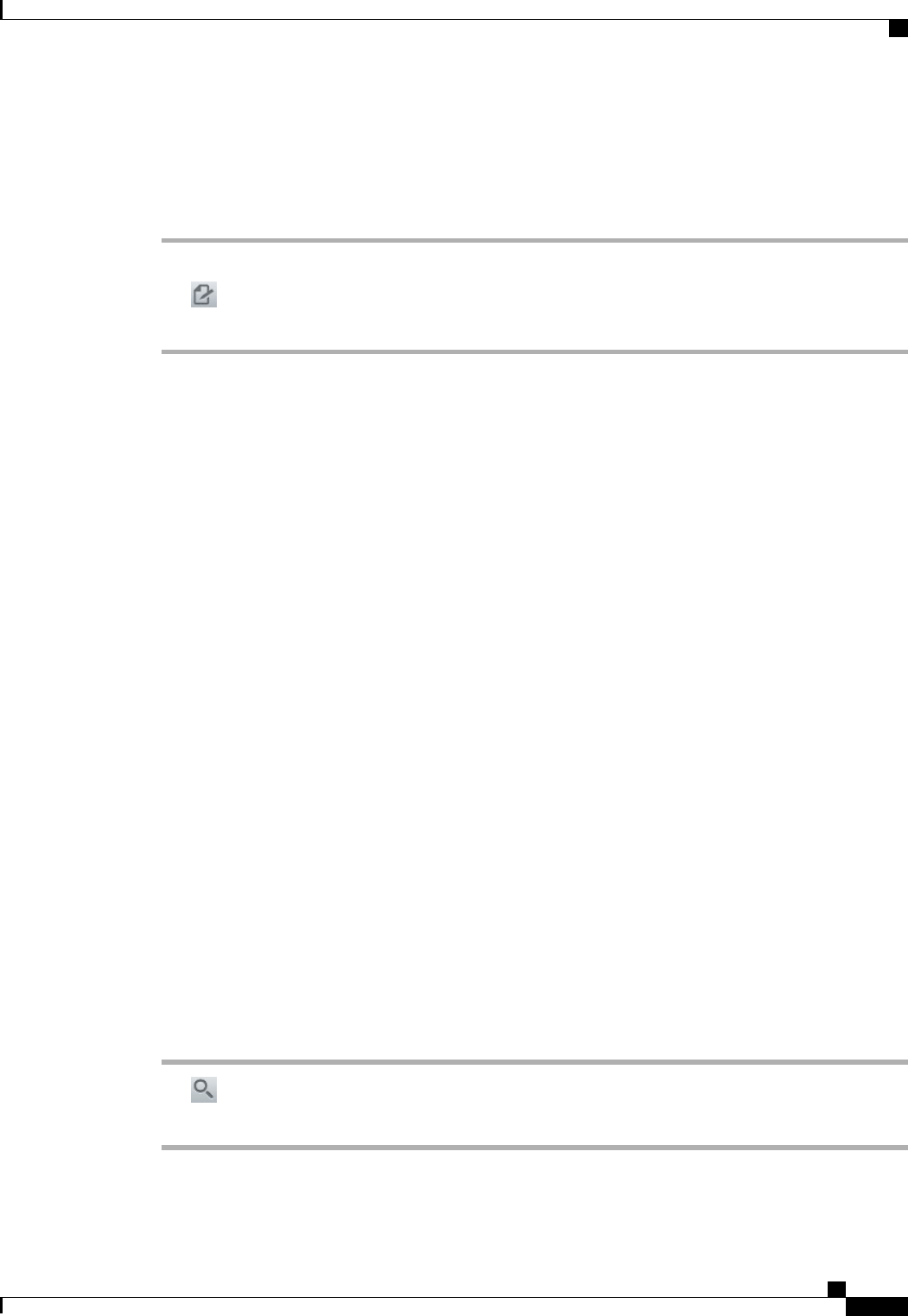
Edit group
Procedure
Step 1 Select a group.
Step 2 Tap .
Step 3 Make your changes and tap Done.
Search
While your Cisco DX650 is connected to a network, search for contacts in:
•Your local contacts
•Microsoft Exchange Global Address List (GAL)
•Cisco User Data Services (UDS)
•Jabber contacts
You can search by:
•First name
•Last name
•Phone number
•Username
The People application automatically merges search results that have similar data.
UDS search results that are not in your local contacts are displayed in their own block under the list of local
contacts.
The GAL is searched only if an ActiveSync account is set up and you enter at least three characters in the
search field.
Search your contacts
Procedure
Step 1 Tap .
Step 2 Enter your search criteria.
Cisco Desktop Collaboration Experience DX600 Series User Guide, Release 10.0(1)
OL-28931-01 91
Applications
Search

Import contacts
Procedure
Step 1 Tap .
Step 2 Tap Import/Export.
Step 3 Tap Import from SD card.
Export contacts
Procedure
Step 1 Tap .
Step 2 Tap Import/Export.
Step 3 Tap Export to SD card.
Set display options
Procedure
Step 1 Tap .
Step 2 Tap Settings.
Step 3 Tap Display Options.
Availability
Availability is displayed when you are signed in to the Jabber IM application. Availability shows the status
of local contacts.
Cisco Desktop Collaboration Experience DX600 Series User Guide, Release 10.0(1)
92 OL-28931-01
Applications
Import contacts

Email
The Email application allows you to manage multiple email accounts. Use the Email application to view
individual email account inboxes or a combined inbox. The Email application supports POP3, IMAP and
Exchange email accounts.
Use the Email application to add and manage multiple email accounts, including multiple Exchange accounts
on different servers.
Email accounts can use ActiveSync for the Calendar and Contacts applications.
Settings
The first time that you open the Email application, you are taken to the Settings page to configure the account
credentials (server and username, password, incoming server address, check box for Secure Connections and
Accept all SSL certificates), unless you already entered the credentials using the Setup Assistant or the Settings
application.
Add email account
Procedure
Step 1 Tap .
Step 2 Tap Settings.
Step 3 Tap Add Account.
Step 4 Enter the email account credentials.
The Email application shares account settings with the Calendar application; either application initiates the
account setup.
Inbox
Accounts are listed in the tab on the left side, followed by a summary of folders with new messages.
Folders are listed on the left side.
View email messages from an individual or a combined inbox. While an email message is open, the inbox is
displayed in the left tab.
Tap the Mailbox button at top left of the email message screen to return to the mailbox.
Cisco Desktop Collaboration Experience DX600 Series User Guide, Release 10.0(1)
OL-28931-01 93
Applications
Email
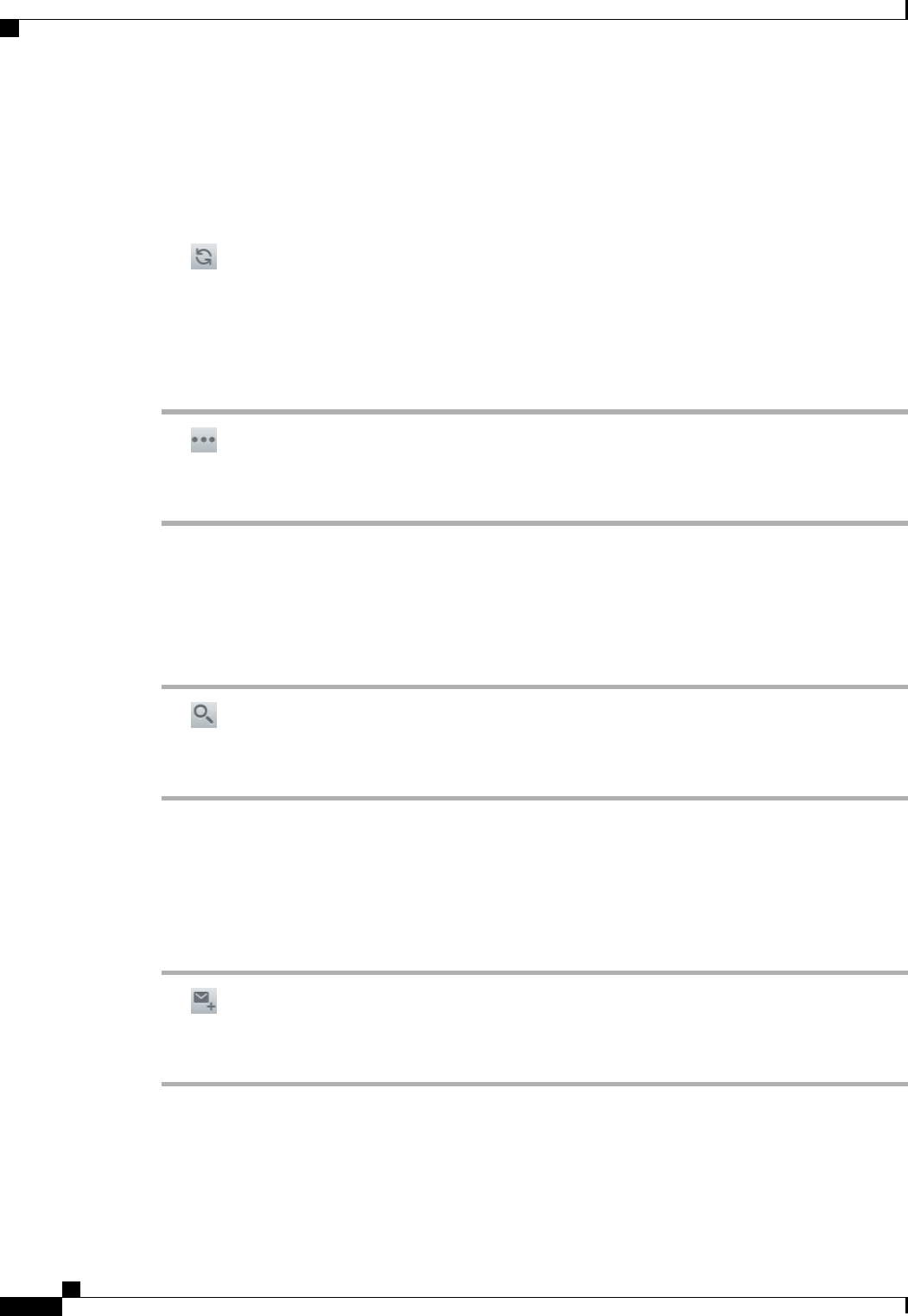
Refresh inbox
Procedure
Tap .
Sort mailbox
Procedure
Step 1 Tap .
Step 2 Tap Sorting Options.
Step 3 Select a sorting method.
Search email messages
Procedure
Step 1 Tap .
Step 2 Select the type of search.
Step 3 Enter your search query into the search bar.
Send email message
Procedure
Step 1 Tap .
Step 2 Enter the recipient email address, enter the subject, and compose the message.
Step 3 Tap Send.
Cisco Desktop Collaboration Experience DX600 Series User Guide, Release 10.0(1)
94 OL-28931-01
Applications
Send email message
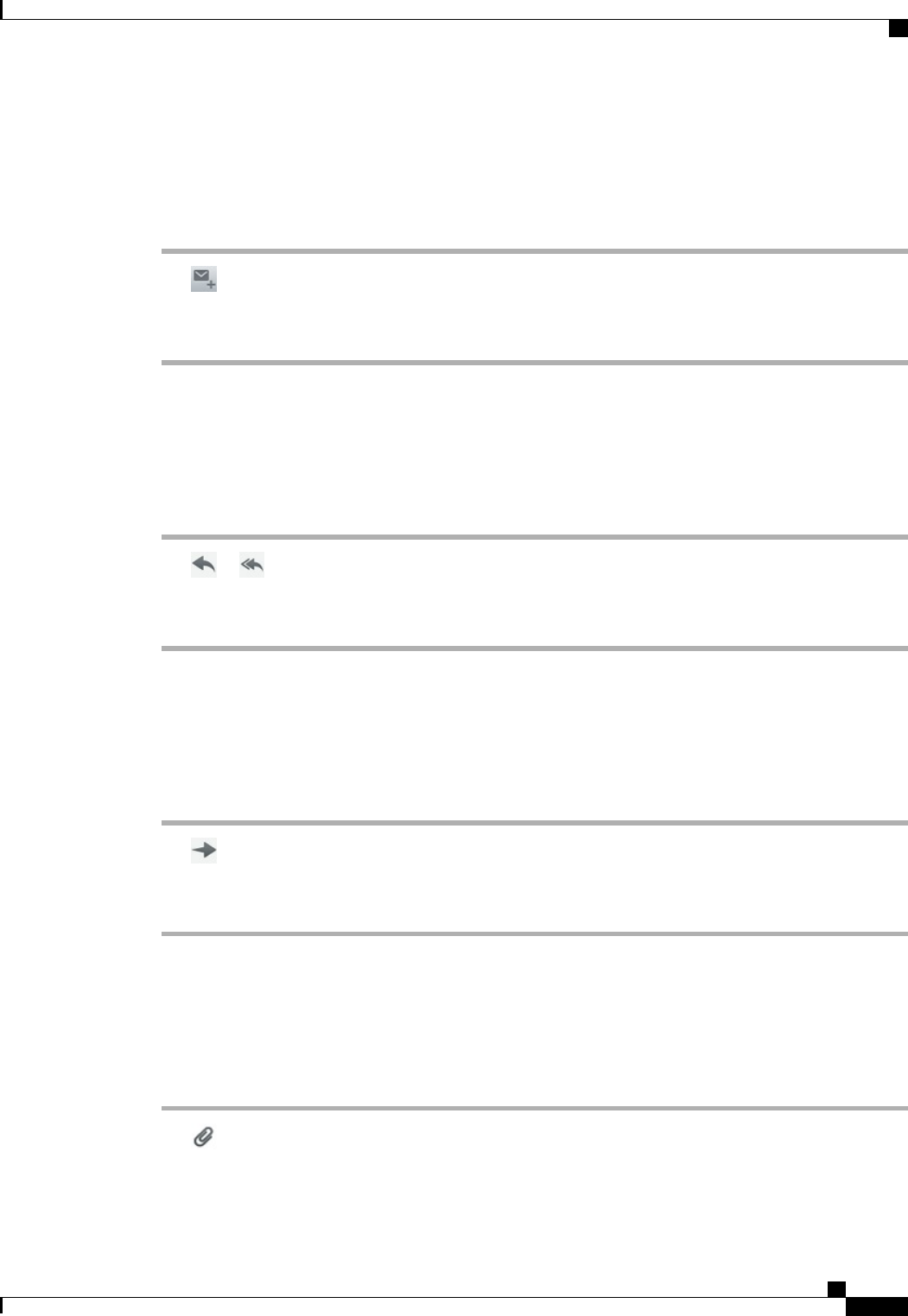
Save email message draft
Procedure
Step 1 Tap .
Step 2 Enter the email address, enter the subject, and compose the message.
Step 3 Tap Save as draft.
Reply to email message
Procedure
Step 1 Tap or .
Step 2 Compose the message.
Step 3 Tap Send.
Forward email message
Procedure
Step 1 Tap .
Step 2 Enter the email address.
Step 3 Tap Send.
Add attachment to email message
Procedure
Step 1 Tap .
Step 2 Select a file.
Cisco Desktop Collaboration Experience DX600 Series User Guide, Release 10.0(1)
OL-28931-01 95
Applications
Save email message draft
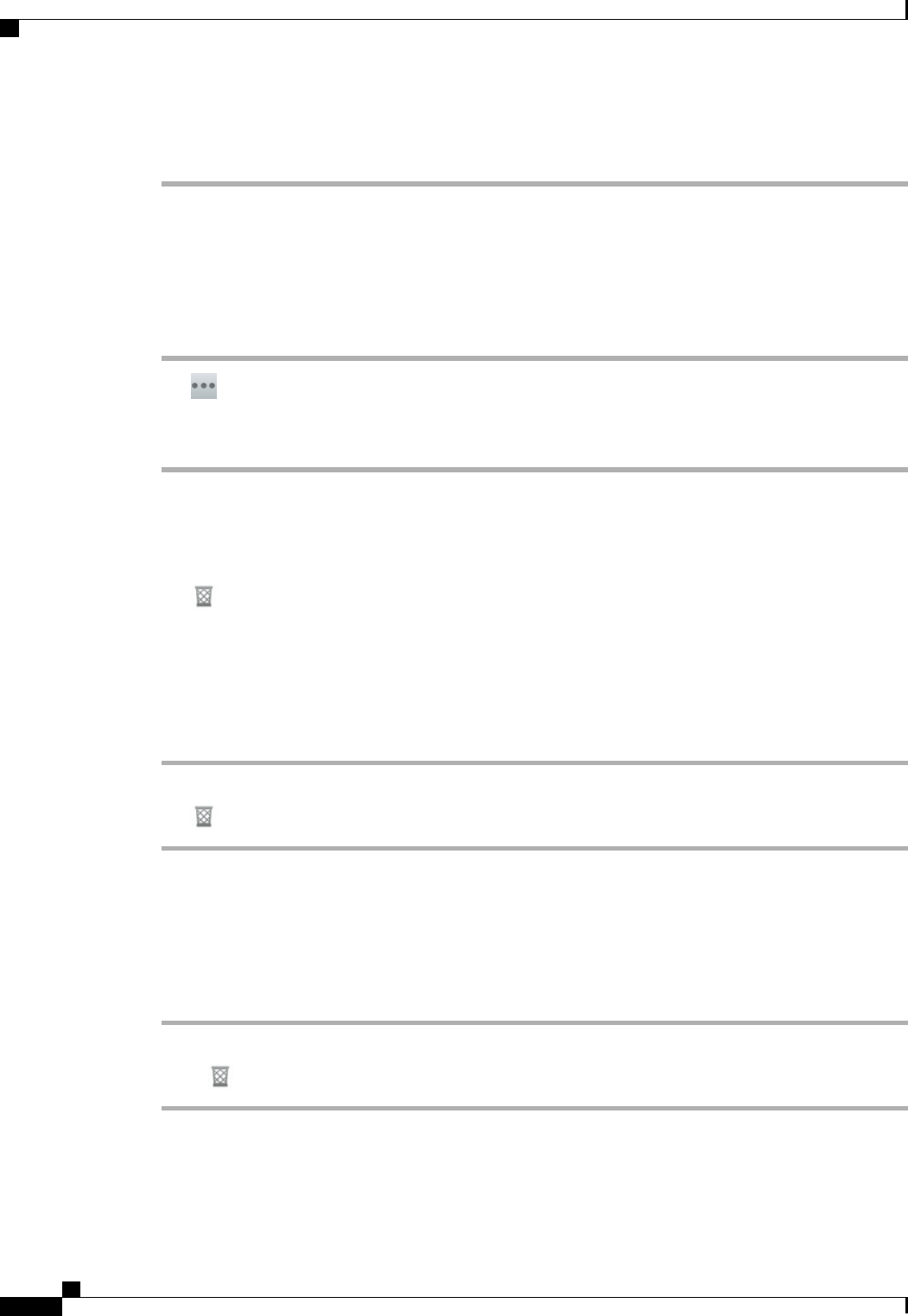
The total size of attachments cannot exceed 5 MB. A warning is displayed when the total size of
attachments reaches 3 MB.
Note
Add CC or BCC recipient
Procedure
Step 1 Tap .
Step 2 Tap Add Cc/Bcc.
Step 3 Enter the email address in the Cc or Bcc field.
Delete email message
Tap .
Delete multiple email messages
Procedure
Step 1 Check the email messages.
Step 2 Tap .
Delete folder
Procedure
Step 1 Long press a folder.
Step 2 Select .
Cisco Desktop Collaboration Experience DX600 Series User Guide, Release 10.0(1)
96 OL-28931-01
Applications
Add CC or BCC recipient

Move email message
Procedure
Step 1 Long press a message.
Step 2 Tap Move.
Step 3 Select a folder.
Mark email message as favorite
Tap .
Mark multiple email messages as favorites
Procedure
Step 1 Check the email messages.
Step 2 Tap .
Mark email message as new
Procedure
Step 1 Check the email message.
Step 2 Tap Mark Unread.
Cisco Desktop Collaboration Experience DX600 Series User Guide, Release 10.0(1)
OL-28931-01 97
Applications
Move email message
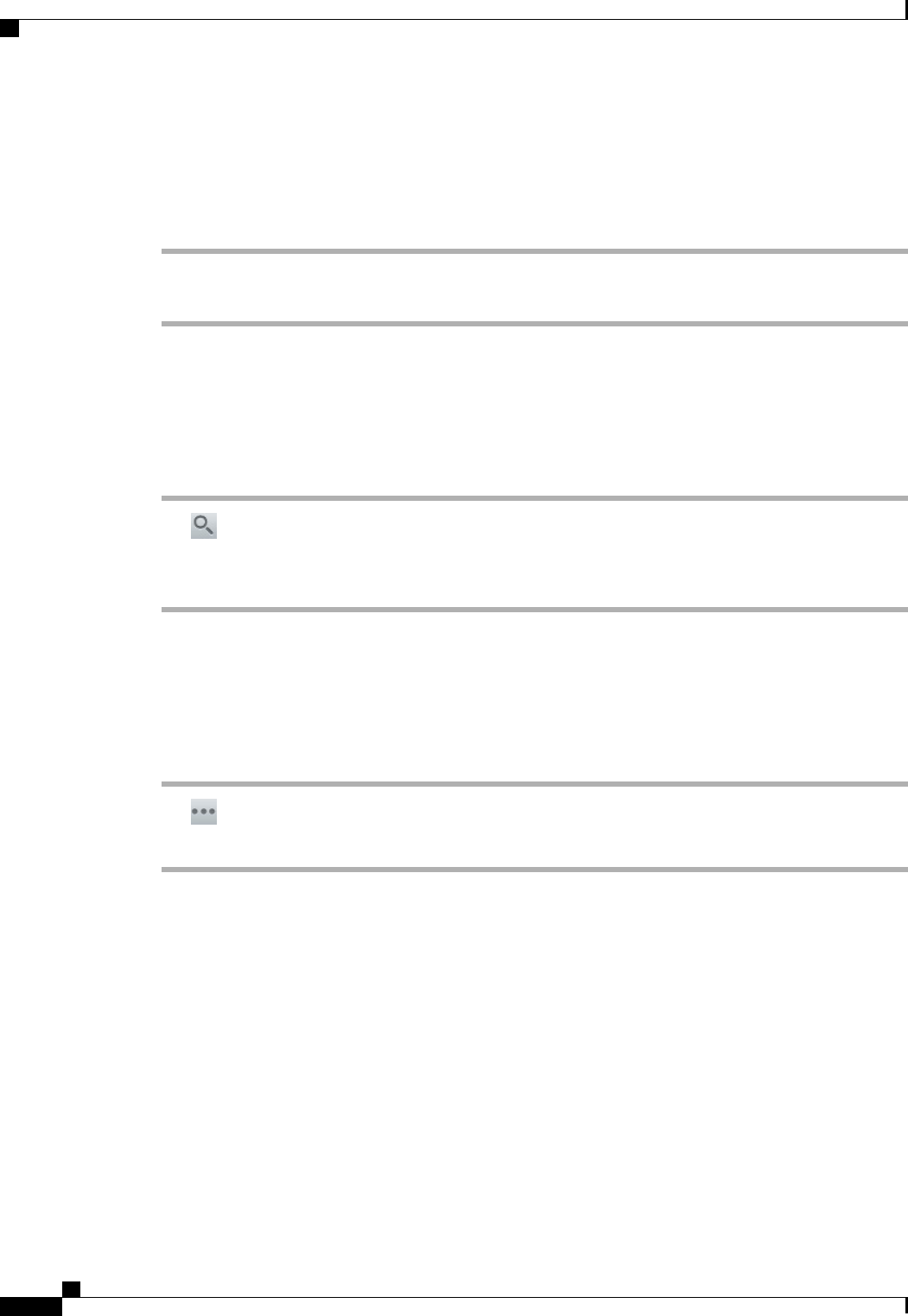
Mark multiple email messages as new
Procedure
Step 1 Check the email messages.
Step 2 Tap Mark Unread.
Search email messages
Procedure
Step 1 Tap .
Step 2 Select a search type.
Step 3 Enter your search query.
Set sorting options
Procedure
Step 1 Tap .
Step 2 Tap Sorting Options.
Cisco Desktop Collaboration Experience DX600 Series User Guide, Release 10.0(1)
98 OL-28931-01
Applications
Mark multiple email messages as new

Add signature to email messages
Procedure
Step 1 Tap .
Step 2 Tap Account Settings.
Step 3 Tap Signature.
Step 4 Enter your signature and tap OK. Your signature appears on any new email message that you compose. Your
signature does not appear when you reply to a message.
Digitally signed email messages
A digitally signed email message that is sent from an Exchange 2003 server appears as a downloadable
attachment of unknown size.
Set email check frequency
Procedure
Step 1 Tap .
Step 2 Tap Account Settings.
Step 3 Tap Email Check Frequency.
Step 4 Select a frequency.
Reset email account password
Procedure
Step 1 Tap .
Step 2 Tap Account Settings.
Step 3 Tap Incoming Settings.
Step 4 Enter your new password in the Password field.
Cisco Desktop Collaboration Experience DX600 Series User Guide, Release 10.0(1)
OL-28931-01 99
Applications
Add signature to email messages

Select ringtone
Procedure
Step 1 Tap .
Step 2 Tap Account Settings.
Step 3 Tap Select Ringtone.
Step 4 Select a ringtone and tap OK.
Edit vibrate settings
Procedure
Step 1 Tap .
Step 2 Tap Account Settings.
Step 3 Tap Vibrate.
Jabber IM
Use the Jabber IM application to send and receive instant messages, to update your availability, and to add
and remove contacts. You receive chat messages and presence updates while the Jabber IM application is
minimized or out of focus. While you are not signed in to the Jabber IM application, presence updates in other
applications may be inaccurate.
Jabber IM account
If you choose not to set up the account credentials in the Setup Assistant, you will be prompted to do so when
you first launch the Jabber IM application.
Add Jabber IM account
Enter all credentials before you save account settings. The application tries to authenticate credentials before
saving and prompts you to try again when you enter incorrect information.
Cisco Desktop Collaboration Experience DX600 Series User Guide, Release 10.0(1)
100 OL-28931-01
Applications
Select ringtone

Procedure
Step 1 Enter your Jabber IM account credentials.
Step 2 Tap Sign In.
Signing in
An automatic sign-in option for the Jabber IM application is enabled by default.
If you are not signed in to the Jabber IM application, the application will try to sign you in automatically when
the application is launched. If the sign-in succeeds, the Contacts screen is displayed. If the sign-in does not
succeed, you will be prompted to reenter your account credentials.
Availability
Tap the top left of the screen to set your status to one of the following:
•Available
•Away
•Do Not Disturb
•Custom
Add custom status
Procedure
Step 1 Tap your status at the top left of the screen.
Step 2 Tap Enter your custom status.
Step 3 Enter the text for your status.
Step 4 Select an availability status.
Step 5 Tap OK.
Cisco Desktop Collaboration Experience DX600 Series User Guide, Release 10.0(1)
OL-28931-01 101
Applications
Availability

Delete custom status
Procedure
Step 1 Tap your status at the top left of the screen.
Step 2 Long press a custom status.
Step 3 Tap Delete.
Contacts
Manage your contacts on the Contacts tab.
Add Chat contact
Procedure
Step 1 Tap Contacts.
Step 2 Tap .
Step 3 Tap Add Contact.
Step 4 Enter a name in the Name field. This will search your corporate directory.
Step 5 Tap Add to group and select a group.
Step 6 Tap Done.
Contact requests
While you are signed in to the Jabber IM application, you will receive a notification in the notification bar if
you receive a new contact request.
Cisco Desktop Collaboration Experience DX600 Series User Guide, Release 10.0(1)
102 OL-28931-01
Applications
Contacts
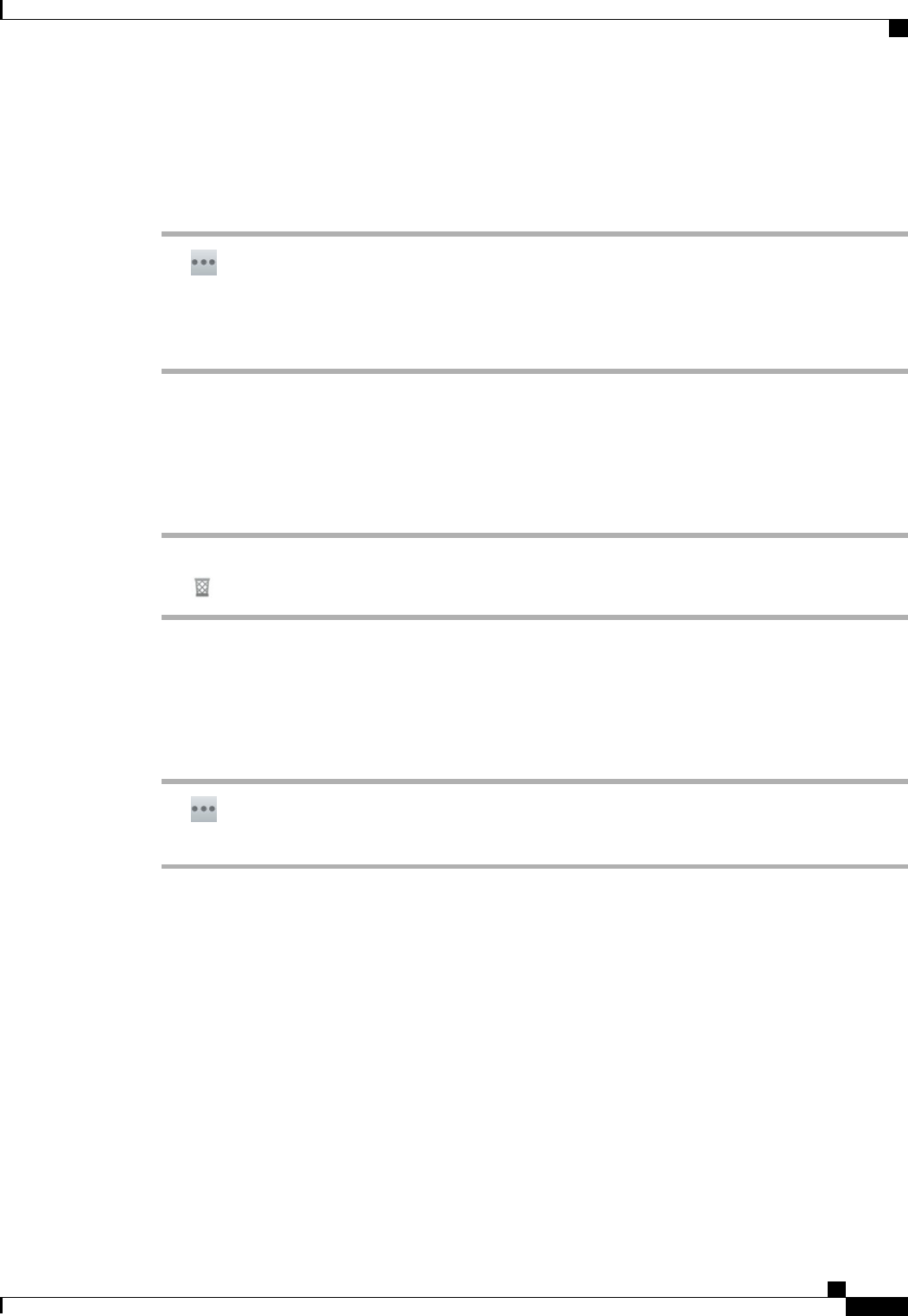
View contact requests
Procedure
Step 1 Tap .
Step 2 Tap Contact Requests.
Step 3 Tap Allow or Deny.
Step 4 Tap Confirm.
Remove chat contact
Procedure
Step 1 Tap and hold a contact on the Contacts tab or in an active conversation.
Step 2 Tap .
Show offline contacts
Procedure
Step 1 Tap .
Step 2 Tap Show Offline Contacts.
Unsynced contacts
You can use the Chat application to communicate with unsynced contacts. Unsynced contacts are contacts
that you have not added to your chat contacts.
Cisco Desktop Collaboration Experience DX600 Series User Guide, Release 10.0(1)
OL-28931-01 103
Applications
Contacts

Add unsynced contact to chat contacts
Procedure
Step 1 Long press the contact icon.
Step 2 Tap Add in the Contact Details dialog box.
Conversations
Chats open in the Active Conversations tab on the right side of the screen.
While you are viewing an active conversation, a scrollable list of your active conversations displays on the
left side of the screen. Select a conversation to view it.
Start conversation
Tap a contact from your contact list.
Emoticons
The Jabber IM application includes emoticons that you can use in conversation.
Insert emoticon into conversation
Procedure
Step 1 Tap Emoticons.
Step 2 Tap an emoticon to insert it into the conversation.
End conversation
Procedure
PurposeCommand or Action
Tap .
Step 1
Tap End chat.
Step 2
Cisco Desktop Collaboration Experience DX600 Series User Guide, Release 10.0(1)
104 OL-28931-01
Applications
Conversations

Search
Use the search function to search your chat contacts and your corporate directory.
Start conversation with search result
Tap on a search result to start a conversation with that contact.
Settings
The Jabber IM application settings allow you to set up your auto-sign-in option and to edit your chat account
information.
Enable audio and vibration notifications
Procedure
Step 1 Tap .
Step 2 Tap Settings.
Step 3 Tap Sounds and vibrate.
Step 4 Check the sound and vibrate options that you want.
Enable status bar notifications
Procedure
Step 1 Tap .
Step 2 Tap Settings.
Step 3 Check Message notifications.
Cisco Desktop Collaboration Experience DX600 Series User Guide, Release 10.0(1)
OL-28931-01 105
Applications
Search

Set profile photo
Procedure
Step 1 Tap .
Step 2 Tap Settings.
Step 3 Tap Profile photo.
Step 4 Tap Take new photo to launch the Camera application and take a picture. Or, tap Select from Gallery to
launch the Gallery application and select a picture.
Set your ringtone
Procedure
Step 1 Tap .
Step 2 Tap Settings.
Step 3 Tap Choose ringtone.
Step 4 Select a ringtone.
Step 5 Tap OK.
Sign out of Jabber IM
Procedure
Step 1 Tap .
Step 2 Tap Sign Out.
Unified Inbox
The Unified Inbox application lets you manage all communications at a glance.
The Unified Inbox application has two display modes:
•Contacts View
Cisco Desktop Collaboration Experience DX600 Series User Guide, Release 10.0(1)
106 OL-28931-01
Applications
Sign out of Jabber IM
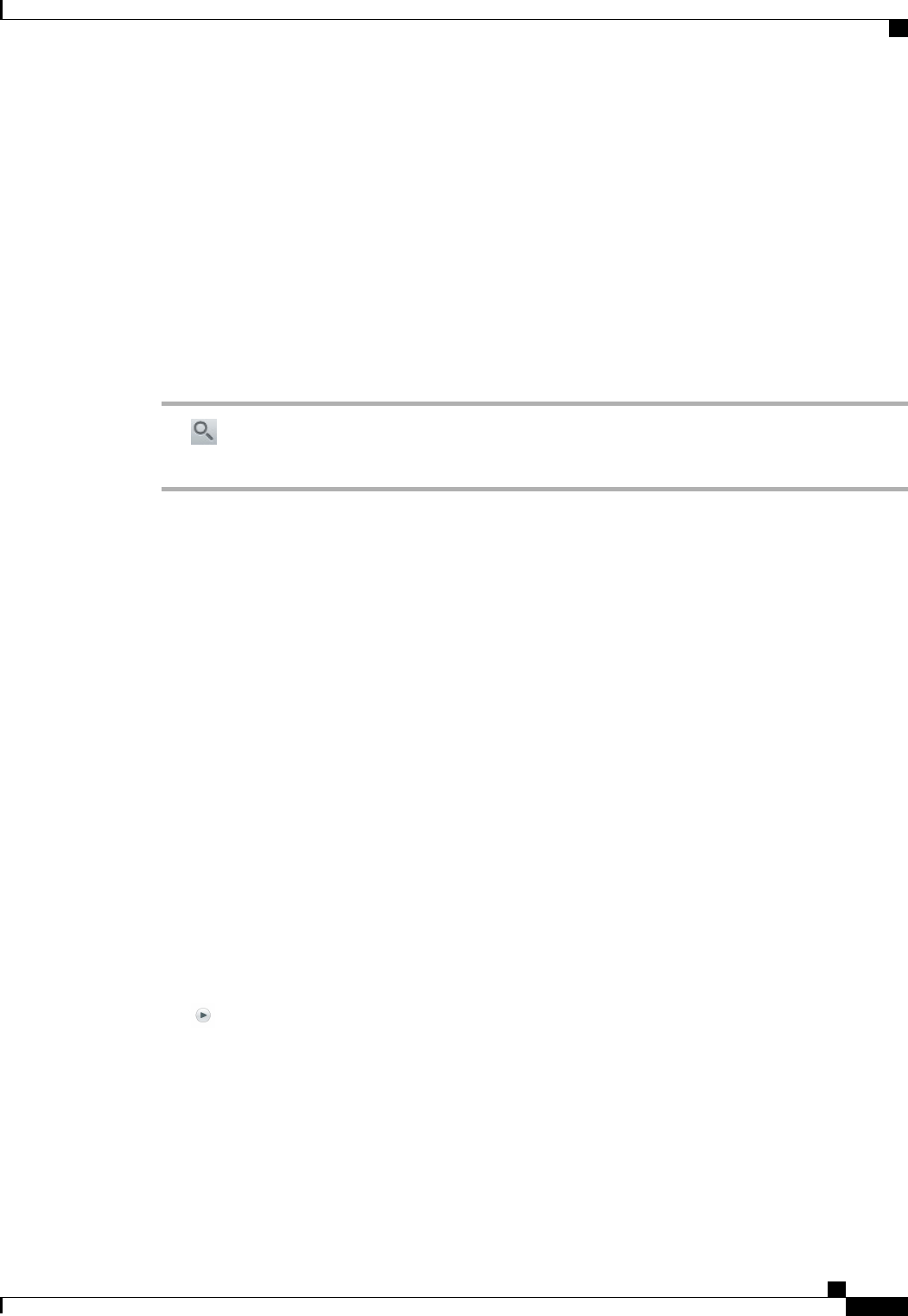
•Events View
View communications with contact
Tap a contact photo to view communications with that contact.
Search contact list
Procedure
Step 1 Tap .
Step 2 Enter your search criteria.
View email message
Tap an email message to view it.
If the message is part of a thread, the other messages appear in the tab on the left. You can select a message
from that tab to display its contents. You can also swipe an email message to the left or right to navigate to
the next (left) or the previous (right) email message.
View visual voice message
Procedure
Tap a voice message to view it.
Play visual voice message
Procedure
Tap .
Cisco Desktop Collaboration Experience DX600 Series User Guide, Release 10.0(1)
OL-28931-01 107
Applications
View communications with contact

Reply to visual voice message
Procedure
Step 1 Tap a voice message to view it.
Step 2 Tap Reply or Reply All button.
View event details
Tap an event to view the event details. The event information is displayed on the left, and the participants are
displayed on the right.
Join WebEx meeting
Tap Join or Start if you are viewing an event that is a Cisco WebEx meeting that is about to start.
Reorder panels
Procedure
Step 1 Tap .
Step 2 Tap Reorder Panels.
Step 3 Drag a panel to change its position.
Step 4 Tap Close.
Refresh application data
Procedure
Tap .
Cisco Desktop Collaboration Experience DX600 Series User Guide, Release 10.0(1)
108 OL-28931-01
Applications
View event details

Unified Inbox widget
The Unified Inbox widget shows the number of new voice messages, missed calls, and upcoming events, and
shows pictures of your newest contacts. The bigger the picture, the more recent the contact. The type of
communication is not shown with the contact picture.
WebEx
Cisco WebEx is a standalone application, but it is also integrated into the Calendar, Phone, Chat, and Contacts
applications.
During a Cisco WebEx meeting, participants can join the audio conference, see who is in the meeting, view
shared presentations, and chat with everyone or privately. A popup at the bottom of the screen identifies the
current speaker.
Note that you cannot share your desktop or a presentation in a Cisco WebEx meeting from the Cisco DX650.
The meeting host can drag the WebEx ball during a meeting to change presenters and mute or unmute
participants. The host has full control of the meeting.
Sign in to WebEx
Procedure
Step 1 Tap Sign in.
Step 2 Enter your email address.
Step 3 Tap Next.
Step 4 Enter your password.
Step 5 Tap Sign In.
Sign in to WebEx with single sign-on
Procedure
Step 1 Tap Sign in.
Step 2 Tap Sign in through your corporate website.
Step 3 Enter your WebEx site URL.
Step 4 Tap Next.
Step 5 Enter your credentials.
Cisco Desktop Collaboration Experience DX600 Series User Guide, Release 10.0(1)
OL-28931-01 109
Applications
Unified Inbox widget

Start instant WebEx meeting
Procedure
Step 1 Tap .
Step 2 The Instant Meeting dialog box appears. You can optionally set the meeting topic and the meeting password
and invite participants, or you can accept the default values. Note that some meeting sites require you to set
a meeting password.
Step 3 Tap Start Meeting.
Step 4 When prompted to call in, select Connect using the internet.
Schedule new WebEx meeting
Use the Calendar application to schedule a Cisco WebEx meeting.
Start scheduled WebEx meeting
Procedure
Step 1 Tap Start.
Step 2 When prompted to call in, select Connect using the internet.
Join scheduled WebEx meeting
Procedure
Step 1 Tap Join.
Step 2 When prompted to call in, select Connect using the internet.
Cisco Desktop Collaboration Experience DX600 Series User Guide, Release 10.0(1)
110 OL-28931-01
Applications
Start instant WebEx meeting

Join WebEx meeting by meeting number
Procedure
Step 1 Tap Join by Meeting Number.
Step 2 Enter the meeting number and your name. Enter the meeting password if it is required.
Step 3 Tap Join Meeting.
Step 4 When prompted to call in, select Connect using the internet.
View participant list
Procedure
Step 1 Tap Participants.
Step 2 Tap Participants again to hide the participant list.
Chat with participant
Procedure
Step 1 View the participant list.
Step 2 Select a participant.
Step 3 Enter your message and tap Send.
Chat with everyone
Procedure
Step 1 View the participant list.
Step 2 Tap Chat with everyone.
Step 3 Enter your message and tap Send.
Cisco Desktop Collaboration Experience DX600 Series User Guide, Release 10.0(1)
OL-28931-01 111
Applications
Join WebEx meeting by meeting number
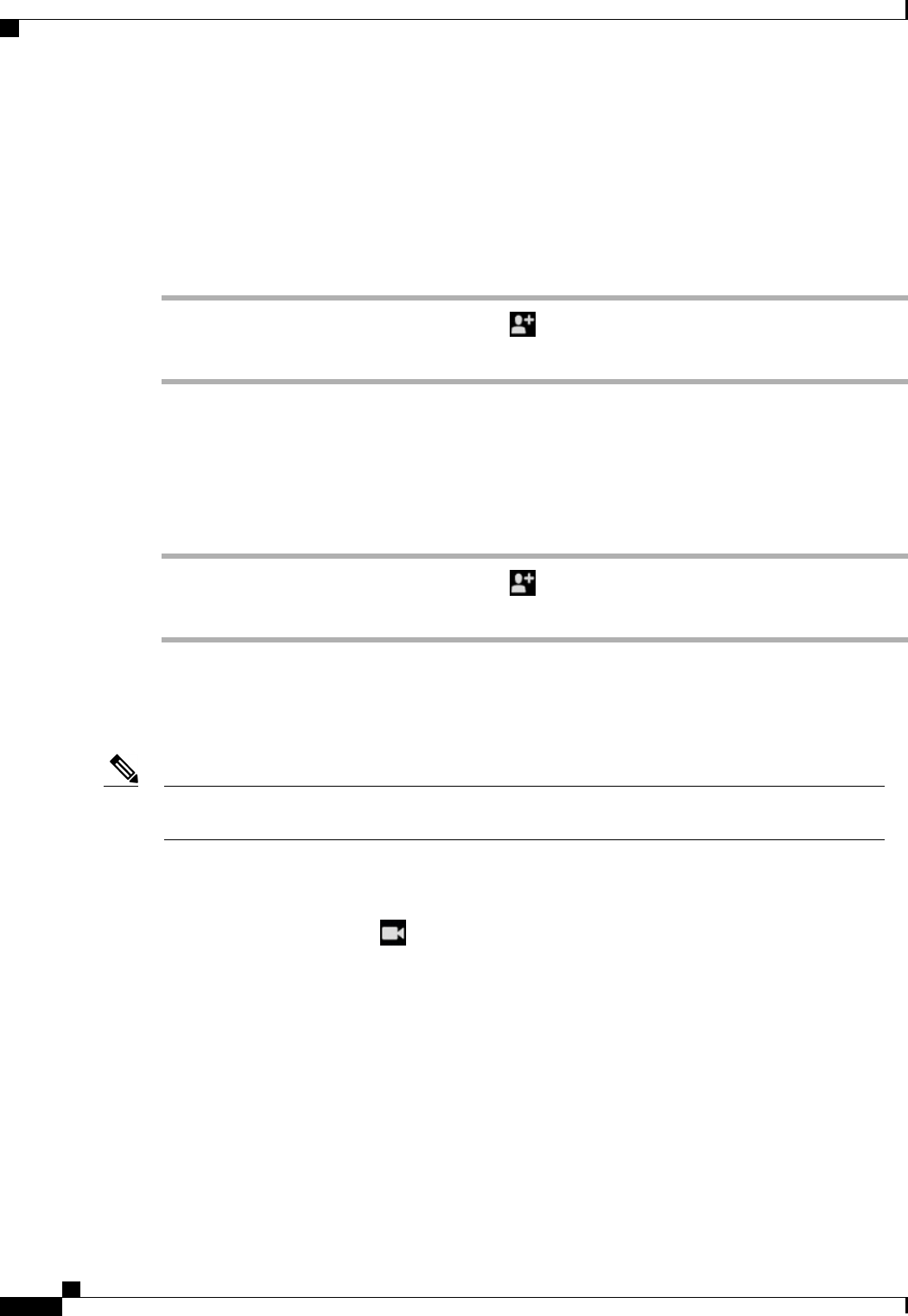
Invite more participants to WebEx meeting
Procedure
Step 1 If you are the host of a Cisco WebEx meeting, tap on the meeting detail view.
Step 2 Select contacts to invite to the meeting.
Invite more participants during WebEx meeting
Procedure
Step 1 If you are the host of a Cisco WebEx meeting, tap .
Step 2 Select contacts to invite to the meeting.
Show video during WebEx meeting
The WebEx application always uses the internal camera for video, even if you have an external camera
attached.
Note
Procedure
In a Cisco WebEx meeting, tap .
WebEx widget
Use the WebEx widget to display, schedule, and start Cisco WebEx meetings on your home screen.
More applications
Use the Google Play™Store to find and add applications to your phone. Depending on your security settings,
the Google Play Store may not be available.
Cisco Desktop Collaboration Experience DX600 Series User Guide, Release 10.0(1)
112 OL-28931-01
Applications
Invite more participants to WebEx meeting
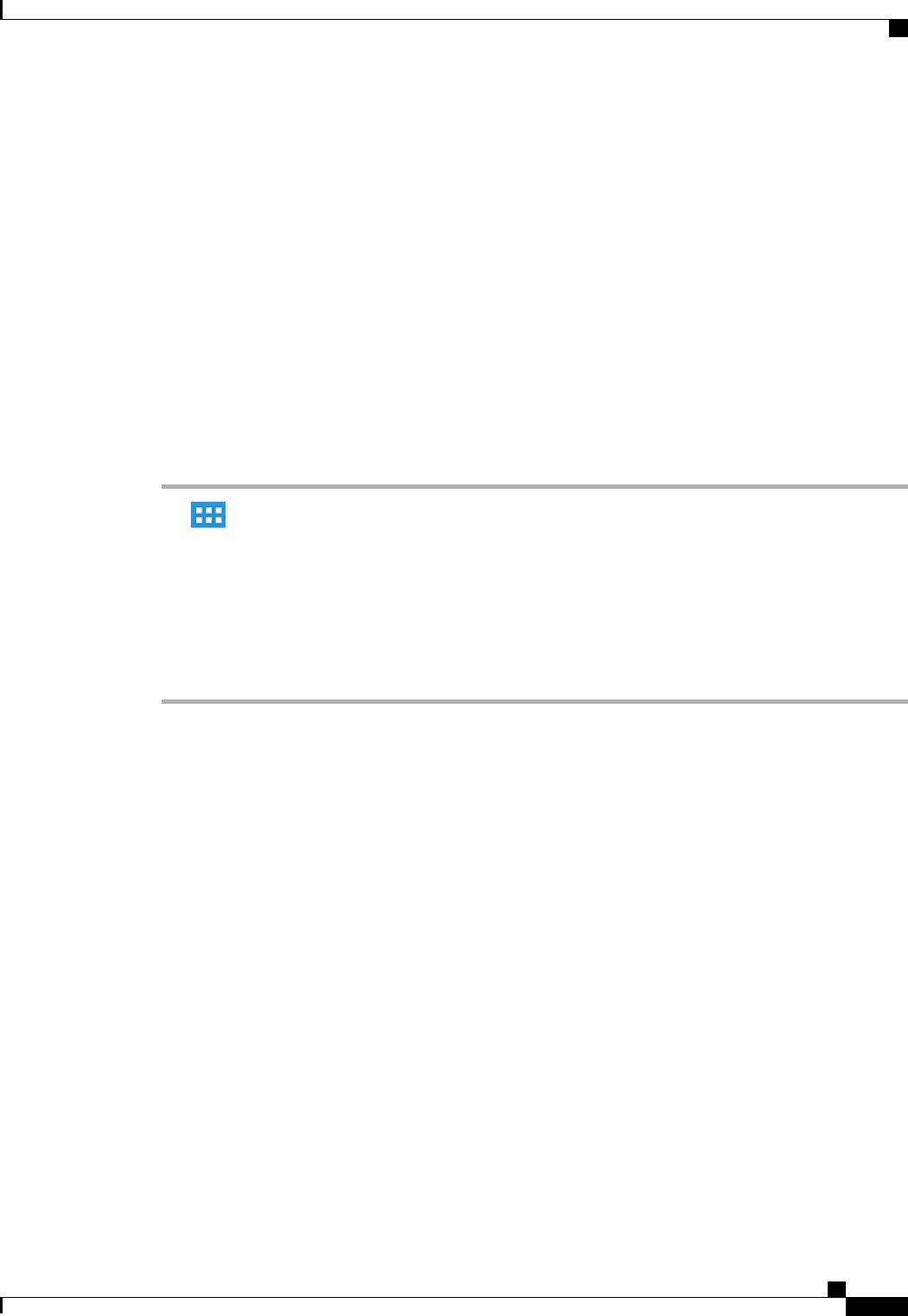
Some applications found in the Google Play Store may have hardware requirements that are not available on
your phone, such as GPS or a rear-facing camera.
Cisco cannot guarantee that an application that is downloaded from a third-party site will work.
UCM App
Use the UCM app to install or remove applications that are provisioned for your phone by your system
administrator. Depending on your system settings, you may not be able to remove applications that are
provisioned by your system administrator. Contact your system administrator for more information.
Remove application
Procedure
Step 1 Tap .
Step 2 Tap Settings.
Step 3 Tap Applications.
Step 4 Tap Manage Applications.
Step 5 Tap an application in one of the application lists.
Step 6 Tap Uninstall.
Step 7 Tap OK.
Cisco Desktop Collaboration Experience DX600 Series User Guide, Release 10.0(1)
OL-28931-01 113
Applications
UCM App

Cisco Desktop Collaboration Experience DX600 Series User Guide, Release 10.0(1)
114 OL-28931-01
Applications
Remove application

CHAPTER 7
Accessories
•Bluetooth, page 115
•External camera, page 117
•External monitor, page 118
•USB accessories, page 121
Bluetooth
Cisco DX650 supports Bluetooth 2.1+EDR, with headsets that support Hands-Free Profile (HFP) for voice
communications and Advanced Audio Distribution Profile (A2DP) for streaming audio. Cisco DX650 also
supports Object Push Profile (OPP) for generic file exchange over Bluetooth, and Human Interface Device
(HID) protocol for connecting a keyboard or mouse.
Bluetooth HFP support offers the following features:
•Ring
•Answer a Call
•End a Call
•Volume Control
•Last Number Redial
•Call Waiting
•Divert/Reject
•Three-Way Calling
◦Hold and Accept
◦Release and Accept
•Speed Dial
Bluetooth A2DP support allows for the unidirectional transfer of an audio stream to other Bluetooth-enabled
devices, such as a stereo headset.
Cisco Desktop Collaboration Experience DX600 Series User Guide, Release 10.0(1)
OL-28931-01 115
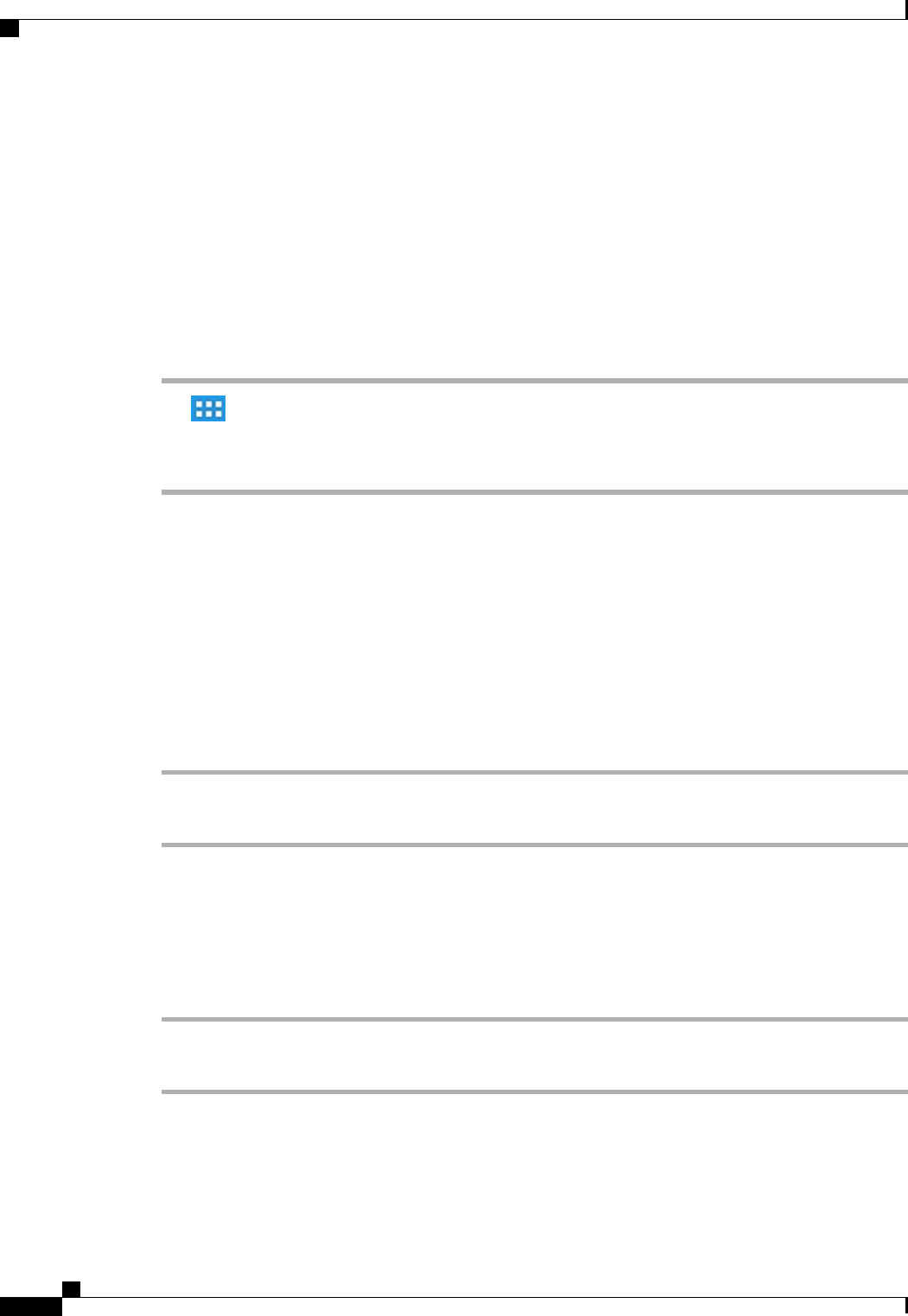
You can use a Bluetooth device up to 30 feet (10 meters) away from your Cisco DX650. However, for best
performance, it is recommended that you use Bluetooth devices within 10 feet (3 meters) of the Cisco DX650.
Enabling Bluetooth may degrade your wireless network connection. For improved wireless network
performance, disable Bluetooth when it is not in use, or use the 5 GHz band for your wireless network
connection.
Enable Bluetooth
Procedure
Step 1 Tap .
Step 2 Tap Settings.
Step 3 Toggle Bluetooth on.
Scan for Bluetooth device
Tap Search for Devices if devices do not appear in the Bluetooth devices submenu.
Pair Bluetooth device
Procedure
Step 1 Tap a device to pair from the available devices list.
Step 2 Verify the passkey and tap Pair.
Unpair Bluetooth device
Procedure
Step 1 Tap Settings next to the device.
Step 2 Tap Unpair.
Cisco Desktop Collaboration Experience DX600 Series User Guide, Release 10.0(1)
116 OL-28931-01
Accessories
Enable Bluetooth

Sharing files
Procedure
Step 1 Pair your Cisco DX650 with another Bluetooth enabled device.
Step 2 Select a file to share. For example, you can share a photo from the Gallery application or a contact from the
Contact application.
Step 3 Select Bluetooth from the Share menu.
View received files
Procedure
Step 1 Tap More.
Step 2 Tap Show received files.
Make phone discoverable
Tap the name of your phone to make it discoverable. Your Cisco DX650 will be discoverable for 120 seconds.
Set Bluetooth device name
Procedure
Step 1 Tap More.
Step 2 Tap Rename Device.
Step 3 Enter a device name and tap Rename.
External camera
Cisco DX650 supports the Logitech C920-C Webcam. While an external camera is connected, it becomes the
default camera for the phone application. Other applications will continue to use the internal camera.
Tap Swap to swap between the external and internal cameras.
Cisco Desktop Collaboration Experience DX600 Series User Guide, Release 10.0(1)
OL-28931-01 117
Accessories
Sharing files

While you are using both an external camera and an external monitor, video from video calls will appear on
the external monitor, and the call will display on the internal screen as if it is an audio call. When you open
another application on the external monitor during a video call, the video call is overlaid on the application
being viewed.
External monitor
Connect your phone to a monitor by inserting one end of an HDMI cable into the micro-HDMI port and the
other end into a monitor HDMI port.
Your phone screen is displayed on an external monitor in mirror mode, or the external monitor acts as a dual
independent display. In mirror mode, the content that is displayed on the phone screen is also shown on the
external monitor. In dual independent display mode, the external monitor functions as a second, independent
screen.
Cisco DX650 supports the following external monitor resolutions:
•1920 x 1200 (WUXGA)
•1920 x 1080 (1080p)
•1680 x 1050
•1280 x 720 (720p)
If Cisco DX650 enters sleep mode, the external monitor enters sleep mode too. When the phone is locked,
the external monitor is also locked and cannot be used until the phone is unlocked.
You can move applications to or from the external monitor. Moving the Browser application will cause the
application to restart. You cannot have more than one instance of an application running at the same time.
A mouse and a keyboard can be used on both the internal screen and an external monitor. Mouse panning is
supported. The keyboard follows the focus of the mouse.
Connect external monitor
Procedure
Insert one end of an HDMI cable into the HDMI port and the other end into a monitor HDMI port.
Switch display mode
Procedure
Step 1 Tap Monitor on the status bar.
Step 2 Select Mirror to mirror the Cisco DX650 screen on the external monitor. Select External Display to use the
external monitor as an independent display.
Cisco Desktop Collaboration Experience DX600 Series User Guide, Release 10.0(1)
118 OL-28931-01
Accessories
External monitor
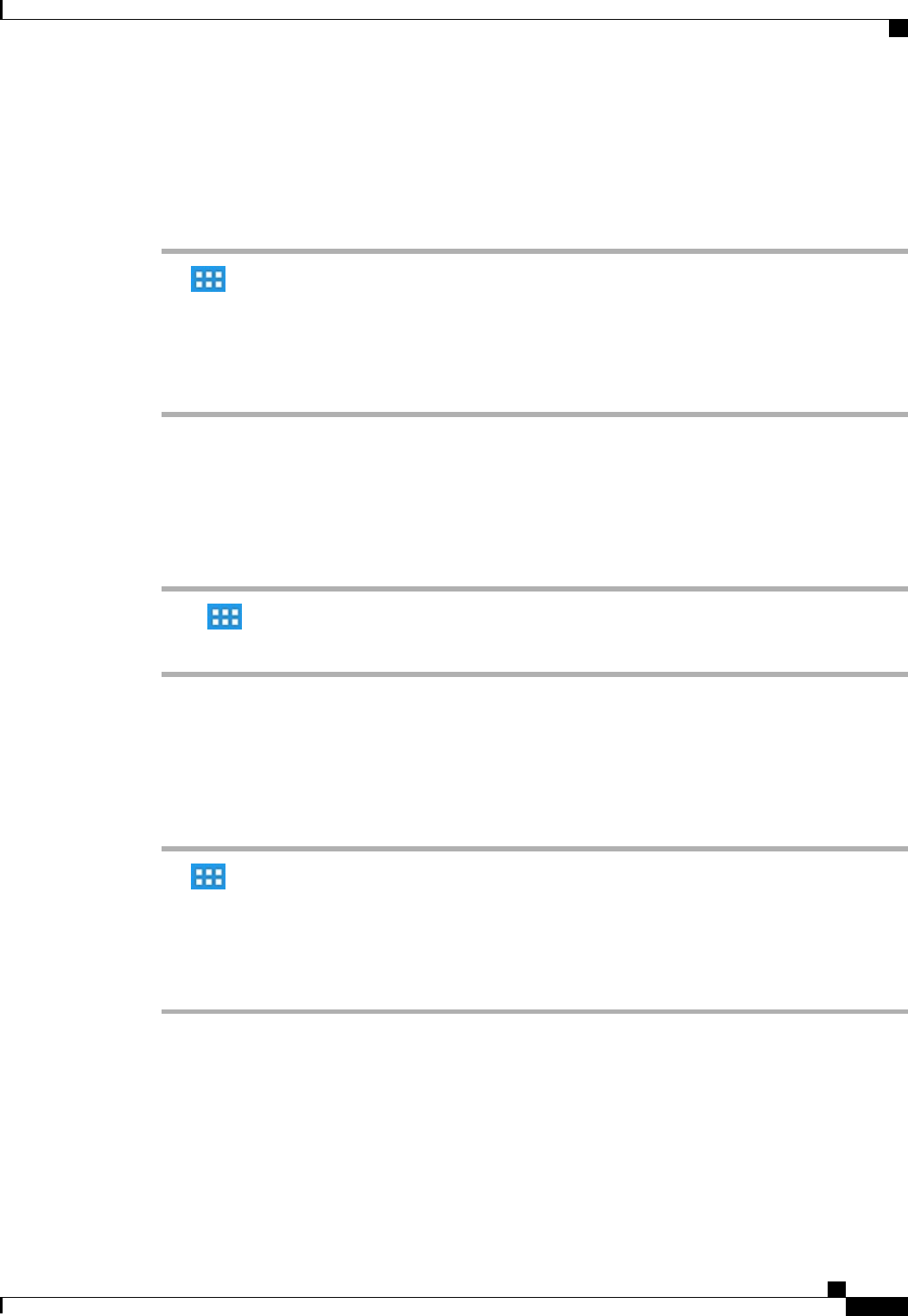
Set monitor orientation
Procedure
Step 1 Tap .
Step 2 Tap Settings.
Step 3 Tap External display.
Step 4 Tap Orientation.
Step 5 Select a monitor orientation.
Launch application on external monitor
Procedure
Step 1 Select on the external monitor display.
Step 2 Select an application.
Autolaunch application to external monitor
Procedure
Step 1 Tap on the internal display.
Step 2 Tap Settings.
Step 3 Select External Display.
Step 4 Select Auto Launch.
Step 5 Select up to three applications to automatically launch on the external monitor.
Cisco Desktop Collaboration Experience DX600 Series User Guide, Release 10.0(1)
OL-28931-01 119
Accessories
Set monitor orientation

Move application to external monitor
Procedure
Step 1 Tap Monitor on the status bar.
Step 2 Select Open in External Display.
Move application to phone screen
Procedure
Step 1 Tap Monitor on the external monitor status bar.
Step 2 Select Open in Phone Display.
HDCP support
Cisco DX600 Series phones support Digital Rights Management (DRM) protected content. For example, your
phone plays video that is purchased from the Google Play Store.
To prevent unauthorized copying of HD video using the HDMI port, it is required that an HDMI monitor (or
any HDMI sink device) that is connected to the phone must be HDCP compliant.
HDCP is used to encrypt the data between your phone and the HDMI monitor. If the HDMI monitor is not
HDCP compliant, your phone will not play protected content.
This table summarizes when DRM content can be played.
HDCP not supported monitorHDCP supported monitorDisplay mode
N/ADRM content can be playedNo external monitor
DRM content will not play.
The DRM content player will
prompt you that content cannot be
played. It does not matter if the
content player is started on the
internal display or on a Dual
independent display (DID)
monitor.
DRM content can be played
regardless of where the media is
being displayed.
Dual independent display
Cisco Desktop Collaboration Experience DX600 Series User Guide, Release 10.0(1)
120 OL-28931-01
Accessories
Move application to external monitor

DRM content will not play.
The DRM content player will
prompt you that content cannot be
played.
DRM content can be playedMirror mode
Virtual desktop infrastructure
For users who adopt Virtual Desktop Infrastructure (VDI), Cisco DX650 supports third-party virtual desktop
clients from leading third-party vendors:
•Citrix
•VMware
•Wyse
Desktop virtualization technologies may offer a degraded level of performance when remotely accessing
audio, video, and interactive multimedia resources. Unlike other desktop virtualization endpoints, your phone
features a local voice and video media plane, which enables your phone to connect to media traffic through
the device itself and outside of the remote desktop display protocol. For example, two Cisco DX600 Series
phone users in the same branch can call each other using Cisco Unified Personal Communicator running on
their remote virtual desktop and, while the control (signaling) plane resides in the data center, the audio and
video connection between the users never leaves the branch. The branch network applies packet prioritization
to the Real-time Transport Protocol (RTP) flow, and the two phones connect directly to each other without
the need for the voice to traverse the WAN twice to reach the data center. The local voice and video media
plane delivers the best quality experience for audio and video collaboration without inflating the bandwidth
consumption over the WAN.
Some applications on a remote desktop are designed for a larger screen size. To avoid cutting off part of an
application in a virtual desktop client, Cisco recommends that you set the remote desktop to a larger screen
size than 1024 x 600.
You musy run desktop virtualization clients on an external monitor in external mode, not in mirror mode.
The desktop virtualization experience on Cisco DX650 includes keyboard and mouse support. However, the
desktop virtualization clients retain the touch-mode behavior, and some keyboard and mouse actions may
differ from a typical Microsoft Windows experience. For a description of supported keyboard shortcuts and
mouse actions, refer to the USB keyboard and mouse section of this guide.
For additional information about Citrix Receiver, VMware View Client, and Wyse PocketCloud Pro, see the
product description for each application.
Related Topics
USB keyboard and mouse, on page 122
USB accessories
Each available Cisco DX650 features a USB port on the right side.
The USB port allows you to use any of the following accessories:
Cisco Desktop Collaboration Experience DX600 Series User Guide, Release 10.0(1)
OL-28931-01 121
Accessories
Virtual desktop infrastructure

•USB keyboard
•USB mouse
•USB memory stick
•USB-powered hub
•USB serial console cable
USB keyboard and mouse
Not every USB keyboard or mouse is guaranteed to work with Cisco DX650. However, most USB keyboards
that are human interface device (HID) compliant will work correctly. Because all USB hubs need to be
powered, keyboards that include one or more hubs are not allowed on the Cisco DX650, because they contain
a nonpowered hub.
VDI shortcuts
The keyboard shortcuts and mouse actions available in virtual desktop clients differ from those for other Cisco
DX650 applications.
VDI keyboard shortcuts
Control key meta-state (combination keys), Num Lock, and Caps Lock state are not currently supported by
many of the virtual desktop clients on Android. For information about supported shortcuts, see the product
description for each application.
VDI mouse actions
The Cisco DX600 platform maps the mouse events into touchscreen input and the VDI clients usually map
the touchscreen input to customary Android actions, resulting in the following behavior:
•Click: tap
•Click and drag: Scroll up and down, or left and right, on the remote desktop
•Click, hold, and drag: Move windows, scroll bar handles, and other objects on the remote desktop
Some applications on a remote desktop are designed for a larger screen size. To avoid cutting off part of an
application in a virtual desktop client, Cisco recommends that you set the remote desktop to a larger screen
size than the Cisco DX650 screen size.
USB memory stick
Insert a USB memory stick into the USB port to expand the available disk space of the Cisco DX650.
The USB memory stick is mounted at /sdcard/external/usb-sda1.
Cisco Desktop Collaboration Experience DX600 Series User Guide, Release 10.0(1)
122 OL-28931-01
Accessories
USB keyboard and mouse

USB-powered hub
Use a USB-powered hub to expand the number of available USB ports. USB-powered hubs allow you to
connect up to five USB accessories.
USB console cable
A USB console cable is typically used only for debugging by a system administrator.
For more information about how to use a USB console cable, contact your system administrator.
Cisco Desktop Collaboration Experience DX600 Series User Guide, Release 10.0(1)
OL-28931-01 123
Accessories
USB-powered hub

Cisco Desktop Collaboration Experience DX600 Series User Guide, Release 10.0(1)
124 OL-28931-01
Accessories
USB console cable

CHAPTER 8
Product safety, security, accessibility, and
related information
•Safety and performance information, page 125
•Emergency response notification, page 125
•FCC compliance statements, page 127
•CE marking, page 128
•Cryptographic information, page 128
•Data backup, page 128
•Problem Report Tool, page 129
•Accessibility features, page 129
Safety and performance information
Power outages and other devices can affect your Cisco DX650.
Power outage
Your access to emergency services through the phone application depends on the phone being connected to
a network. If there is an interruption in the power supply for your router, Service and Emergency Calling
Service dialing will not function until power is restored. In the case of a power failure or disruption, you may
need to reset or reconfigure equipment before using the Service or Emergency Calling Service dialing.
Emergency response notification
The text of the Emergency Response Notification displays the first time that you open the Phone application
and also when you select an existing VPN network or add a new VPN network.
Cisco Desktop Collaboration Experience DX600 Series User Guide, Release 10.0(1)
OL-28931-01 125
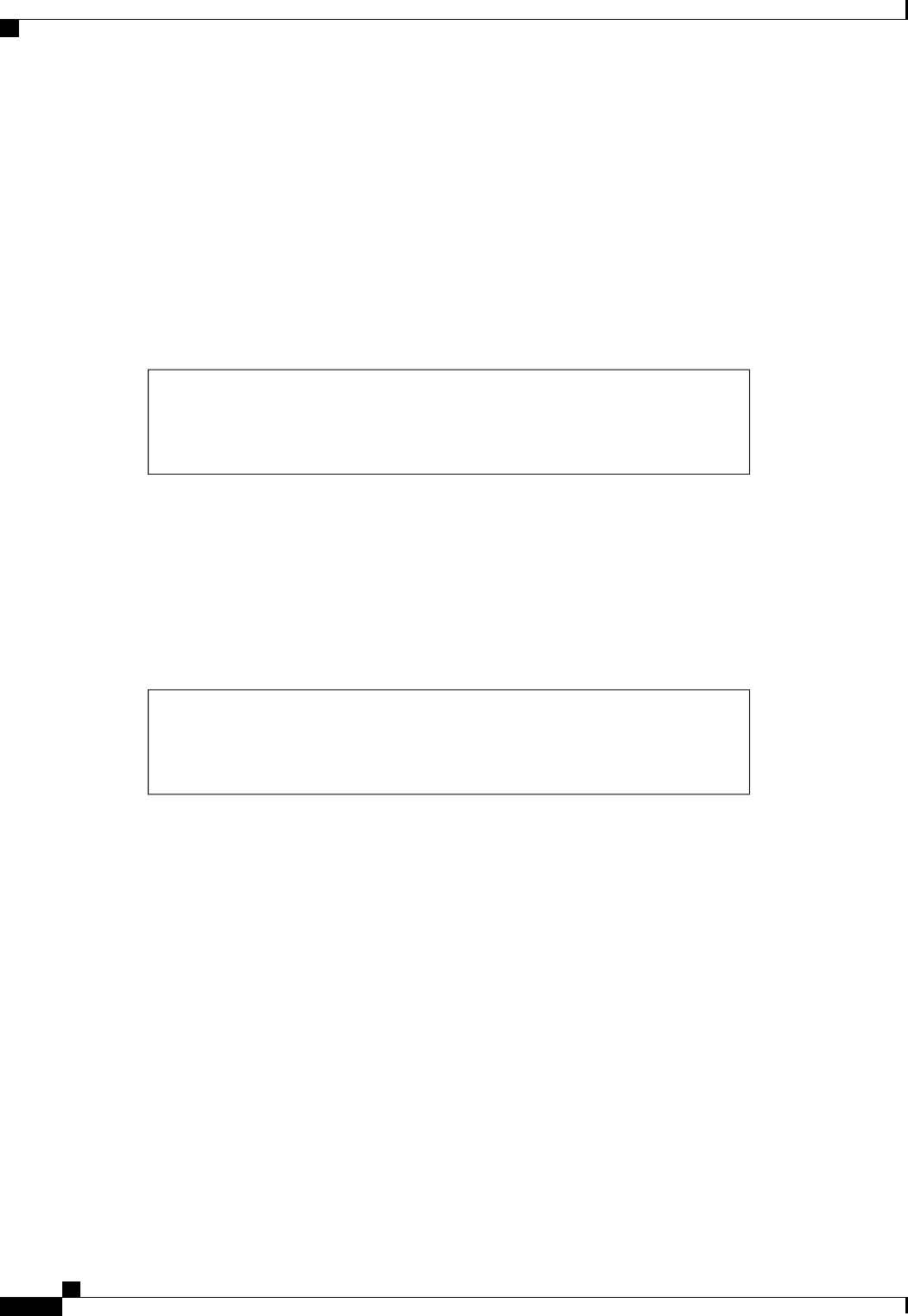
Emergency response notification for phone
When you open the Phone application on your Cisco DX650 for the first time, the Emergency Response
Notification dialog box alerts you that your ability to dial emergency numbers may be hindered because you
are using a VoIP network.
This dialog requires that you check the “I acknowledge this information”check box and tap OK in order to
dismiss the dialog. After the initial acceptance, the dialog will reappear only if you perform a factory reset of
your device or the system administrator performs a remote wipe of your device.
The text of the Emergency Response Notification dialog for the Phone application follows here:
Dialing emergency numbers (for example, 911 or 112) may not work on an
enterprise-class IP telephony network like that used for Cisco DX650. Correct location
information may not be passed on to emergency responders. Your network administrator
can advise you about the capabilities of your network, including the dialing sequence
that you will need to use when on or off the enterprise premises.
Emergency response notification for VPN
Whenever you choose to connect to an existing VPN network or choose the option to Add a New VPN
Connection, a dialog displays to warn about the potential disruption of emergency response numbers. You
can proceed to the VPN connection step by tapping OK. You can dismiss the dialog and cancel the connection
by tapping Back.
The text of the Emergency Response Notification dialog for VPN networks follows here:
CAUTION - Emergency response numbers (for example, 911 or 112) may not work
on software telephony clients. Your exact location and the appropriate emergency
response agency may not be easily identified. Some countries restrict use of VoIP
software via VPN over the Internet, including: UAE, Saudi Arabia, Pakistan, Lebanon,
Jordan, Egypt, Oman, Qatar, Yemen, Algeria, and Kuwait.
External devices
The following information applies when you use external devices with your phone:
Cisco recommends using good-quality external devices (such as headsets) that are shielded against unwanted
radio frequency (RF) and audio frequency (AF) signals.
Depending on the quality of these devices and their proximity to other devices such as mobile phones or
two-way radios, some audio noise may still occur. In these cases, Cisco recommends that you take one or
more of these actions:
•Move the external device away from the source of the RF or AF signals.
•Route the external device cables away from the source of the RF or AF signals.
•Use shielded cables for the external device, or use cables with a better shield and connector.
•Shorten the length of the external device cable.
•Apply ferrites or other such devices on the cables for the external device.
Cisco Desktop Collaboration Experience DX600 Series User Guide, Release 10.0(1)
126 OL-28931-01
Product safety, security, accessibility, and related information
Emergency response notification for phone

Cisco cannot guarantee the performance of the system because Cisco has no control over the quality of external
devices, cables, and connectors. The system will perform adequately when suitable devices are attached using
good-quality cables and connectors.
In European Union countries, use only external speakers, microphones, and headsets that are fully compliant
with the EMC Directive [89/336/EC].
Caution
Headset safety
When using a headset, set the volume to a safe level. Permanent hearing loss or damage may occur if headsets
are used at high volume.
Do not use a headset at high volume to block out other noise. Lower the volume if you cannot hear people
speaking near you.
If you experience ringing in your ears, muffled voices, or other signs of hearing loss or damage, stop using
your headset and have your hearing checked.
Avoid using a headset while operating a vehicle. Using a headset while operating a vehicle can be distracting
and dangerous, and is illegal in some areas. Likewise, avoid using a headset while performing any activity
that requires your undivided attention.
Bluetooth wireless headset performance
Cisco DX650 supports Bluetooth Class 2 technology when the headsets support Bluetooth. Bluetooth enables
low-bandwidth wireless connections within a range of 30 feet (10 meters). The best performance is in the 3-
to 6-foot (1- to 2-meter) range. You can connect up to five headsets, but only the last one connected is used
as the default.
Because there can be potential interference issues, it is recommended that you move 802.11b/g devices,
Bluetooth devices, microwave ovens, and large metal objects away from the wireless headset.
For a Bluetooth wireless headset to work, it does not need to be within direct line-of-sight of the phone. Some
barriers, such as walls or doors, and interference from other electronic devices can affect the Bluetooth
connection.
FCC compliance statements
The Federal Communications Commission requires compliance statements for the following:
•FCC Part 15.21
•FCC Receivers and Class B Digital
FCC part 15.21 statement
Changes or modifications not expressly approved by the party responsible for compliance could void the
user’s authority to operate the equipment.
Cisco Desktop Collaboration Experience DX600 Series User Guide, Release 10.0(1)
OL-28931-01 127
Product safety, security, accessibility, and related information
Headset safety

FCC receivers and class B digital statement
This product has been tested and complies with the specifications for a Class B digital device, pursuant to
Part 15 of the FCC Rules. These limits are designed to provide reasonable protection against harmful
interference in a residential installation. This equipment generates, uses, and can radiate radio frequency
energy and, if not installed and used according to the instructions, may cause harmful interference to radio
communications. However, there is no guarantee that interference will not occur in a particular installation.
If this equipment does cause harmful interference to radio or television reception, which is found by turning
the equipment off and on, the user is encouraged to try to correct the interference by one or more of the
following measures:
•Reorient or relocate the receiving antenna
•Increase the separation between the equipment or devices
•Connect the equipment to an outlet other than the receiver’s
•Consult a dealer or an experienced radio/TV technician for assistance
CE marking
For Cisco DX650, the CE mark and class-2 identifier are affixed to the equipment and packaging.
Cryptographic information
NOTICE
This product contains cryptographic features and is subject to United States and local country laws governing
import, export, transfer, and use. Delivery of Cisco cryptographic products does not imply third-party authority
to import, export, distribute, or use encryption. Importers, exporters, distributors, and users are responsible
for compliance with U.S. and local country laws. By using this product you agree to comply with applicable
laws and regulations. If you are unable to comply with U.S. and local laws, return this product immediately.
A summary of U.S. laws governing Cisco cryptographic products may be found at http://www.cisco.com/
web/about/doing_business/legal/global_export_trade/general_export/contract_compliance.html.
If you require further assistance concerning the exporting of these products, please contact us by sending
email to export@cisco.com.
Data backup
A Google account is required for data backup. If you do not add a Google account, none of your data will be
backed up.
Your Email application data will not be backed up; however data from the Gmail application will be backed
up.
Google does not guarantee that data is encrypted as it is being sent to the Backup service.
If you turn the backup option off, all saved backup data is deleted.
Cisco Desktop Collaboration Experience DX600 Series User Guide, Release 10.0(1)
128 OL-28931-01
Product safety, security, accessibility, and related information
FCC receivers and class B digital statement
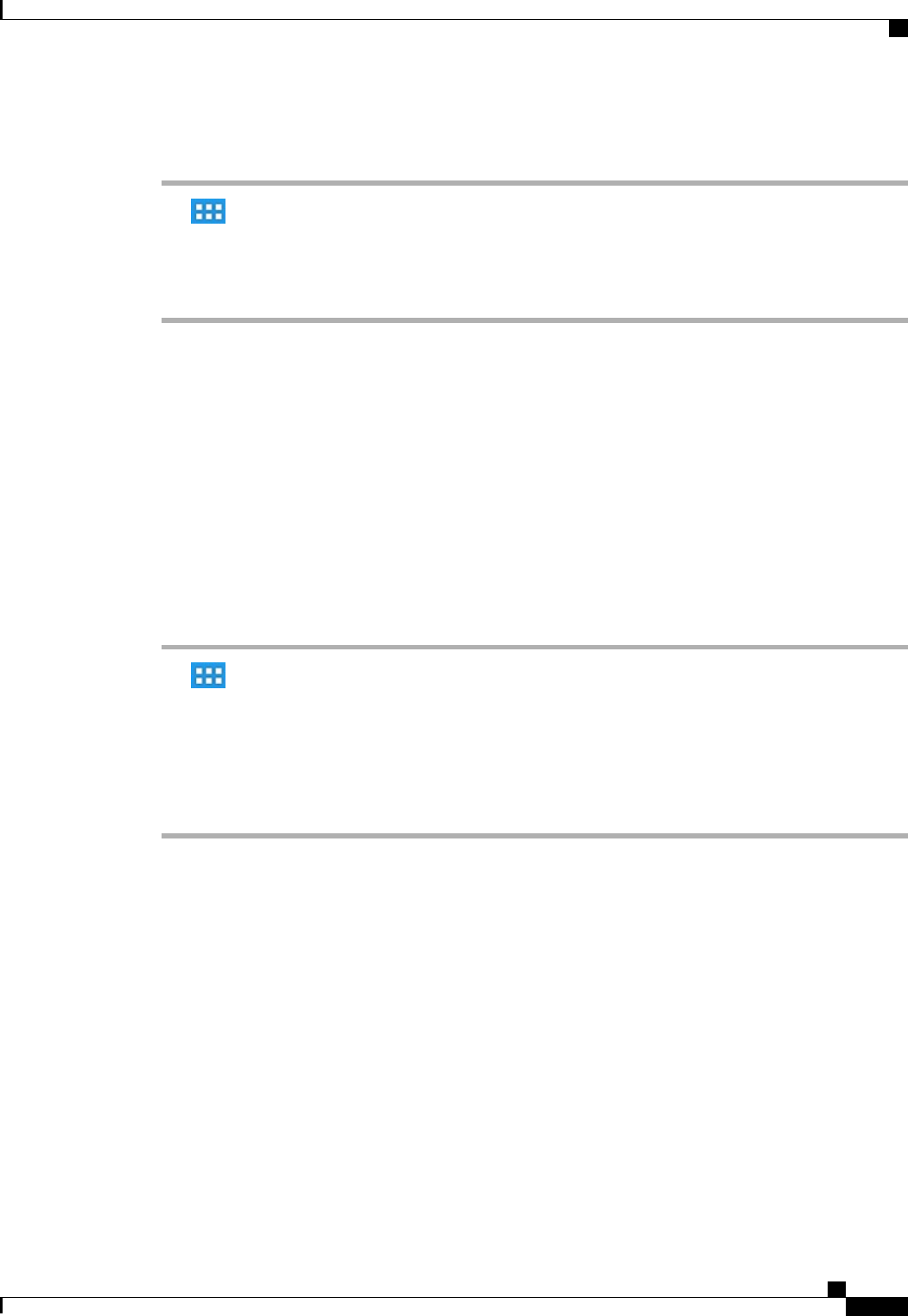
Procedure
Step 1 Tap .
Step 2 Tap Settings.
Step 3 Tap Backup & Reset.
Step 4 Tap Back Up My Data.
Problem Report Tool
Use the Cisco Collaboration Problem Report Tool to send information to your system administrator when
you experience problems with your phone or applications. You must have an email account configured on
your phone to send reports from the Problem Report Tool.
Report problem
Procedure
Step 1 Tap .
Step 2 Tap Settings.
Step 3 Tap About device.
Step 4 Tap Cisco Collaboration Problem Reporting Tool.
Step 5 Fill in each report option, and tap Create email report.
Step 6 Send the email report to your system administrator.
Accessibility features
Cisco DX650 provides accessibility features for the vision impaired, the blind, and the hearing and mobility
impaired.
Cisco Desktop Collaboration Experience DX600 Series User Guide, Release 10.0(1)
OL-28931-01 129
Product safety, security, accessibility, and related information
Problem Report Tool
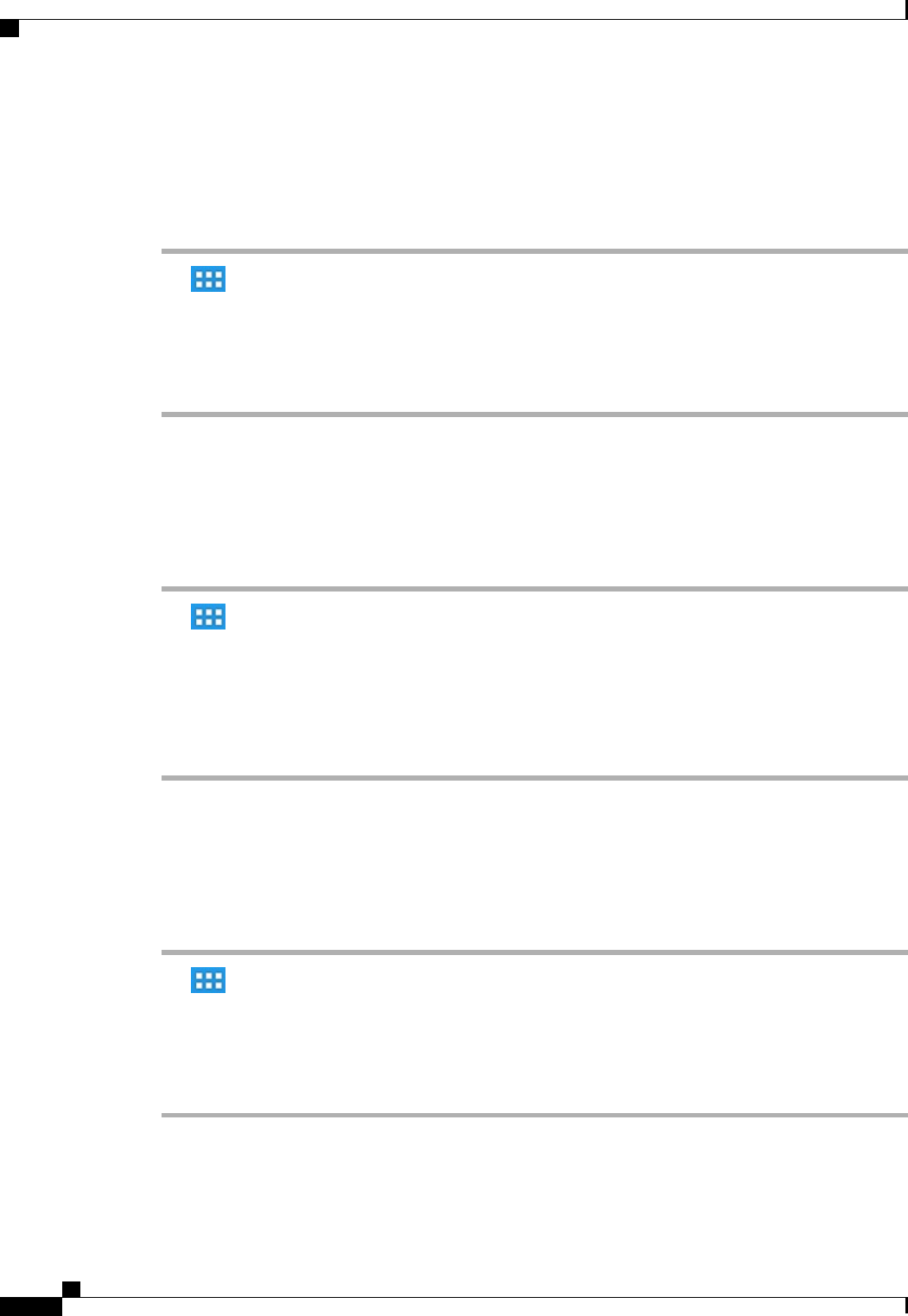
Change font size
Procedure
Step 1 Tap .
Step 2 Tap Settings.
Step 3 Tap Accessibility.
Step 4 Tap Font size.
Step 5 Select a font size.
Change screen brightness
Procedure
Step 1 Tap .
Step 2 Tap Settings.
Step 3 Tap Display.
Step 4 Tap Brightness.
Step 5 Slide the bar left to lower the brightness or right to increase the brightness.
Step 6 Tap OK.
Change touch and hold delay
Procedure
Step 1 Tap .
Step 2 Tap Settings.
Step 3 Tap Accessibility.
Step 4 Tap Touch & hold delay.
Step 5 Select a short, medium, or long delay.
Cisco Desktop Collaboration Experience DX600 Series User Guide, Release 10.0(1)
130 OL-28931-01
Product safety, security, accessibility, and related information
Change font size
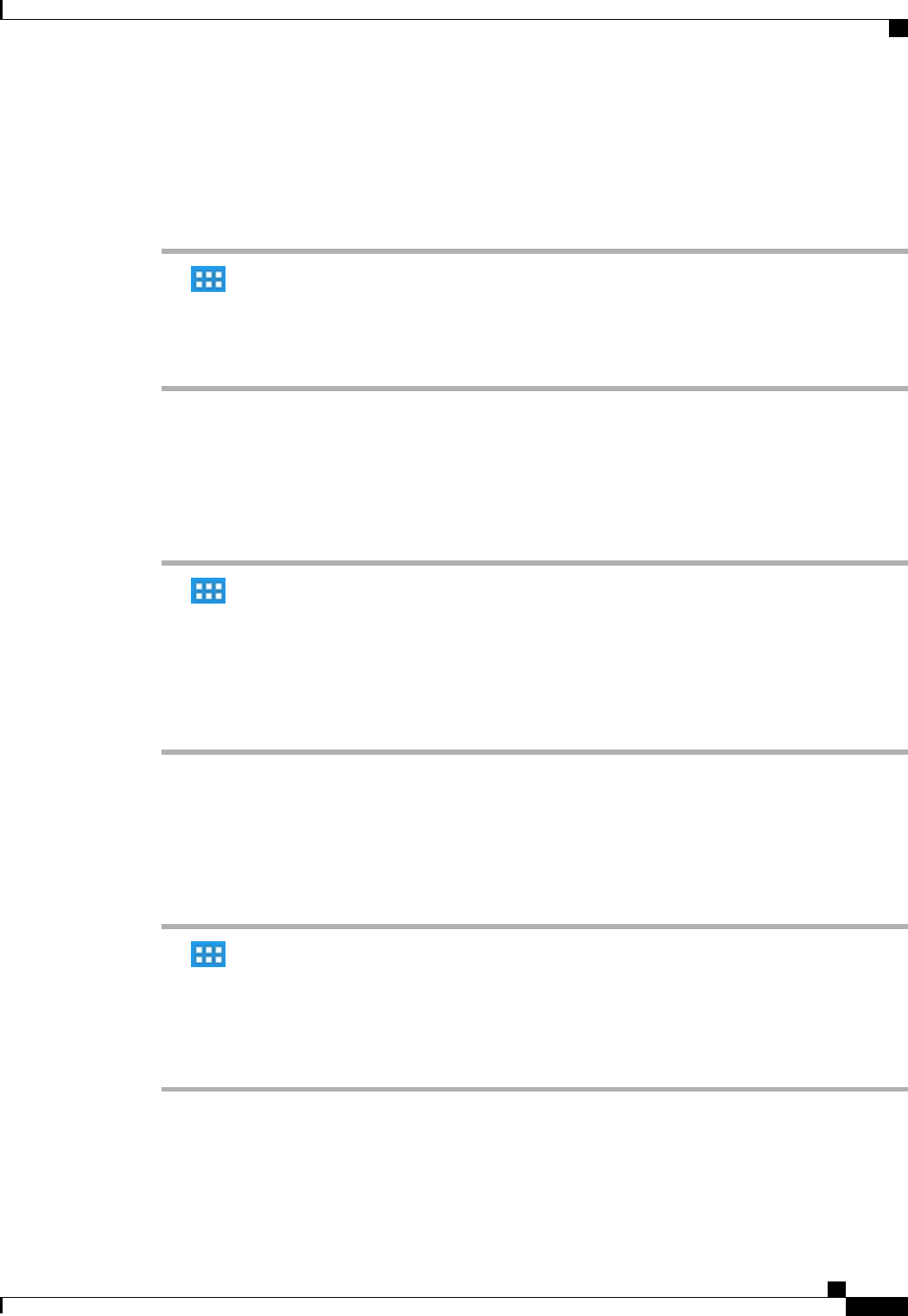
Enable spoken passwords
Procedure
Step 1 Tap .
Step 2 Tap Settings.
Step 3 Tap Accessibility.
Step 4 Check Speak passwords.
Enable TalkBack
Procedure
Step 1 Tap .
Step 2 Tap Settings.
Step 3 Tap Accessibility.
Step 4 Tap TalkBack.
Step 5 Toggle TalkBack on.
Step 6 Tap OK.
Enable web scripts
Procedure
Step 1 Tap .
Step 2 Tap Settings.
Step 3 Tap Accessibility.
Step 4 Tap Install web scripts.
Step 5 Tap Allow.
Cisco Desktop Collaboration Experience DX600 Series User Guide, Release 10.0(1)
OL-28931-01 131
Product safety, security, accessibility, and related information
Enable spoken passwords

Cisco Desktop Collaboration Experience DX600 Series User Guide, Release 10.0(1)
132 OL-28931-01
Product safety, security, accessibility, and related information
Enable web scripts
